
20 Things Parents Need To Teach Their Newborns
Welcoming a newborn into your life is one of the most beautiful and emotional journeys a parent can experience. Although newborns cannot speak or fully understand words, they are constantly learning from their surroundings. From the warmth of your touch to the tone of your voice, every interaction shapes their emotional and mental development. The lessons taught in these early days form the foundation for a child’s confidence, security, and overall well-being.
Below are 20 essential things parents should begin teaching their newborns, naturally and lovingly, right from birth.
1. Teaching Love and Emotional Security Through Gentle Care
Newborns learn love through cuddles, warmth, and affectionate care. These moments help them feel safe and deeply connected.
2. Building Trust by Responding Consistently to Their Needs
When parents respond to their babies’ cries and discomfort, they learn that they can rely on their caregivers.
3. Creating Comfort and Calm Through Touch and Physical Connection
Skin-to-skin contact and gentle massages help newborns feel relaxed and emotionally secure.
4. Helping Babies Recognize Familiar Voices Through Talking and Singing
Regularly talking and singing helps babies recognize voices and supports early language development.
5. Strengthening Emotional Bonding Through Eye Contact and Facial Expressions
Eye contact during feeding or playtime helps babies feel seen and emotionally connected.
6. Establishing a Sense of Stability Through Simple Daily Routines
Consistent routines for feeding and sleeping help newborns understand patterns and feel secure.
7. Teaching Emotional Awareness Through Calm Reactions and Expressions
Babies observe facial expressions and tone, learning how emotions are expressed and managed.
8. Demonstrating Patience During Crying and Restless Moments
Handling difficult moments calmly teaches babies that they are supported and understood.
9. Introducing a Sense of Safety Through Careful Handling and Environment
A safe, gentle environment helps babies develop trust and confidence in their surroundings.
10. Encouraging Early Communication by Listening and Responding
Responding to baby sounds shows that communication is meaningful and valued.
11. Building a Strong Sense of Self-Worth Through Smiles and Positive Attention
Positive reactions help babies feel important and emotionally valued.
12. Teaching Respect Through Gentle Touch and Kind Words
Treating babies with respect teaches them dignity and emotional safety.
13. Nurturing Curiosity by Allowing Babies to Explore Safely
Exposure to sounds, colors, and textures encourages curiosity and learning.
14. Creating a Calm and Peaceful Environment for Emotional Balance
A peaceful atmosphere supports relaxation and emotional well-being.
15. Developing Healthy Sleep Habits Through Consistent Bedtime Routines
Regular sleep routines help babies understand the importance of rest and comfort.
16. Laying the Foundation for Empathy Through Love and Affection
Showing kindness helps babies develop emotional awareness and empathy over time.
17. Surrounding Babies With Positive Energy and Encouraging Emotions
Positive interactions help babies feel happy and emotionally secure.
18. Teaching Stability and Confidence Through Consistent Care
Consistency in caregiving builds emotional confidence and trust.
19. Introducing Gratitude and Joy Through Everyday Positive Moments
Expressing happiness and thankfulness creates a positive emotional environment.
20. Teaching Unconditional Love and Lifelong Support From Day One
Above all, unconditional love gives babies the confidence to grow and thrive.
Teaching a newborn is not about books or formal lessons. It happens in everyday moments like feeding, holding, comforting, and being there for them. These small actions help shape a child’s emotions, strength, and ability to connect with others as they grow.
By showing patience, love, and care every day, parents give their newborn the most valuable gift, a strong and loving start to life.

The Ultimate Guide to the 7 7 7 Rule for Parenting
Parenting today feels harder than ever. With school stress, phones and screens, and busy family routines, it can be tough to build real connections with your children. That’s why the 7 7 7 rule for parenting is so helpful. It is a simple method that helps parents communicate better, build trust, and stay emotionally close to their kids.
Whether your child is a toddler, a preteen, or a teenager, this rule gives you an easy way to focus on bonding without feeling stressed. In this guide, we will explain what the 7 7 7 rule means, how it works, and how you can use it in your daily life at home.
What Is the 7 7 7 Rule for Parenting?
The 7 7 7 rule for parenting is a simple habit-building formula designed to help parents maintain consistent, meaningful interactions with their children. The concept is based on dedicating intentional time to connect in three intervals:
- 7 minutes every day
- 7 hours every week
- 7 days every year
These time slots aren’t rigid schedules; they are reminders to create space for communication, bonding, and shared experiences at different levels of depth.
This rule works because children feel valued not through occasional grand gestures but through consistent, small moments of attention that show they matter.
Why Does the 7 7 7 Rule Work?
Modern families are increasingly busy. While parents often want to spend quality time with their children, the lack of structure makes consistency difficult. The 7 7 7 rule for parenting solves this by giving families a simple strategy.
Here’s why it works:
It promotes consistency
Daily micro-interactions help children feel seen and heard, reducing behavioral issues and boosting emotional security.
It strengthens communication
Regular conversations build trust and encourage children to share their feelings more openly.
It reduces parental guilt
Instead of aiming for perfection or long, unrealistic bonding sessions, parents follow doable, meaningful steps.
It supports long-term relationship building
Weekly and yearly rituals create lasting memories and a sense of family identity.
How does the 7 7 7 Rule for Parenting Work?
Let’s break down each part of the rule and explore practical ways to apply it.
Minutes Every Day: Micro-Bonding Moments
These seven minutes are not about homework, chores, or instructions; they’re purely for connection.
Ideas for daily 7-minute bonding:
- Have a quick bedtime chat about the best part of their day.
- Share a joke, a story, or a mini gratitude session.
- Give them undistracted attention: no phone, no TV, no multitasking.
- Do a 7-minute activity like doodling, stretching, or a game of “Would You Rather?”
These tiny moments create emotional warmth and reduce stress for both parent and child.
Hours Every Week: Deeper Connection Time
The weekly 7 hours don’t need to happen all at once. They can be spread over the week through intentional activities.
Ideas for weekly bonding:
- Family movie night or game night.
- Cooking a meal together or going out for a treat.
- A walk, bike ride, or visit to the park.
- Attending their sports, music, or school events.
- A longer conversation on weekend mornings over breakfast.
These encourage a deeper understanding of your child’s thoughts, interests, and emotional needs.
Days Every Year: Family Break or Special Time
This doesn’t have to be an expensive vacation. It can be a staycation, road trip, or unplugged family week.
Ideas for your 7-day annual bonding:
- A family holiday to a new place.
- A camping adventure or nature retreat.
- A no-screens week dedicated to board games, cooking, and outdoor fun.
- Visiting relatives or exploring cultural traditions.
- A learning trip focused on museums, history, or nature.
Yearly rituals become core childhood memories and strengthen the parent-child relationship long-term.
Tips to Make the 7 7 7 Rule for Parenting Successful
To make the 7 7 7 rule work well, it’s important to be fully present with your child. Give them your complete attention because that’s when they feel most connected. Also, stay flexible, some days may not go as planned, and that’s okay. What matters most is being consistent, not perfect.
Every child is different, so adjust your approach based on their age and interests. Younger kids may enjoy playtime, while older ones might prefer talking or doing a shared hobby. Make your time together fun, because enjoyable moments help build long-lasting habits. And if you have more than one child, try rotating one-on-one time so each one feels valued and special.
The 7 7 7 rule for parenting is a simple yet transformative approach that helps families stay emotionally connected despite busy routines. By focusing on daily micro-moments, weekly quality time, and yearly shared experiences, parents can build stronger relationships and happier homes.

10 Traits Parents Need to Teach Their Toddlers
The toddler years are full of curiosity, surprises, and nonstop learning. Children between one and three years old pick up everything they see and hear. This makes it the best time for parents to teach important traits that will shape their child’s personality, behavior, and confidence as they grow. These early lessons don’t need to be like formal teaching. Toddlers learn best through daily routines, gentle guidance, and plenty of love. Here are 10 important traits parents can start teaching their toddlers to help them build a strong future.
Kindness
Kindness is one of the most valuable traits to teach a toddler. Simple acts such as sharing toys, helping clean up, or saying “thank you” show them how to care about others’ feelings. Toddlers naturally imitate what they see, so when parents model kindness at home, children quickly follow. Over time, these small lessons help toddlers grow into compassionate and empathetic individuals.
Patience
Waiting isn’t easy for toddlers, especially when they want something “right now.” But patience is an important skill that they can start learning early. Parents can practice this during everyday moments, waiting for a snack, taking turns during playtime, or standing in line. Using short, clear explanations like “We wait for our turn” helps toddlers understand the concept. Gradually, they learn that some things take time.
Confidence
Toddlers feel more confident when they are encouraged to try new things, even if they make mistakes. Praise their efforts, not just their success. Simple tasks such as wearing their shoes, feeding themselves, or building a tower help them feel capable and independent. A confident toddler is more open to learning, exploring, and interacting with others.
Curiosity
Curiosity drives learning. Instead of stopping toddlers from exploring, parents can guide them safely. Encourage them to ask questions, touch new textures, and observe nature. Activities like reading books, playing with sensory toys, or discovering outdoor spaces nurture their natural desire to learn. Curious children become creative thinkers as they grow older.
Respect
Respect begins with understanding boundaries, both theirs and others’. Teaching toddlers to respect personal space, follow simple rules, and treat belongings with care sets the foundation for good behavior. Parents can also teach them respectful communication by using polite language, greeting others properly, and listening when someone is talking. These habits help them build healthy relationships later in life.
Responsibility
Even toddlers can learn responsibility through small tasks. Simple activities like putting toys back after playtime, placing clothes in the laundry basket, or helping set the table teach them that actions have consequences. When toddlers feel involved in household routines, they develop a sense of pride and ownership. These early habits make them more organized and dependable as they grow.
Emotional Awareness
Toddlers experience big emotions but often don’t know how to express them. Teaching them to identify feelings, happy, sad, angry, scared—helps them understand what they are experiencing. Parents can use phrases like “I see you’re upset” or “It’s okay to feel sad” to comfort them. Guiding toddlers to express emotions in healthy ways builds emotional intelligence, which is crucial for future social and academic success.
Sharing
Sharing is challenging for many toddlers, but it is a skill that grows with practice. Encourage them to take turns during playdates or share a snack with a sibling. Use positive reinforcement when they share willingly. This teaches them cooperation, fairness, and empathy. Over time, sharing becomes a natural part of their behavior.
Problem-Solving
Toddlers are constantly learning how to handle small challenges. Whether it’s figuring out how to stack blocks or opening a container, these moments teach them problem-solving. Instead of immediately fixing problems for them, parents can guide them with hints or questions like “What else can you try?” This helps toddlers develop patience, creativity, and resilience.
Honesty
Honesty begins with simple, truthful communication. When toddlers make mistakes, parents can gently encourage them to speak the truth without fear. Creating a safe environment where they feel comfortable admitting what happened helps build trust. Teaching honesty early helps toddlers grow into trustworthy, responsible adults.
Raising toddlers is a happy and rewarding journey, with many chances to help them become strong, confident, and kind children. Teaching these traits doesn’t need extra effort, just simple, meaningful moments in daily life. When parents stay patient, show love, and behave positively, toddlers learn important qualities that will help them throughout life. Remember, toddlers learn mainly by watching you, so every small action you take teaches them something valuable.
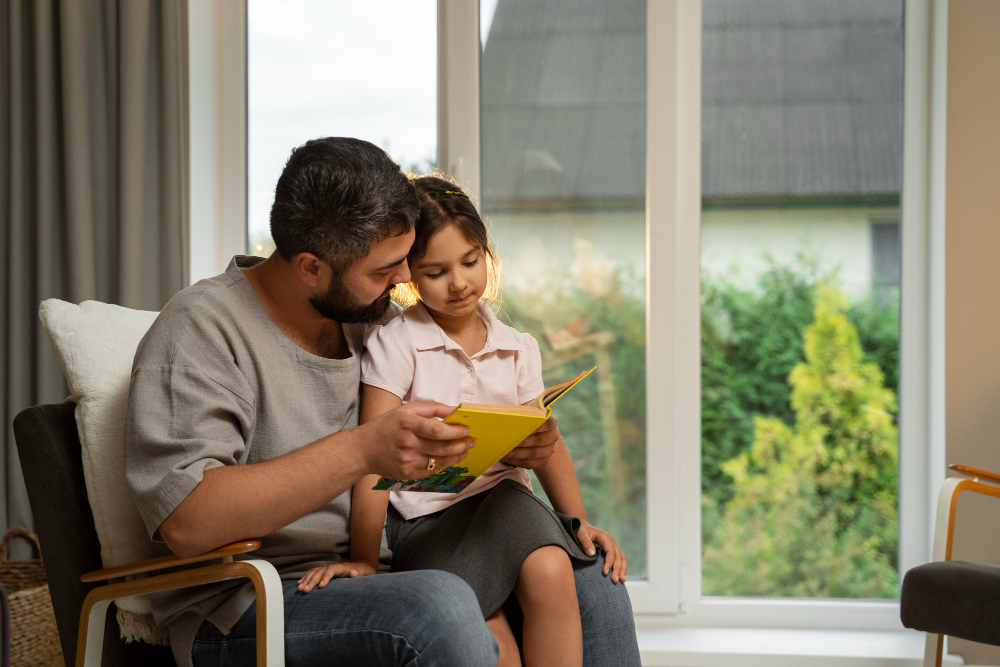
Top 10 Practical Tips for a Meaningful Life as a Parent
Parenthood is a journey filled with love, challenges, joy, and constant learning. Amid the busy schedules, responsibilities, and emotional ups and downs, every parent still seeks a meaningful life, one that feels purposeful, balanced, and deeply fulfilling. The truth is, meaning doesn’t come from perfection or dramatic milestones; it grows from small, intentional moments shared with your child and yourself.
Here are ten practical, parent-focused tips to help you lead a meaningful life every day.
Know Yourself as a Parent
Before you can guide your child, you must understand who you are. Reflect on your values, your parenting style, and what kind of environment you want to create at home. Ask yourself:
What kind of parent do I want to be? What truly matters in my family life?
Self-awareness helps you make parenting decisions aligned with your heart, not societal pressure or comparison.
Set Intentional Family Goals
Every family thrives with direction. Create goals that reflect the values you want to pass on: kindness, discipline, creativity, and connection. Instead of broad wishes like “I want a peaceful home,” set simple, actionable goals such as:
- “Spend 20 minutes of distraction-free time with my child daily.”
- “Create a Sunday family ritual.”
Small goals lead to meaningful traditions and lasting memories.
Practice Gratitude Daily (With Your Kids Too!)
Gratitude is powerful for both parents and children. Make it a habit to notice the good: your child’s laughter, a peaceful meal, a bedtime snuggle. Encourage your child to share one thing they’re grateful for each night.
Gratitude doesn’t just reduce stress; it strengthens the bond you share with your family.
Nurture Relationships, Inside and Outside Your Home
Meaningful parenting isn’t just about managing kids; it’s also about maintaining the relationships that support you.
- Build a deeper bond with your child through listening and empathy.
- Strengthen your partnership or co-parenting relationship.
- Stay connected with friends and family who uplift you.
A strong support circle makes parenting easier and more joyful.
Embrace Mindfulness in Everyday Parenting
Children grow fast, and it’s easy to miss moments when life feels rushed. Practicing mindfulness allows you to slow down and appreciate the little things: your child’s expressions, their curiosity, and their stories.
Be fully present, even if only for a few minutes. It reduces stress and fosters a deeper emotional connection.
Give Back, Teach Kindness Through Action
Children learn best by watching us. Engage in acts of kindness and involve your child when possible; help a neighbor, donate toys, share food, or support a cause.
Giving back not only fills your life with purpose but also teaches your child empathy and compassion.
Prioritize Personal Growth (For You and Your Child)
A meaningful life requires continuous growth. Read parenting books, learn new skills, or pursue hobbies you’ve paused. Encourage your child to explore, learn, and stay curious.
When you grow, your child sees that learning is a lifelong journey, and that inspires them.
Take Care of Your Body; You’re Your Child’s Safe Space
Parenting requires energy, physical, mental, and emotional. Get adequate sleep, eat well, and try to stay active. Your well-being affects your patience, mood, and ability to nurture your child.
Self-care isn’t selfish; it’s essential.
Live Authentically in Your Parenting Journey
Let go of the pressure to be the “perfect parent.” Honor your instincts. Trust your experiences. Be honest about your feelings, even with your child, when appropriate.
Authenticity builds trust and helps your child feel safe being themselves, too.
Find Joy in the Little Moments of Parenting
Meaning often hides in simple moments:
- A giggle-filled pillow fight
- A quiet bedtime story
- Cooking together
- Watching your child discover something new
These small joys matter more than big achievements. They are the moments your child will remember, and so will you.
Living a meaningful life as a parent isn’t about doing everything right; it’s about being intentional, present, and loving. By knowing yourself, nurturing relationships, prioritizing growth, and appreciating the little things, you create a home filled with purpose, joy, and connection.

The Secret to Raising Kind Kids Starts with Sharing
One of the most important lessons young children can learn is sharing. It might seem like a small thing, but for toddlers, it’s a big step toward kindness, patience, and understanding others. When children learn to share, they also learn how to play with others, make friends, and solve small problems peacefully. But teaching toddlers to share can sometimes feel tricky for parents. Let’s explore simple and effective ways to help little ones learn this valuable skill.
Why Sharing Is Hard for Toddlers?
Before teaching your child to share, it’s important to understand why toddlers struggle with sharing. At this age, children are still learning about ownership and emotions. When a toddler says, “It’s mine!” it’s not because they’re being selfish, it’s because they’re still developing a sense of self and control.
Toddlers often don’t yet understand that when they share something, they’ll get it back. They live in the moment, so giving up a toy feels like losing it forever. That’s why parents and caregivers need to patiently guide them through the process of sharing.
How to Teach Sharing to Toddlers?
Here are some simple and gentle ways to teach sharing to toddlers:
Be a role model
Children learn best by watching adults. Let your child see you sharing with others, whether it’s food, a toy, or even your time. Use simple phrases like, “I’m sharing my snack with you because sharing makes people happy.” This helps toddlers understand sharing through real-life examples.
Practice during playtime
Playtime is the perfect moment to teach sharing. Encourage your child to take turns while playing with toys, puzzles, or games. You can say, “It’s your turn now, and then it will be mine.” Using turn-taking games like rolling a ball back and forth also builds patience and sharing skills for toddlers.
Praise good behavior
When your child shares willingly, even in small ways, praise them right away. Say something like, “That was very kind of you to share your toy with your friend!” Positive words encourage children to repeat the behavior because it makes them feel proud.
Start with simple sharing
Begin by asking your child to share small or less favorite items. As they get comfortable, move on to sharing toys or things they value more. This gradual approach makes sharing less stressful.
Read books about sharing
Storybooks are a wonderful tool for teaching toddlers to share. Look for stories where characters share and solve problems together. After reading, talk about what happened in the story and ask how your child would feel if they were in that situation.
Explain feelings
Help your child understand how sharing makes others feel. For example, “When you share your toy, it makes your friend happy. When we don’t share, it can make others sad.” This helps toddlers connect emotions with actions.
Toddler Sharing Tips for Parents
Here are a few extra toddler sharing tips to make learning smoother and more fun:
- Be patient. Remember that sharing takes time to learn.
- Use group playdates to give your child more chances to practice sharing.
- Set clear rules — for example, “We take turns when playing.”
- Avoid forcing sharing — it’s better to guide and encourage rather than demand.
- Create “special toys” that your child doesn’t have to share. This teaches them boundaries and makes sharing more meaningful.
Building Strong Sharing Skills for Toddlers
Over time, with patience and positive guidance, your toddler will begin to share naturally. Sharing isn’t just about toys; it’s about kindness, empathy, and friendship. When you help your child build sharing skills, you’re teaching them how to care for others and work together.
Remember, every small act of sharing is a step toward raising a kind, thoughtful, and happy child. So, celebrate those little moments, like when your toddler offers a cookie or lets a friend play with their toy, because that’s where big lessons in kindness begin.
Teaching toddlers to share takes time, patience, and gentle practice. By modeling sharing, using playtime lessons, and giving positive encouragement, parents can help their children develop strong sharing skills for toddlers that will stay with them for life.
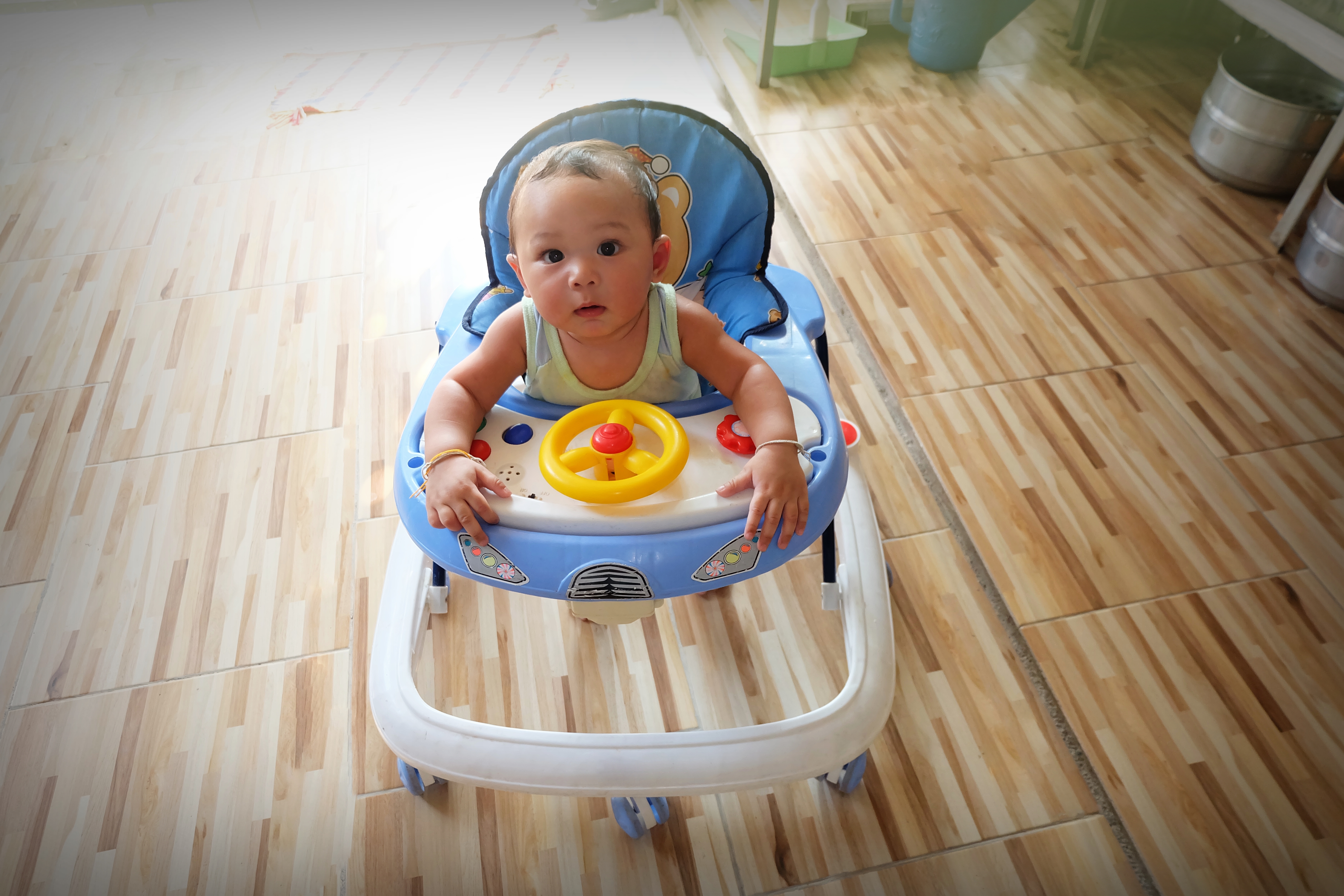
Are Baby Walkers Safe? The Pros and Cons Of Using Them
As parents, we frequently want to give our babies every possible edge to help them grow, learn, and explore the world. One typical question numerous parents ask is: “Are baby walkers safe?” Baby walkers have been around for decades. They are sort of machines that help infants learn to walk quickly while keeping them engaged. But like multiple baby products, there are both advantages and risks to consider.
In this blog, we will explore “Should I use a baby walker?” and share imperative security concerns every parent should know.
What Precisely Is a Baby Walker?
A baby walker is an instrument invented with a small seat and wheels that allows babies to move around utilizing their feet while being supported. The idea is that infants can relish mobility before they’re capable of walking alone. While it may appear generous, professionals have raised worries about the risks of baby walkers and whether they even support wholesome growth.
The Pros and Cons of Baby Walkers
Let’s start by breaking down the positives and negatives.
Pros of Baby Walkers:
Entertainment Value – Numerous walkers come with playthings, sounds, and lights that can keep infants active and cheerful.
Mobility Before Walking – Babies love digging, and walkers give them the space to move around the room.
Convenience for Parents – Walkers can give parents a short break while their baby occupies themselves.
Cons of Baby Walkers:
Safety Concerns – Walkers can tip over, roll down stairs, or allow babies to reach dangerous items.
Delayed Development – Contrary to popular belief, walkers don’t help babies walk sooner. In fact, they may slow down the development of muscles needed for crawling and walking.
Accidents and Injuries – The biggest risk of baby walkers is injury. Babies can move faster than parents expect, leading to falls or access to unsafe areas.
Risks of Baby Walkers:
While walkers may look harmless, statistics show otherwise. According to pediatric specialists, thousands of newborns are hurt each year due to walker-related mishaps. Some of the most typical risks of baby walkers include:
- Falls from stairs or steps – Walkers can move fast, and a baby can fall down before a parent has time to respond.
- Burns or injuries from reaching objects – In a walker, an infant might reach stoves, heaters, or hot beverages that they couldn’t reach otherwise.
- Tip-overs – Rough flooring or blocks can cause the walker to fall, hurting the baby.
These dangers make it obvious why security associations in some nations prevent or even prohibit the use of standard baby walkers.
Should I Use a Baby Walker?
This is the question every parent encounters after considering the pros and cons. The solution largely relies on your preferences and how much care you can provide.
If you choose to utilize one, it’s imperative to:
- Constantly watch your baby closely.
- Keep the walker out of the stairs, kitchens, and restrooms.
- Utilize it just for short periods, not as a nanny.
- Ensure the walker has safety measures, with features like an extensive base and wheel locks.
Nevertheless, numerous pediatricians suggest bypassing walkers completely. Rather, you can enable mobility and growth via safer options such as stationary activity centers, playpens, or just giving your baby supervised floor time to crawl and practice standing.
So, are baby walkers safe? The genuine response is that while they can provide joy and temporary comfort, the hazards of newborn walkers frequently overshadow the advantages. They do not help babies learn to walk quickly and can even slow motor development. Most significantly, the chance of falls and damage is substantial.
When thinking “should I use a baby walker?” consider whether the short-term comfort is worth the potential risks. Numerous parents discover safer options just as satisfying for their little ones.
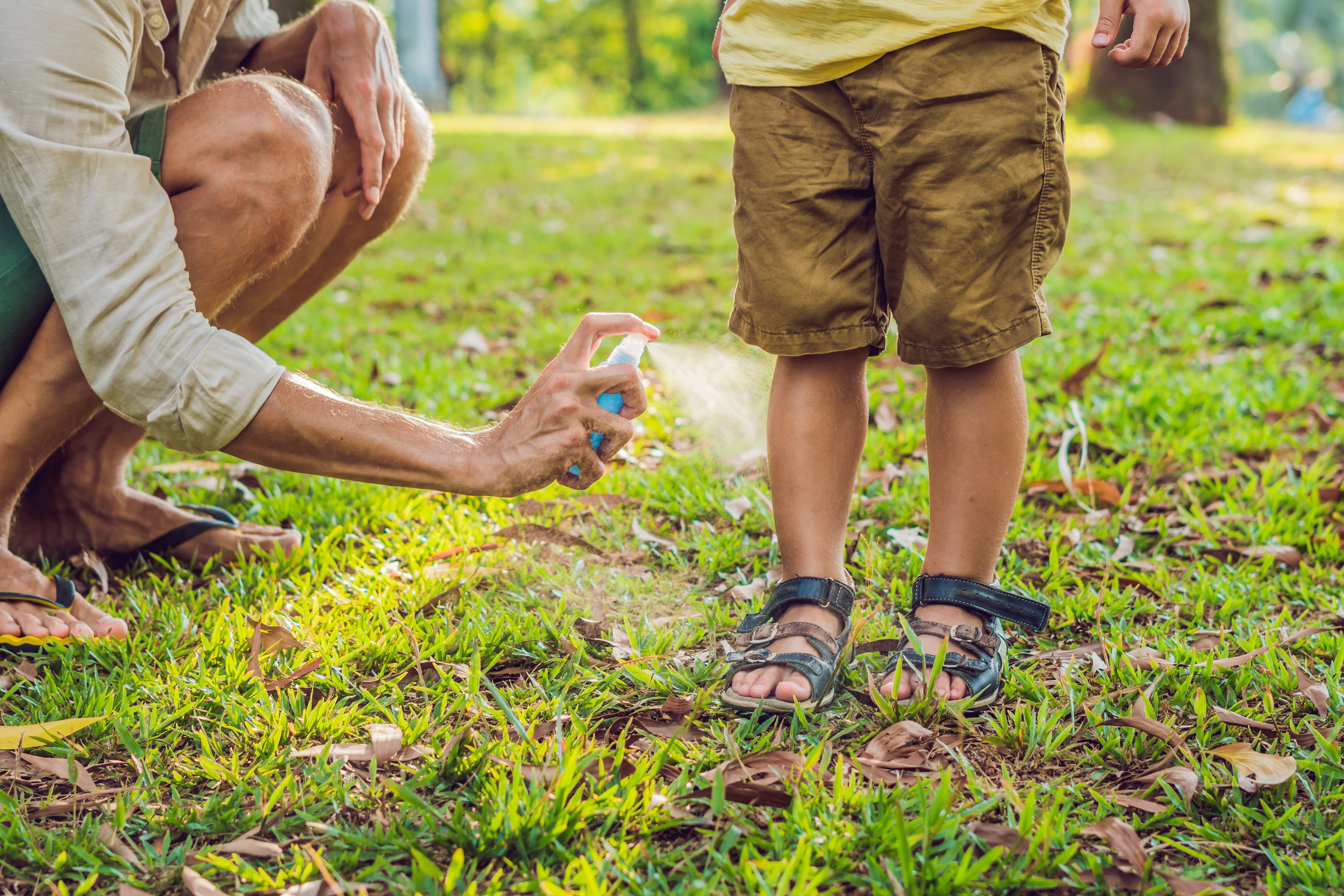
Is Bug Spray Safe for Babies? Find Out!
Newborns are among the blessed ones. As parents, it is our responsibility to ensure that they have everything essential. And one big thing is safety. There are weather conditions when mosquitoes and bugs are present in heavy amounts and disturb everyone. At that time, one thing sticks in mind. Bug sprays. But here is something! Is bug spray safe for babies? For sure, no parent wants their baby to suffer from redness and irritation in the skin due to mosquito bites, but you also do not want your baby to come in contact with the chemicals. So what should be done? Find out by reading this blog post.
Why Does Your Baby Need Protection from Bugs?
Do you like mosquitoes and other bugs murmuring or buzzing near your ear? Of course, not! With newborns, too! And yes, it is a moment that you need to think about their safety. Bugs or mosquitoes are poisonous for infants, as they may cause redness, irritation, and other allergic infections that are unsafe if bitten.
Babies are as sensitive as sponges, and the same goes for their skin. Since they are in the process of development, it becomes more difficult for them to react to mosquito bites. And that is where protection from bugs matters the most. So here is what you need to know about bug spray for babies.
Is Bug Spray Safe for Babies?
The quick answer to this is that it depends on the components and your baby’s age. For newborns beneath 2 months: Bug sprays and insect repellents are not advised. Their skin is excessively exposed, and even gentle products could scratch it. Rather, utilize physical obstacles like mosquito nets, stroller blankets, and long attire.
For infants older than 2 months: Some repellents can be used safely, but you should choose carefully. Anyhow, review tags and look for baby-specific formulas or baby-safe mosquito repellents.
Ingredients to Look Out For
When it comes to insect repellents for infants, the components make all the disparity. Here are some things you should know:
DEET: Common in grown-up bug sprays, DEET is useful but powerful. Pediatric specialists usually regard concentrations of 10–30% DEET as safe for kids over 2 months, but numerous parents choose to bypass it due to worries about long-term vulnerability.
Picaridin: A more delicate option that operates well against mosquitoes. Frequently advised for kids because it’s less likely to scratch sensitive skin.
Oil of Lemon Eucalyptus (OLE): Natural and adequate, but not suggested for kids under 3 years.
Essential oils: Seen in considerable natural bug sprays for babies. While more uncontroversial, they may not last as long as chemical repellents, so you’ll need to reapply more frequently.
Baby-Safe Alternatives to Bug Spray
If you’re anxious about chemicals, don’t fear, there are a bunch of safe alternatives.
Natural Bug Spray for Babies: Made with plant-based components, these sprays offer mild defense without severe chemicals. Consistently do a patch test, preferably to inspect for any skin reaction.
Clothing matters the most: Outfit your newborn in smooth, breathable, long-sleeved costumes. Mosquitoes have a more formidable time biting through textiles.
Mosquito Nets and Covers: Use them on strollers, cribs, or playpens, especially at night.
Outdoor Play Time: Sidestep going out when mosquitoes are most vibrant (early morning and evening).
Keep the Area Clean: Empty any unnecessary standing water where mosquitoes can reproduce.
After reading this, we hope you now have a clearer idea about whether bug spray is safe for babies. Always choose a product that is right for your newborn, because your baby’s safety is in your hands.
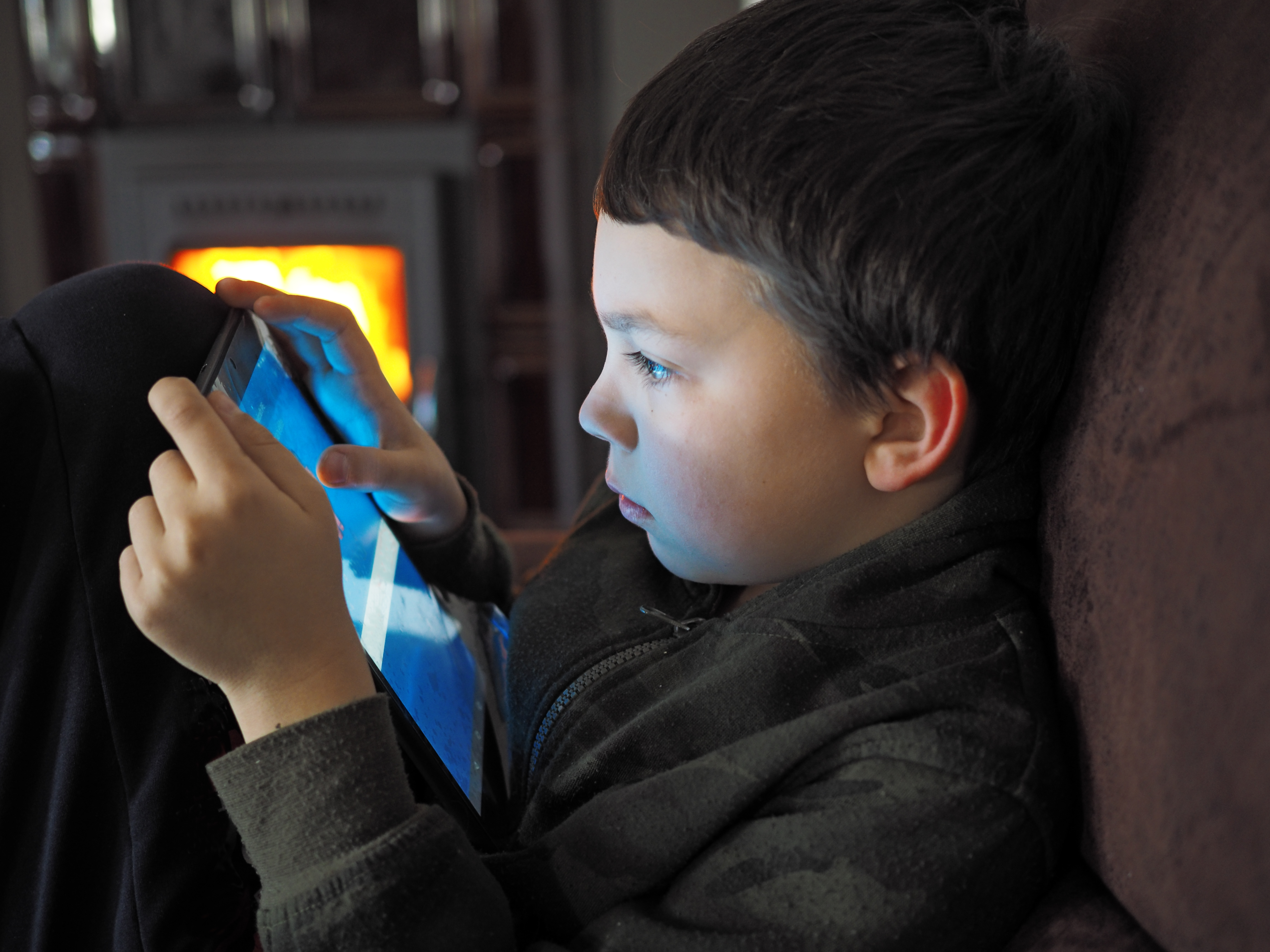
How To Keep Your Kid Away From Smartphones
Nowadays, everyone knows how to operate a mobile phone. In short, they have a part of our lives, especially for the children. Mobile phone addiction in children can lead to a range of situations, including reduced concentration span, sleep deprivation, and reduced social interaction. As a parent, it is vital to take action to control mobile addiction in your kids.
Here are some tips on how to keep your child away from mobile phones.
Parental monitoring
Parental monitoring is the foremost measure in controlling phone habits. Various apps can monitor a child’s phone usage time and content, such as setting everyday use boundaries or restricting the websites they see. This permits parents to detect whether their kids are addicted to their phones and understand their use practices, controlling possible losses from accessing virus-infected or dishonest content.
Maintain a strict smartphone schedule
Setting fair time limits permits parents to keep track and restrict the amount of time spent on gadgets and avoid excessive usage of smartphones. By orienting a plan, parents can enrich the routines that limit the child’s spending time on screen. Smartphones have now evolved into an intimate part of our lives, and it is tough to keep them out of kids’ lives. Thus, make your kid understand that he/she can utilize your smartphone only for a limited time.
Set a good example
Children learn by example, so you must have a wholesome connection with your phone. If they see you often glued to your smartphone, they’ll believe it’s standard and do the same.
Make a concerted effort to cut out reliable screen-free time for the whole household. Even reasonably, get outdoors for a walk somewhere green. Fresh air and movement will bring tremendous health advantages and help everyone sleep better.
Take away their phone at night
Don’t let your children use their mobile phones at night beyond a certain time. If you find them staring at the screen late at night or while having dinner, it’s time to take things under your control. You must consider taking away access at bedtime. This may help them have better and healthier sleep, which is necessary to perform best in school and other activities.
Opt for the landline
Many times, it so happens that those with whom you are speaking may request you to let your child speak to them. Politely tell such callers that you will call them back from your landline phone and hand it over to your child to speak to them.
Involve your child in creative works
If you involve your kids in creative activities, they might get distracted, making them stay away from mobiles. You can give them various tasks that help build up their mind, and it is essential for the child’s healthier growth.
The mobile phone makes kids mentally fragile and suppresses their inventiveness and thought. Parents should involve their child in creativity, for instance, artwork, swimming, graphic design, gardening, creating stories, reading storybooks and articles, and playing different indoor and outdoor games without introducing a mobile in the beginning.
If you’re wondering how to keep your child away from mobile phones, begin by specifying precise limitations and sticking to them always. Use tools to restrict screen time automatically, and propose fun offline options like board games, outdoor activities, or family outings. Open talks about screen use can likewise help your child understand why offset matters.

When Do Babies Start Babbling? A Milestone Guide for Parents
We celebrate and cherish every moment in a kid’s growth journey, from a baby’s first smile to those teetering steps. One of the truly fascinating occasions in the first early milestone of becoming a conversationalist is the initial baby babbling milestones. It marks the birth of communication skills and offers a fleeting insight into the world of speech evolution. So this blog post explores when babies start babbling and speech development.
When Do Babies Start Babbling?
Babies are special, and baby babbling milestones can be widely different from one infant to another. However, regarding babbling, there is a general time frame followed by most babies.
Around 6 Months
The opening to babbling sounds generally begins at around 6 months. At this point, you may notice your child making repetitive sounds such as “ba-ba,” “ma-ma,” or “da-da.” These sounds sometimes may be interpreted by a baby as experimental sounds formed with the use of their vocal cords and mouth muscles.
7 to 11 Months
The more in-depth the ambiance of your newborn, the complex the baby babbling. Involved and mixed sounds are in the air for the 7-month-old and 11-month-old infants. Somewhere in between, baby babbling manages to evolve as intentional and can actually enclose sounds belonging to additional languages, implying that babies have a remarkable capacity to mimic the sounds they hear near them.
12 Months and Beyond
By the first birthday, your baby should be producing something relatively immediate to speech via babbling. Those infants can begin uttering a few easy words, such as the aforesaid “mama” and “dada” with a precise intention, though, early on, the words might not consistently be utilized in the appropriate context.
The Science Behind Baby Babble
An early meaningful phase in speech development for babies is babbling, and it performs several essential functions:
Exploration
It lets babies probe the range of voices their vocal cords can create. This is their form of testing with their voice, just like they experiment with the world near them by touching or tasting.
Communication
Before, babbling might not have stood for anything, but that is communication nevertheless. Babies will babble to draw your awareness, convey excitement, or exclusively engage with you and the world near them.
Language or Baby Speech Development
Babbling is the basis from which language skills are formed. It helps babies attain the native language intonation and rhythm. Babbling helps children develop some form of name-object correspondence. They might associate a particular sound with an object, action, or person, which would be important at the time of language acquisition.
Social Interaction
Baby babbling is not only almost making noise; it is a method for infants to socially interact. The better you express with your baby when they babble, smile back, speak to them, or gesture, the more they will learn that their sounds can influence their surroundings.
Babbling is an excellent and extremely significant measure in baby speech development. While there are various periods for obtaining this phase in each case, most start the act of babbling at about 6 months, slowly advancing to more intricate ways of communication as time goes on. As parents, it is up to us to foster this development by delivering an atmosphere for our little ones that uplifts their exploration of vocabulary.
So, love these baby babbling moments as they will serve as the groundwork for lovely chatters.

11 Life Skills To Teach Your Kid Before Age 10
We parents naturally put academics and extracurricular activities, like reading, sports, and music lessons, on top. But there may be one more elevated emphasis that gets neglected – life skills for kids. These are priceless lessons that help children feel certain, self-dependent, and responsible.
Developing imperative life skills is not rocket science for children. Most of these lessons can be taught through routine household activities. The following 11 skills are important for every child to learn by the age of 10:
1. Primary Cooking and Food Prep
Young kids can learn easy things like making a sandwich, peeling a banana, or making salad. More significantly, it teaches commitment, security, and freedom, a favorably rewarding skill for any kid to know.
2. Tying Shoelaces
It may appear to be insignificant, but tying shoelaces introduces children to tolerance and motor skills. It gives a person a sensation of pride and confidence each time they carry on alone.
3. Maintaining a Clean Environment
For the kids to develop commitment and evolve organized, they should be taught to clean up after playtime, put away their dishes, or make their bed. These life skills for kids under 10 are the basis for organizing their space and being thoughtful of shared spaces.
4. Using Manners and Polite Words
Please, thank you, excuse me, all words and phrases you will always want to hear from a good soul. Courtesy sets the path for a good social life and acts as a foundation for kindness in the early years.
5. Organizational Skills
Special watches or timers allow kids to develop an awareness of habits and become adept at managing their own time for small tasks, like brushing their teeth before cleaning up, or doing an assignment before playtime. It is a phase toward commitment.
6. Money Basics
Knowing the importance of money, saving it in a piggy bank, or understanding wise spending are necessary measures in life for a child. Let them buy something with their own funds once in a while to see how their preferences count.
7. Personal Hygiene
Bathing, cleaning hands after eating, and before, are some of the things that are fundamental for a child to learn at a young age. In this way, they can remain wholesome and feel incredible about themselves when they are near others.
8. First Aid Details
A child needs to understand the basics of first aid. For instance, what to do when he/she get a cut and more. Small crises may require them to learn how to put on a bandage or when to alert an adult.
9. Living Safely at Home and Outdoors
It is meaningful for kids to learn security practices like not speaking to strangers, shutting the gate at home by themselves, and dialing emergency numbers when confronted with real-life situations. Such life skills for children under 10 can protect them in times of necessity.
10. Decision Making
Enable children to make conclusions on very little things, such as what to wear, which textbook to read, or which snack to have. This approach builds trust and inspires kids to think about what they are accomplishing.
11. Problem-Solving Skills
Whether it is a puzzle, a major dispute with a friend, or trying to work out how to fix a toy, problem-solving is arguably one of the most influential things a child can learn. It empowers children to be intellectuals and doers.
Familiarizing kids with these 11 life skills before they reach their 10 frames not solely for the academy but for life as well. It encourages them to stand tall, secure in their capabilities, and professional at facing challenges, lending a hand to others, or simply taking care of themselves.
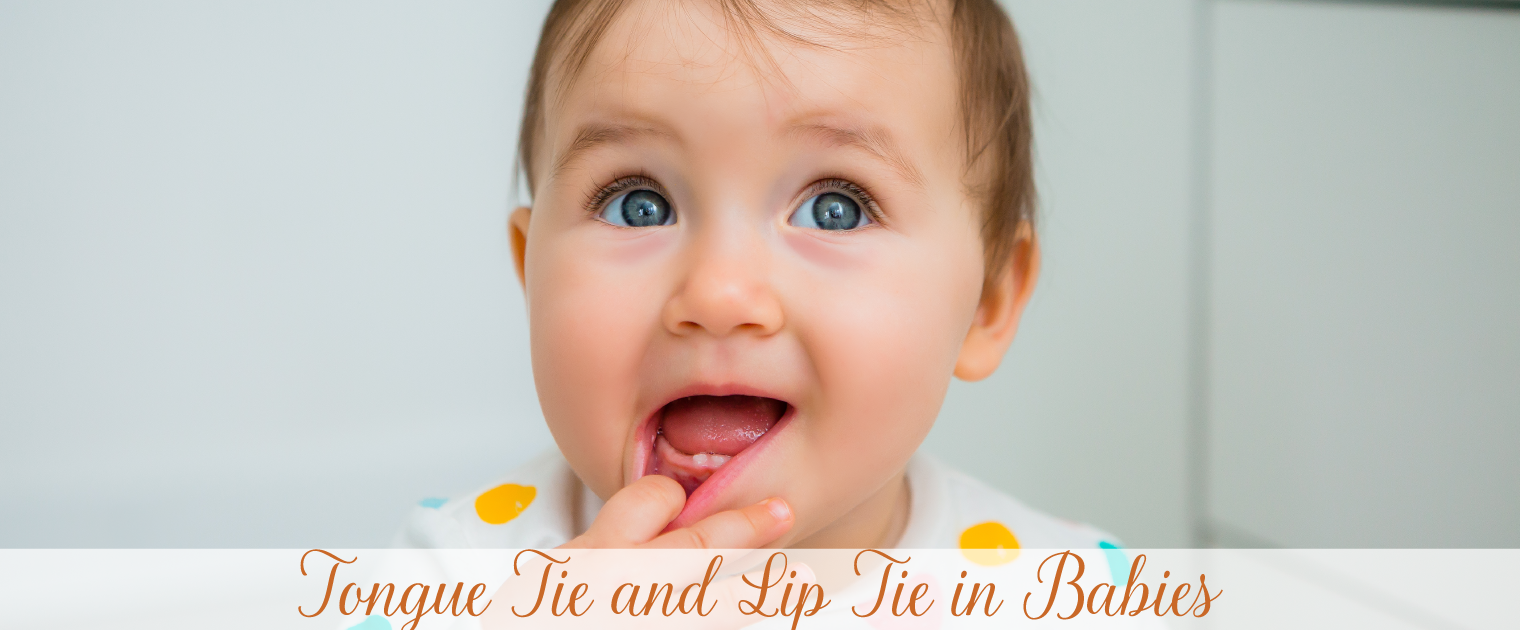
Top 5 Signs of Tongue Tie and Lip Tie in Babies
If your newborn is facing troubles feeding, napping, or gaining weight, it can be actually stressful trying to figure out why. Sometimes, the problem is precisely there in the mouth, but easy to neglect.
Lip and tongue ties in babies are typical situations where a small piece of tissue in the mouth is too close. This can make it difficult for your baby to breastfeed or bottle-feed adequately. Numerous parents don’t discover how common this is, but spotting it before can indeed help your infant feel more relaxed and develop pleasantly.
So, how do you know if your baby has signs of tongue tie and lip tie?
Breastfeeding Difficulties
Breastfeeding should feel comfy. It might feel weird, but it shouldn’t hurt. If you’re feeling pain, it could indicate your baby isn’t latching on the right way.
Sometimes lip or tongue ties in babies can’t latch appropriately. They might pull too challenging or even chew on your nipple to try and get more milk, which can be truly heartbreaking.
Along with the pain throughout feeding, lip and tongue ties in babies can furthermore cause sore or broken nipples that keep breaking even after you’re done nursing. And if your infant isn’t feeding well, it can lead to other situations like inflated breasts, plugged milk ducts, or even conditions like mastitis.
Digestive Problems
Latching can seem hard if there is a tongue tie or lip tie in babies. Because of this, they often consume a lot of air, which can lead to gas, lots of spit-up, and indications that emerge as reflux.
Gaining Weight Too Quickly
Most babies lose up to 10% of their birth weight during the first few days of life. Usually, they gain this weight back within two weeks of birth.
Is your baby still under that influence?
Having your baby weighed at the pediatrician’s office can help you decide if they are gaining weight as they should. The trouble may be due to a lip and tongue tie of your baby that limits nutritional intake.
Oral Movement Difficulties or Noisy Breathing
Sometimes, you might witness your baby can’t move their tongue very well, like they can’t stick it out or lift it smoothly. Some parents likewise hear their infant breathing loudly while sleeping, which might be induced by the tongue not sitting in the correct position. These things might not appear like a giant deal, but they could be signs of tongue tie and lip tie that your baby requires to be inspected by a physician.
Speech Development Delays
Occasionally, tongue tie or lip tie in babies doesn’t cause trouble right away, but shows up afterward when your kid starts talking. Kids with untreated tongue-tie might have difficulty saying foolproof sounds like “d,” “l,” “r,” “s,” “t,” “th,” and “z.”
If your kid keeps having speech problems as they grow, it’s a good idea to talk to a pediatrician. Tongue-tie could be one of the reasons for it.
Ultimately, if you notice a few signs of tongue tie and lip ties in infants, consider seeking help. Reach out to a professional medical practitioner right away.

7 Warning Signs Your Child Has a Toxic Friend
When it comes to children, parents should ensure everything connected to their lives is running smoothly. But sometimes, parents just concentrate on their kids’ grades and health, which is a huge blunder. Parents must show concern about how their kids feel emotionally and how good their social life is. Friends are a kid’s world, yet some friendships may be toxic rather than generous. This blog post talks about how a toxic friendship might be identified. Also, we will provide you with some parenting advice for toxic friends, so you can cope with the present situation.
Your Child Has a Friend Who Upsets Them Frequently
When your child comes home frequently sad, anxious, or angry after spending time with someone, take notice. There are periods when children argue; however, repeated instances of emotional distress can be a red flag. The typical toxic friend is somebody who makes others feel less worthy, left out, or manipulated. Recognizing this early is built into any parents guide to toxic friendships.
Does Not Respect the Rules
If your child has a friend who doesn’t respect rules, be it yours or that of their parents, there is a chance that the child might be a bad influence. A friend who refuses to come over because your home has rules is indicating that he/she does not like boundaries or being told what to do.
That sort of friend could try to get your child to breach your rules or to think that rules are not important; they could even talk back to adults or act as if no one has any right to tell them what to do. When a friend normally disregards rules and chooses chaos, it can have that impact on your child, which is unhealthy behavior. This is one of those key indicators of friendships that a parent ought to watch for.
Regular Teasing or Sensations of Worthlessness
Tiny joking here and there is acceptable among friends. But if your child is frequently being severely bullied or demeaned, that is simply not right. Toxic friends usually disguise open criticism or savagery as “just joking,” while this goes on, gradually degrading the kid’s self-worth.
Absent Two-Way Friendships
Mutual regard, empathy, and effort are the origins of wholesome relations. If your kid is consistently the one making plans, giving presents, or apologizing for things behind arguments, it might be a one-sided relationship. A toxic friend simply takes and never gives in return.
Unkindness
Observe how your child acts or feels after spending some time with a friend. If they seem unhappy, bitter, or doubtful about themselves, that could be a red flag. Some friendships are certainly just toxic, whether the friend is putting your child down, copying their concepts, or declining to praise their accomplishments; that is inappropriate.
Children have to be taught the difference between criticism and just being nasty. Just like anyone else, good friends do sometimes offer constructive feedback. However, if the feedback comes in the form of incessant teasing, derogatory remarks, and anything that makes a child feel insignificant, that is a toxic friendship.
They Don’t Feel Free to Speak Up
Every friendship should be a safe space. If your child is scared or uneasy about communicating their feelings to a particular friend, then that’s an unhealthy setup. Kids should never feel as if they have to “walk on eggshells” for another person’s happiness.
Change Is Pressured upon Them
Is your child suddenly acting very differently, changing their appearance, interests, or behavior just to groove with a friend? Kids do grow and evolve naturally, but when such changes occur due to peer pressure and incite an uncomfortable or extreme situation, it should be identified as a toxic one.
Parenting Advice for Toxic Friends
When you raise a child, you show them how to live. Among the greatest offerings you can set up for your child is his or her ability to set boundaries.
Setting limitations is not always bad, it actually works. Kids today are observing everything in their surroundings, so it has become imperative for parents to do so. To create a balanced and joyful environment for the kids, parents should teach them through daily life moments.
The relationships you have to teach your children how to choose their own. Set an example for them that is strong, loving, and respectful of themselves.
Every youngster must discover fellowships that encourage their blossoming rather than be violent toward it. Uncovering the aspects of a toxic friendship can equip your child to choose wholesome relationships that promote their well-being and happiness. If you’re after parenting tips about toxic friends, parenting advice to toxic friendships, or looking to identify friendship red flags for parents, staying engaged and observant can be the driving force after your kid’s success.

Top 10 Easy Life Hacks for Gen Z Parents
Keeping up with the fast-paced lifestyles and prompt transformations is a challenge for parents everywhere. As Gen Z parents, they are young, tech-savvy, and enthusiastic, but they likewise encounter many issues. Typically, Gen Z parents have a social life, and Gen Z parenting is all being juggled at once with some difficulty. But do not worry! Here are 10 easy life tips for Gen Z parents.
Start with Screen Time Rules
This is everywhere, and kids love screens. According to most specialists, however, too much screen time is not good. Set clear limits on screen time for your child using a phone, tablet, or television. One may even install applications that help you restrict screen time. As a result, kids remain active, protecting their eyes and minds.
Meal Prep Saves Time
Cooking may be tiring daily. Meal preparation on the weekend helps. Prepare some simple meals and refrigerate them. This way, on busy weekdays, you save time and make sure your family gets some good food. And it saves you a little money that you might otherwise spend on last-minute take-out.
Practice Gentle Parenting
Notorious in the Gen Z era, positive parenting highly embraces a style of gentle parenting: be kind, patient, and listen to the kid’s emotions. Don’t yell or punish. Talk to your child calmly; doing so sows trust and forms a strong bond with them.
Make Time for Yourself
Gen Z parenting is a full-time gig. But do not forget to pamper yourself. Take a small break, pursue a hobby, or sit around sipping wine. A happy parent can raise a happy child. Self-care is not selfish!
Make Use of Technology Smartly
Are you a Gen Z parent who is good at gadgets? If so, make adequate use of them in your real life. Numerous parenting apps will help with schedules, baby monitoring, learning activities, and even bedtime stories. Rest assured, the technology can ease your Gen Z parenting, instead of making it harder.
Stay Flexible
At times, things change, there may be times when your kid throws a tantrum, and surprises follow. So be flexible with your plans and don’t sweat over insignificant problems. Just go with it and try to discover some easy solutions. Being flexible lowers stress for both you and your kids.
Create fun family traditions
Simple family traditions create beautiful memories. Maybe it’s a movie night every Friday, a picnic on Sunday, or making cookies together. Those little habits bring joy to the whole family. Your kids will carry those memories with them forever.
Talk Mental Health
Gen Z parents get that mental health matters. Have conversations about feelings with your kids. Let them know that being sad, angry, or scared is okay. Be their safe space. Also, keep good mental health. Get help if you need it.
Celebrate Small Wins
Parenting is about winning, not being perfect. Celebrate little wins- whether that means your child saying his first word or eating some veggies, or just rolling into bed on time. Those little successes are special and keep you motivated.

As Gen Z parents, raising happy, kind, and smart children brings its challenges and opportunities. You do not have to subscribe to every parenting book; you do not have to be perfect. Just show up, be patient, and enjoy the journey.
Parenting is perhaps a learning process, and it’s okay to make mistakes. Always remember: You are doing great! Besides, if you need Gen Z parenting help, Parents Arena is always there with the right Parenting Support and approach. If you have any questions, you can contact us at any time!
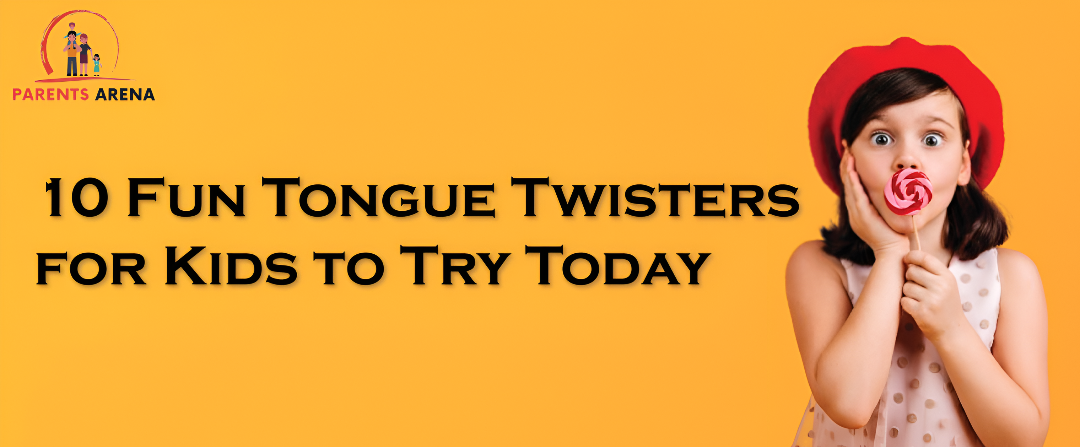
10 Fun Tongue Twisters for Kids to Try Today
What better way to practice pronunciation and language skills than to laugh? Tongue twisters for kids are very short phrases or sentences, distressingly problematic to pronounce fast because of very similar sounds. Whether a beginner or an expert, tongue twisters can make learning fun and challenging. Here are 10 fun tongue twisters for kids to try today!
Betty and Bob Brought Back Blue Balloons from the Big Bazaar
This one is filled with plenty of “b” sounds, making it great for practicing the “b” sound. Say it quickly: “Betty and Bob brought back blue balloons from the big bazaar.” Can you say it without jumbled words?
Fred Fed Ted Bread and Ted Fed Fred Bread
Here’s another one that uses repetition to make it tricky. “Fred fed Ted bread and Ted fed Fred bread.” The challenge is keeping the “Fred” and “Ted” parts clear while saying it fast. Try repeating it faster and see if you can master it!
Really Leery, Rarely Larry
This short but tricky tongue twister will have your mouth working hard. “Really leery, rarely Larry” uses the “r” and “l” sounds to keep you on your toes. Try saying it quickly and see if you can keep the words clear without tripping up!
Scissors Sizzle, Thistles Sizzle
This is an exercise for your “s” and “th” sounds along with the tongue twister: “Scissors sizzle, thistles sizzle.” It won’t be easy switching from the “s” sound to the “th” sound as you attempt to say it. Each time, say it a bit faster- it’s really hard!
Kitty Caught the Kitten in the Kitchen
Here’s one that will test your “k” sounds. “Kitty caught the kitten in the kitchen” is a great tongue twister to say fast. The repetition of “k” will have you practicing your consonant sounds and perfecting your speech!
Clean Clams Crammed in Clean Cans
This one is best for practicing your “c” sounds. “Clean clams crammed in clean cans” seems like an easy tongue twister, but it gets difficult when you try to say it at a rapid pace. Say it a couple of times and see how fast you can go.
Five Frantic Frogs Fled from Fifty Fierce Fishes
This one is a real mouthful! “Five frantic frogs fled from fifty fierce fishes” uses a lot of “f” sounds, making it difficult to say quickly. But with practice, you’ll be able to say it faster and clearly!
Wayne Went to Wales to Watch Walruses
This tongue twister is a fun one for animal lovers! “Wayne went to Wales to watch walruses” challenges you to repeat the “w” sound quickly. Try saying it several times without getting tangled up in the “w” words!
Six Sleek Swans Swam Swiftly Southwards
Here’s one to practice your “s” sounds. “Six sleek swans swam swiftly southwards” is a great tongue twister for working on pronunciation and speed. The “s” sounds are tricky to say quickly, but with practice, you can master them!
The Great Greek Grape Growers Grow Great Greek Grapes
This tongue twister is perfect for practicing your “g” sounds. “The great Greek grape growers grow great Greek grapes” uses repetition of the “g” sound to make it tricky. Try speaking it as swiftly as you can without messing up.
Tongue Twisters for Kids: What Makes Them Good?
Tongue twisters aren’t just entertaining, they likewise assist children understand speech pleasantly. When kids say tongue twisters, they enhance how they say words and sounds. This aids with precise speaking and more satisfactory reading.
Tongue twisters for kids even help them strengthen their jaw muscles and enhance their pronunciation. It’s an amusing way to practice speaking, obviously.
Try these 10 fun tongue twisters for kids! They can help them sweeten their vocabulary while having a terrific time vying with friends or even with themselves. See how fast you can say them without getting jumbled up! Besides this, we offer Parenting Support programs to help new parents with their kids’ development.
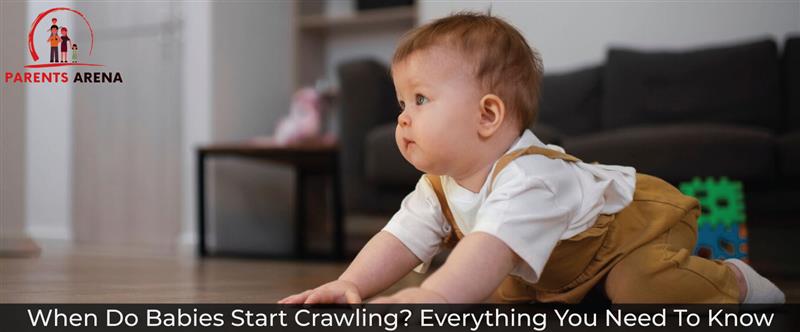
When Do Babies Start Crawling? Everything You Need To Know
One of the most delightful things in the world is to see your baby growing. Observing them from birth to their crawling period is even more exciting. At this stage, numerous parents wonder, When do babies start crawling? And what will happen next? So this blog here brings you everything you need to know about crawling and more. Get ready to explore!
Is there a precise age when babies begin to crawl?
Commonly, babies crawl when they are six to ten months old, but there are consistent exceptions. Some babies crawl earlier than others; some crawl later than others. The essential thing to recall is that there is no “respectable” time for crawling.
Indications That Baby Crawling Is On The Way
If you’re wondering when do babies start to crawl, it enables you to look for some premature indications. Explore them:
- Pushing up on their arms during tummy time
- Rocking back and forth on hands and knees
- Scooting backward instead of forward
- Trying to reach for toys just out of their grasp
These are all good signs that crawling is on the way.
Different Ways Babies Crawl
Not all babies crawl the same way. Some common types of crawling include:
- Traditional crawling: Moving forward on hands and knees.
- Army crawling: Dragging their body across the floor using their arms.
- Bear crawling: Moving on hands and feet with the knees off the ground.
- Scooting: Moving while sitting and pushing with their arms or legs.
There is a movement that might be called crawling at first, but all this is just part of learning how to move. In case you were wondering when babies start crawling in the ‘normal’ way, any form of movement is normal at the beginning!
Crawling is typically followed by:
After they discover how to crawl, babies become more self-reliant. They adore digging into their surroundings, and that indicates it’s a moment to baby-proof the place.
Keep objects that can induce trouble, hide sharp corners, and block staircases.
From here it’s usually on to:
Pulling up to standing: After crawling a bit, the majority of babies will try and stand up by pulling up on something.
Cruising: Holding furniture and walking along it.
Standing unaided: First for a moment and then for longer.
Walking: Most newborns will stroll by their foremost birthday, but it might be before or after that.
In particular, when you believe that when do baby start crawling, it is so exciting that crawling comes with even more significant junctures like standing and walking forth along the path.
How can you help your baby crawl?
Here are some straightforward movements that can help your infant wriggle:
Tummy time: Secure that your newborn spends most of the time on their tummy when awake, as this creates resilience in the neck, arms, and core muscles.
Spot toys out of reach: Always inspire your baby to move toward them. Cheer them with clapping, smiling, and motivation for every small action.
Open up space: Giving your baby space in a secure, open area allows them room to practice the movement.
If you want to know when do babies begin to crawl and feel like your baby is taking too long, fret not much because some babies skip crawling altogether and walk or stand between six to twelve months.
When to Consider Talking to a Doctor
When should you consult a doctor regarding a baby who has not crawled? When: 12 months. Signs include stiff or floppy muscles and using only one side of the body. These are all scenarios that would draw the attention of a doctor, who could determine if anything is wrong and offer any pertinent suggestions concerning exercises or therapies.
Some infants may crawl prematurely, others may crawl moderately belatedly, and still others may not crawl at all. Whenever this query arrives, it has constantly been a typical concern for numerous parents. Therefore, there is no point in comparing or rushing the baby. What is important is that the baby crawls around somewhere around 6 months or as late as 10 months. Or even if it decides that crawling is simply not its thing: the important thing is that it learns and explores its world.

So just celebrate every little thing; support them, and cherish every moment as they take baby steps. Crawling is only one of the little things; exciting adventures await! Besides this, we offer Parenting Support programs to help new parents with their kids’ development.
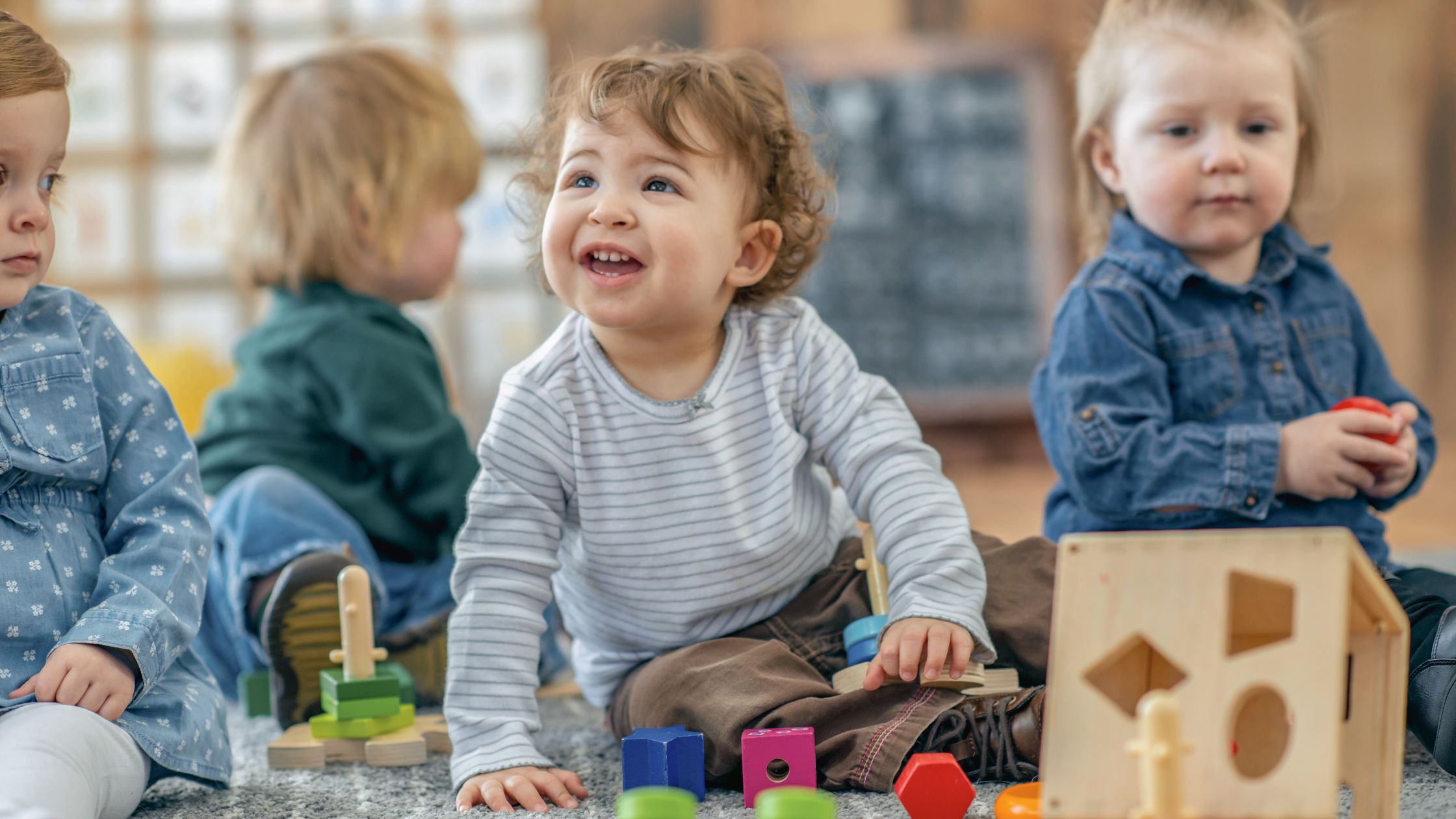
When Do Kids Start Talking? A Simple Guide for Parents
Parents love it when their baby says “mama” or “dada” for the first time. It is one of those milestones worth all the sleepless nights and diaper changes. So, when do kids start talking? What signs must you look for? How does one even track when a baby starts to talk?
Every child is different, but there are general speech patterns toward which almost all little ones develop. This blog will take you through your expectations step by step.
Talking Starts Before Saying Words
Your baby starts learning to talk long before saying “mama” or “dada.” Those early sounds might not be real words yet, but they’re the first steps toward talking.
From 0 to 3 Months:
Baby listens to your voice and starts recognizing familiar sounds.
You can hear cooing, soft vowel sounds of “oooh” and “aaah.”
Baby may smile or turn their head at the sound of your voice.
From 4 to 6 Months:
This is when the baby starts putting together sound combinations like “ba,” “da,” or “ga.” They toy with their voice, getting more and more vocal.
Laughter and gleeful squeals become more common.
Babbling to First Words – When Do Children Start Talking?
This stage of development is probably the most satisfying! Around this time, babies tend to utter more recognizable forms of babbling. These intentions may not always be understandable; however, the genuine meanings behind them should be coming to light now more than ever.
From 7 to 12 Months:
The sounds have become crammed with complexities: “mamama” “dadada” “bababa”. They begin to distinguish simple commands like hearing their name or “no.” By 12 months, many babies have at least one or two bona fide words.
What if my baby is not talking yet on their first birthday? No need to worry- the timing of when babies start talking is flexible with different babies. A few will be quite late if that’s the case.
1 to 2 Years: The Word Explosion Begins
After that, things take off! Real words appear much more frequently in the conversation, with an adorable mispronunciation or two thrown in for effect.
13 to 18 Months:
Five to twenty words is the vocabulary range for most toddlers.
They label familiar people or objects: “dog,” “milk,” “bye-bye.”
They might also imitate words heard from you.
18 to 24 Months:
Vocabulary grows fast, this is sometimes called the “word explosion.”
Your child may combine words: “more juice,” or “mama go.”
Following simple instructions like “come here” or “sit down” is normal.
2 to 3 Years: Putting It All Together
At this stage, a more organized speech is observable in your toddler. This seems to be a good time to check on when kids begin to fix their speech into full sentences.
That is, they start saying 3 to 4-word sentences, such as “I want a cookie” or “Daddy go work.” Their wording can be said to surpass 200 words.
They commence to question: “What’s that?” or “Where did it go?”
They are relatively well comprehended by others.
Still wondering when kids start talking full-on and clearly? Typically, this is between the ages of 2 and 3, but again, every child develops in their way.
What You Can Do to Help?
You need not be a speech therapist to promote language development among your children. Here are some easy behaviors that can help a lot:
- Talk about anything and everything that you are doing, things in your environment, or what is going on. “We are putting on your socks now.”
- Read to your child every day. Picture books work well; point out pictures with your finger and name what you see.
- Sing songs and nursery rhymes: They enable teaching rhythm, repetition, and unique words.
- React to their babbling as if it were a significant chat. Pause, smile, and say something back.
- Name things: Naming toys, foods, and anything else helps build vocabulary.
When To Consult a Physician?
There are typical signs indicating delayed speech development, which in some cases may be an indicator of the need to consult a medical professional. His or her views on the matter will not bring harm. By 12 months: No babbling or gestures like waving or pointing. By 18 months: No spoken words at all. By 2 years: Not combining words or difficult for others to understand. Consult a pediatrician or speech-language specialist if you are worried about the speech development of your child or are wondering when a child begins to converse. Early help can significantly change a person’s quality of life.

So, when do babies start to talk? Some may come out with a word on the first birthday, while others may delay. From babbling to full sentences is a journey that gradually evolves, filled with joy and discovery.
Most of all, remember it does not mean hitting a perfect age when do toddlers start talking is progress. Every new sound and word should be a cause for celebration. Be patient, encouraging, and responsive, and before long, you will be having full conversations with your little one. Besides this, we offer Parenting Support programs to help new parents with their kids’ development.

How and When Will Your Baby Start Smiling at You?
The baby smiling at you is one of those heartwarming moments in early parenthood. It’s not merely an adorable expression; care is involved. Numerous parents, nevertheless, wonder, “When do babies smile?” or more precisely, “When do babies start smiling at you?”
If these queries have been bothering you, you’re not sole. So let’s discuss what you should envision when to foresee it, and how you can gently begin nurturing those little smiles.
The First Few Weeks: The Reflex Smile
In the early days, you may see signs of mounting smiles, and these could happen either during sleep hours or after a feeding. These reflex smiles are mere reflexes; they don’t involve any surrounding stimulus or emotion. So if you find yourself wondering when babies smile, and your baby gets one in week two-you may want to consider that it is probably the reflex kind.
Early smiles put good money on the cuteness scale, but they are not too memorable in the long run. Still, that is a lovely sneak preview of the joy that will come.
When Will Your Baby Start Smiling at You?
The very nice event usually happens around six to eight weeks of age. That is when the real magic starts.
This has generally been the trigger for “When do babies start smiling at you?” Smiles are now social and intentional for the baby. Your baby is learning to respond to your face, voice, and presence. When those little eyes find yours and a grin bursts across their face, it is a true “I know you!” moment. That is smiling at you for the first time.
It is also around this time that you get your answers for “When do babies start smiling” and “When do babies start smiling at you?”-not that every baby is the same, though most will begin granting smiles around this time to those they love.
Encouraging Your Baby’s First Smile
A smile cannot be forced, but you’ll be able to create moments that would encourage one’s first. Here is what you have to do:
- Smile at your baby often – They love to imitate your expressions.
- Use a warm, gentle voice- They will respond more to tone than words at this age.
- Make eye contact- Babies have a fascination with faces, especially yours.
- Play little games, even simple peek-a-boo.
As you interact, you will realize when your baby starts to smile at the very sight of you; of course, this is especially true if you keep a calm and loving atmosphere around him.
What If Your Baby Has Not Smiled?
It is normal to feel uneasy and keep asking oneself, “When do babies start smiling?” or “Why has my baby not smiled at me yet?” but recall: every single newborn is unlike.
Some begin smiling almost 4 weeks of age, while others may take 10 weeks or merely slightly longer. If your infant is making eye contact and responding to your voice while seeming generally alert, there is usually no cause for concern.
Nevertheless, inspect with your pediatrician, just to be secure, if your little one hasn’t socially smiled by the twelve-week mark (3 months) because he or she does not respond to faces or sounds at that point.
Smiles Are Just the Beginning
When exactly does a baby smile? The time range is generally around 6-8 weeks. When does a baby smile at you? Sometimes right at 6-8 weeks, but quite likely a little earlier depending on his personality and development.
Along with crying, smiling becomes one of the first forms of communication employed by the infant. It is the baby’s first gesture of joy, comfort, and connection with you. It will not be long until those grins are followed by coos, chuckles, and guffaws.
There is no harm in asking when babies start smiling and at what point babies start smiling at you, especially if you are sitting there anxiously waiting for that first happy connection. But now, it will arrive.
Keep smiling, talking, and bonding. Your baby is heeding along, watching you, and learning from you every day. And when the very first real smile breaks out on his or her little face, you will know all this waiting was worth it. Get help from our parent support program if you want to raise your child.

How to Find the Right Parenting Support for Your Family
Parenthood is the most dignified employment in the globe, and at the same time, it is the most challenging. As a parent, there is no manual, no two children are alike, and most of the time, it seems like you are realizing as you go ahead. That is completely natural. The best part is that you will not have to do it alone. The right type of parenting support may be helpful.
Now, how do you know what kind of parenting support is right for your family among the plethora of books, blogs, courses, groups, and experts? Let’s break it down:
First Understanding What is Needed
Families are different, and so are their problems; pause for a moment before seeking help.
Is it a tantrum, sleep routine, or screen-time parenting issue?
Do you need some parent emotional aid because you feel overwhelmed?
Are you looking for someone who gets it or for expert advice?
Your needs determine the kind of help you will find, be it practical tips or emotional support. This clarity is the first step toward meaningful parenting support.
Talk to Trusted People
Periodically, parental support comes from the individuals most close to you. Speak to trusted companions, household members, or other parents. Someone may have gone through something comparable or may know someone who can assist.
Parenting support groups are great for connecting with those who understand what you’re going through, sharing all that wonderful information, and reminding you that you’re not alone.
Facebook groups, your nearest community center, and apps like Peanut or Meetup all have these parental communities.
Set Up Professional Support
It is not disgraceful to desire help from experts; on the opposite, it is the intelligent thing to do. Consider:
Parent coaches or counselors: They provide support tailored to your family’s needs.
Therapists: If you’re struggling with stress, anxiety, or trauma/parenting issues, therapists are accommodating.
Pediatricians: Pediatricians are a wonderful source of guidance on soundness, demeanor, and action related to your kid.
Online tutors or educational platforms: If you require educational or learning support.
Choose a proficient who appreciates your values and style of parenting support. A good professional will never judge you; rather, they will offer guidance. Their role is assistance in parenting, not instructing.
Read Some Books and Podcasts
If you prefer learning at your own pace, books and podcasts can be fabulous resources. Some are based on years of research, while others come from real parents narrating their own journeys. Look for those that reflect your values and parenting support style, be it gentle parenting, positive discipline, or anything else in between.
Check out these great titles:
“The Whole-Brain Child by Daniel J. Siegel and Tina Payne Bryson”
“How to Talk So Kids Will Listen & Listen So Kids Will Talk by Adele Faber and Elaine Mazlish”
And there must be thousands of parenting-supporting podcasts, which are perfect to be listened to while doing dishes or during a walk.
Give Parenting Classes or Workshops a Try
Parental support is not merely a one-to-one scenario’ It is about shared learning. Parenting classes are not limited to new parents. The topics touch a wide spectrum from newborn care to parenting teens. Some classes are held for one-time workshops, while others can take a more in-depth study over a couple of weeks.
Look up classes at local hospitals, schools, or community centers or on online platforms. They’re also a great way to build a real-world parent support network.
Be Gentle with the Process of Experimentation
Not every piece of advice, course, and expert will suit you, and that’s alright. It’s a journey to finding the right kind of support for the growing and developing needs of parenting. Try experimenting; be open to what you’ve learned and adjust as you go along. The most important thing is that you are feeling supported with your family thriving.

Having good parenting support might be your compass. Whether it is talking with someone about what they are going through, reading a set of helpful books, or sitting down with a coach, it’s best when it makes you more confident as well as connected as a parent.
You’re doing better than you are aware of. And the very fact that you’re seeking parental support? That already makes you a great parent.

Modern Christian Baby Boy Names With Meanings
Choosing a name for your newborn is a thrilling occasion. Modern Christian baby boy names that are significant, related to the Scriptures, or that profess faith and love are appropriate. Therefore, we have prepared a checklist of Christian baby boy names with meanings to assist you in your journey of naming the little one.
Modern Christian Baby Boy Names Inspired by the Bible
Children are usually named after individuals mentioned in the Bible. These baby boy names bear an in-depth definition and have been utilized for eras. The subsequent names, being some of the prominent biblical names, may interest you:
Noah – Rest or comfort. Noah was a devoted servant of God. He created the ark to protect his home and creatures from the flood.
David – Beloved. David was the eminent ruler of Israel and was recognized for his knowledge and courage.
Isaac – Laughter. Isaac was the sworn son of Abraham and Sarah, which signifies happiness.
Daniel – God is my judge. Daniel was recognized for his faith in God and was born in the lion’s den.
Samuel – God has heard. An outstanding administrator, Samuel was thought to be the greatest visionary in Israel.
Elijah – My God is Yahweh. An astounding prophet who wrought extraordinary miracles.
Matthew – Gift of God. Matthew is one of the twelve apostles of Jesus and the author of the Gospel according to Matthew.
Modern Christian Baby Boy Names Signifying Faith and Strength
Some names found from outside the biblical texts do carry meanings worthwhile from the Christian characteristics: faith, strength, and God’s love. Read more about baby names at parents arena.
Ethan – Strong. Symbolizes strength and reliability.
Gabriel – God is my strength. The archangel delivered important announcements on behalf of God.
Joshua – The Lord is my redemption. The man who guided the Israelites into the Sworn Land.
Caleb – Trustworthy or faithful to God. In the daylights of Moses, Caleb was one of twelve spies dispatched to survey Canaan.
Nathan – He gave. Nathan lived in King David’s time and symbolizes one who gives.
Zion – Highest point or heavenly city. Zion is a place of relaxation and familiarity with God.
Contemporary Christian Baby Boy Names with Meaning
Modern yet meaningful with a Christian interpretation? Consider these options:
Levi – This signifies “united” or “connected.” Levi, the consequential forebear of the Levitic tribe, was one of Jacob’s sons.
Asher – The name implies either “glad” or “fortunate.” Asher was one of Jacob’s sons, symbolizing delight.
Ezra – “Help” or “helper.” Ezra was a preacher and writer who inspired the rebuilding of the Jewish religion.
Micah – Restated ” Does anyone compare to God?” Micah played a major role in evangelizing morality and kindness.
Tobias – Meaning “God is exemplary.” It remarkably shows the love and kindness of God.
Jonas – Meaning “Dove.” The name symbolizes peace as well as the Holy Spirit.
Silas – Meaning “Man of the forest” or “prayed for.” Silas traveled alongside the Apostle Paul in propagating Christianity.
Classic and Eternal Christian Baby Boy Names
These names have been there through the centuries and they are still admired in every Christian family.
John – This means “God is gracious.” He was the most prominent figure concerning Jesus.
Peter – Meaning “rock.” It was one of the very closest disciples of Jesus and the most solid foundation for the church.
Paul – Meaning “small” or “humble.” He was a great apostle and spread the word of Jesus through nations.
Mark – From Latin Martius, “warlike,” or “of Mars.” He is the writer of the Gospel of Mark.
Stephen – Crown. He was the first martyr of Christianity who showed great faith.
Thomas – So-called from the Greek word meaning “twin”. One of the twelve disciples of Jesus then carried Christianity into India.
Modern Christian Baby Boy Names That Express God’s Love
Some names bear meanings indicating God’s love and grace.
Emmanuel – Name meaning “God is with us.” Very wonderful name because it reminds me of the presence of Jesus.
Theodore – Beautiful name meaning “Gift of God.” Grateful for all the gifts received from God.
Christopher – Means bearer of Christ. The name represents carrying faith in the heart.
Dominic – Probably means “belonging to the Lord.” Expressed dedication towards God.
Felix – Seen as meaning “fortunate” or “blessed.” The name indicates joy and thankfulness.

Choosing modern Christian baby boy names is such a joyous occasion. You can have plenty of lovely options: maybe you want a biblical name; perhaps, something that conveys faith and strength; or, something very uncommon. A name is more than a word: it is loaded with meaning, carries history, and is a blessing for every child’s future. We hope the following list helps you choose the best name for your little one! Also, you can explore the baby girl name guide with meanings.
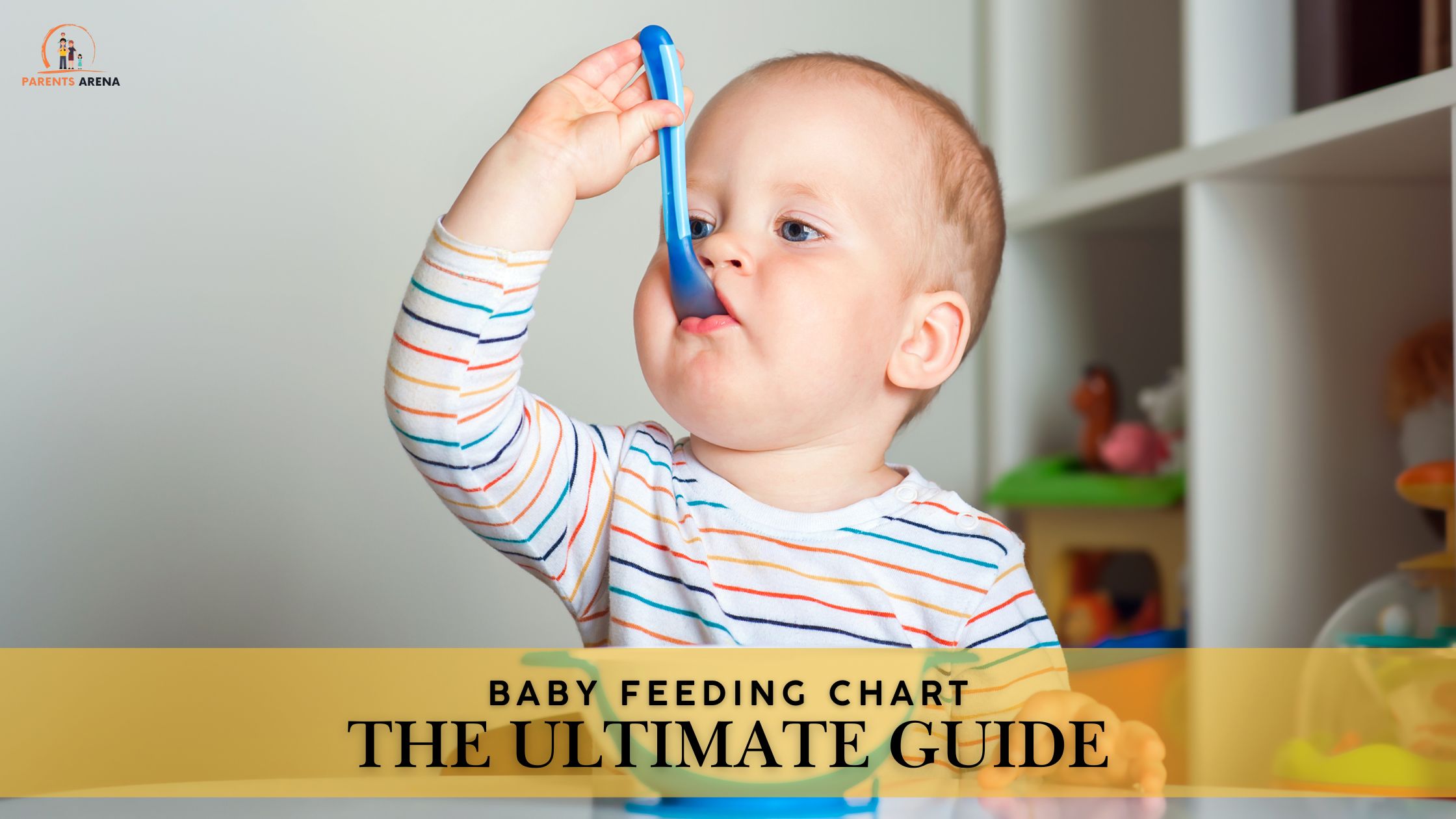
Baby Feeding Chart: The Ultimate Guide
Feeding your baby is one of the most important duties of a parent. When to feed, how much to feed, and what to feed become a mess with first-time parents. A baby feeding chart is just the thing to help you start with the techniques of nurturing your baby in the various growth stages.
This blog will address baby feeding tips, partially including the formula feeding charts and feeding charts by age. Whatever feeding modality you use, be it breastfeeding, formula-feeding, or starting solids, this baby feeding chart guide may help you keep your baby well-nourished.
Importance of a Baby Feeding Chart
Babies proliferate, and their nutritional needs differ from stage to stage. A baby food chart helps you:
- Learn how much breast milk or formula your baby needs
- Prevent overfeeding and underfeeding
- Know when to start new foods
- Keep track of your baby’s feeding schedule
Now, let us take a look at the feeding chart by age.
Baby Feeding Chart by Age
Newborn to 1 Month
Feeding Type: Breast milk or formula
How Much?: 1.5 to 3 ounces per feeding
How Often?: Every 2 to 3 hours (8-12 times a day)
Tips: During the first month, feedings happen often and in small amounts. A newborn will show signs of hunger by sucking on his hands or crying.
1 to 3 Months
During months 1 to 3, one would feed the infant with breast milk or a formula where the infant consumes about 3 to 4 ounces at a feeding and fed within every 3 to 4 hours. Feeding is getting even more predictable during this time. Remember to burp your baby after every feeding to prevent building up gas.
4 to 6 Months
From 4 to 6 months, breast milk continues to be the mainstay for babies with some formulae. They are likewise beginning to try solid food. Newborns especially consume approximately 4-6 ounces each time and do this almost every 4-5 hours between feedings. You’ll want to begin teaching solids gradually with something straightforward like mashed banana or pureed apple with breast milk or formula or rice cereal mixed with breast milk. Be on the watch for your baby’s enthusiasm for solids; symptoms can be an interest in food and an ability to sit with support.
6 to 9 Months
Breast milk or formula still comprises very important bases of their diets from 6 to 9, whereas they have started diversifying their menu into a wider variety of solids. Most babies would be using between 6-8 ounces on a feeding interval of 4-5 hours. Soft fruits, cooked vegetables, oatmeal, and yogurt are examples of solids in this stage. Introduce any new food, one by one, to check the baby for any allergic reaction. Honey, whole nuts, and cow’s milk are also excluded.
9 to 12 Months
Between the ages of 9 and 12 months, babies are increasingly feeding on solids but are still accompanied by breast milk or formula. Per feeding session, babies drink on average 7-8 ounces every 4-6 hours. Their solids should be soft and bite-sized- preferably scrambled eggs, pasta, cheese, and well-cooked vegetables. To encourage self-feeding, one can provide finger foods and give sippy cups for water to allow hydration and independence at an early stage.
Formula – Baby Feeding Chart
If your baby is on formula, here’s a brief guide to the amount of formula required at diverse stages:
Indicators That Your Baby Is Getting Sufficient Food
Babies don’t give verbal clues when they feel full; here are some other clues to look out for:
Your baby is growing steadily in weight.
Your baby must wet six or more diapers each day.
Your baby appears bright-eyed and content after feeding.
Your baby sleeps well in between feeds.
When To See The Doctor
If you notice any of the following signs, please contact your pediatrician:
- Your baby refuses to eat or is having trouble swallowing.
- Your infant is not gaining adequate weight.
- Your newborn has runs, vomiting, or additional allergic responses to some meals.
- Your baby looks hungry after feeding regularly.

Get-in-touch
A baby-feeding chart doesn’t have to be an overly complicated task. Baby feeding charts are simple guides that allow for settings when feeding your baby with the right nutrition per stage. Just remember that every baby is different; therefore, trust your intuition and consult the doctor if anything concerns you.

How to Choose the Right Deodorants for Kids
As kids enter their development phase, they become more energetic; they run, play sports, and relish outdoor movements. The outcome, however, is sweat; occasionally sweat leads to body odor, making it uneasy for kids, and many times, they evolve self-consciously. Thus, in this case, choosing the best deodorant for kids needs carefulness!
Why Deodorant for Kids?
People wonder if their kids even need deodorant. The reality is that not all kids will need it at a young age. But some of them, at the age of six or seven, start getting body odor. It may be due to early puberty, active living, or perhaps genetic factors.
In contrast to adults, children do not need antiperspirants that intercept sweat glands. Rather, they require a safe deodorant for kids that stems odor without intruding on their biological body processes. A natural deodorant for kids fosters their self-esteem, keeps them feeling reenergized, and enables them to feel cozy around their pals or mates.
Safe Deodorant for Kids – How To Choose
It is necessary to maintain track of the elements in the deodorant when choosing which one to purchase. Here are some of the paramount things to witness.
Free of aluminum – There are many deodorants for adults made with the specific ingredient, aluminum, which is well at preventing sweating. However, for a child, having aluminum is entirely unnecessary and may pose some crises concerning long-term usage.
Paraben-free – It is generally a preservative that is used in many skincare products, but at times these preservatives cause some reactions on the skin or some other health issues.
Fragrance-free/naturally scented – Artificial fragrance makes a product allergic to some people and annoys the skin. Another alternative to artificial deodorants for kids would be a natural smell, derived from essential oils.
No harsh chemicals – Dropping deodorants like phthalates, sulfates, and artificial dyes will be very harsh on young skin.
Hypoallergenic and Dermatologist Tested – A dermatologically-tested product enables it to be safe and less likely to exhibit skin reactions.
Cruelty-Free and Environment-Friendly – It is usually to choose brands that do not test on animals and have sustainable packaging.

Gentle Deodorant Solutions for Kids
Still, from the most recommended deodorants for kids:
TBH Kids Deodorant
What makes it special is the missing aluminum, paraben, or artificial fragrance. Soft and fresh. Contains such natural ingredients as charcoal and arrowroot powder.
Truly’s natural deodorant
What makes it special is that it is 100% naturally derived and does not contain any harsh chemicals. Unscented, ideal for sensitive children. Organic coconut oil ensures the smoothness of the skin.
Fresh Kidz deodorant
What makes it special is that it is gentle enough for a specially designed-skin type. Light and fresh. Mono-gender, for boys and girls. Long-lasting odor control, no irritation.
Native Deodorant (Sensitive Version)
Goodness: It has friendly ingredients like aluminum-free and paraben-free, with natural ones. Mildly smells good in kid-friendly scents. Vegan and cruelty-free.
Little Seed Farm Deodorant Cream
Great: Certified organic and made of safe, natural ingredients. Lavender, lemon, or has no scent at all. Eco-friendly glass jar packaging.
How to Introduce Deodorant to a Child
In case your child is taking the first steps toward deodorant use, a few suggestions might help:
- Discuss the importance of body odor with them simply and reassuringly.
- Choose it together – Let your child choose a safe deodorant, one that he or she likes the scent of.
- Show them how to apply it correctly and remind them to do it daily.
- Encourage hygiene – Teach them the importance of showering daily and wearing clean clothes.

Finding the best deodorant for kids is quite a task. An excellent deodorant for kids would be natural, ensuring freshness and spirit, but free of toxic chemicals. Look for skin-friendly ingredients that are certified for kids.
Deodorant is just one part of the equation. Daily showers, wearing airy fabric, and keeping hydrated will help combat body odor. With proper care, your child will feel clean, comfy, and happy every day!

Heartfelt Congratulations on the Arrival of a Newborn Baby
A newborn’s arrival has proven to be one of the most cherished and happiest moments for many. An infant indubitably brings all the love, warmth, and new beginnings that a humble house can fill with laughter, happiness, and innumerable precious memories thereafter. Be it a jumping little boy or a sweet little girl, everything is love, wonder, and adventure about parenting.
The person you love has just welcomed a new baby, so send them a good, thoughtful new baby congratulations message. What better way to share in the joy that this new event brings than for someone to be able to express their happiness, their best wishes, and, best of all, celebrate with these parents on this momentous occasion?
Here are some lovely little messages to help you express all your love and warm wishes to the new parents as they start this journey together.

Congratulations Messages for a Baby Boy
When a baby boy is born, he brings a lot of warmth and happiness home. He grows to be a little champion for his parents, who fill their home with unprecedented energy and love. Here are a few very touching messages to share happiness and colorful new dreams with this new visitor:
“Your world just became brighter and more joyful with the arrival of your baby boy! May he bring you endless cuddles, sweet giggles, and a lifetime of love. Congratulations on this wonderful blessing!”
“What an incredible blessing! Your baby boy has arrived to fill your hearts with love and your days with happiness. May your little bundle of joy grow up healthy, strong, and full of love!”
“Congratulations on the birth of your adorable baby boy! May he bring you a lifetime of joy, laughter, and beautiful memories. Wishing your little prince all the happiness and success in the world!”
“Welcome to the world, little man! Your journey has just begun, and it will be filled with love, warmth, and adventure. Wishing your family a lifetime of happiness with your precious son!”
“A baby boy is a little miracle that fills your heart with love and your home with laughter. Congratulations on your precious new arrival! May he grow up strong, kind, and full of dreams.”

Congratulations Messages for a Baby Girl
A baby girl is a gorgeous godsend, fetching passion, amusement, and a trace of charm into her parents’ verve. She is a tiny queen who will soften hearts with her endearing smile and carry eternal bliss. Mark the arrival of a newborn girl with these friendly and affectionate notes:
“A baby girl is a gift of love and light. She will fill your home with warmth, joy, and countless precious moments. Wishing your little one a future full of dreams, laughter, and success!”
“She is finally here, your precious little girl! May she always be surrounded by love, happiness, and beautiful memories. Congratulations to the proud parents on this wonderful journey ahead!”
“Your world just got a little more beautiful with the arrival of your baby girl. May she bring sweetness, laughter, and love into your hearts. Wishing you all the happiness as you embark on this new adventure in parenthood!”
“Congratulations on the arrival of your beautiful baby girl! May she bring you a lifetime of love, laughter, and magical moments. Wishing your little princess endless happiness and success in life!”
“Your little angel is here! What a wonderful blessing she is to your family. May she grow up surrounded by love and kindness, bringing joy to everyone she meets. Congratulations on this precious gift!”
Tips on how to Pen a Baby Arrival Congratulations
If you want to make your message personal and special, the following are a few points to remember:
Write sincerely and from the heart – A simple yet heartfelt congratulatory message will always be treasured by anyone, particularly by the parents.
Include the baby’s name (if known) – It will certainly add a personal touch and make the message even more special.
Offer good wishes – For the baby, who would be prayerful for health, happiness, and a bright future.
Include the parents in the message – Make a note of their journey ahead and let them know how wonderful parents they will be.
Keep it warm and joyous – Be it long or short, filled with love and positivity; people will always appreciate it.
An infant’s arrival is a truly magical event: it fills a home with kindness that knows no bounds, and joy fills a house. Such an event really deserves to be celebrated with heartfelt words and warm wishes, whether it is a baby boy or a baby girl.
If someone close has recently been blessed with a little one, take some time to send a thoughtful congratulations message. Kind words like these will reassure the new parents that they are loved and supported throughout this extraordinary journey.
It is an exciting time to celebrate this excellent new beginning and welcome a precious new life into the world!

Top 100 Baby Girl Names Guide With Meanings
Choosing the ideal name for your baby girl is a significant decision. A name is more than just a word – it holds purpose, nature, and essence. To assist you in discovering a suitable one, we have assembled a checklist of 100 beautiful baby girl names with meanings. Whether you prefer classic, trendy, or unique names, this guide has something for everyone! Moreover, for those who are interested in finding baby boy names with meanings, we’ve got those too.
Top 100 Baby Girl Names and Their Meanings
- Ava – Symbol of life or a graceful bird
- Amelia – Hardworking and industrious
- Abigail – A father’s joy and source of happiness
- Aurora – The beauty of dawn and new beginnings
- Aria – A melodious song or expressive tune
- Aaliyah – Exalted and rising above
- Anna – A timeless symbol of grace
- Adeline – Noble and full of elegance
- Ariana – Holy, pure, and divine
- Alice – Noble and truthful at heart
- Bella – The essence of beauty
- Brooklyn – Small stream, where nature flows
- Bailey – A protector and law enforcer
- Blair – A vast field or open plain
- Beatrice – A joyful bringer of happiness
- Charlotte – A free-spirited woman
- Clara – Bright and full of clarity
- Camila – A young ceremonial attendant
- Chloe – Blooming with life and fertility
- Celeste – Heavenly and divine
- Daisy – A cheerful flower, the day’s eye
- Delilah – Delicate yet captivating
- Diana – A goddess of the moon and divine light
- Daphne – A laurel tree, symbolizing victory
- Dahlia – A vibrant and graceful flower
- Ella – Light and fairy-like charm
- Eleanor – A shining beacon of light
- Emma – Whole, universal, and timeless
- Eliza – A promise to God, steadfast and true
- Everly – A peaceful boar meadow
- Faith – A deep trust and belief
- Fiona – Fair and radiantly white
- Freya – Goddess of love and beauty
- Francesca – Free-spirited or from France
- Felicity – A life filled with happiness and fortune
- Grace – The essence of charm and goodness
- Gabriella – Strength from God
- Gemma – A precious jewel of great worth
- Giselle – A sacred pledge and promise
- Georgia – A dedicated farmer, strong and grounded
- Hannah – A blessing of grace and favor
- Hazel – Inspired by the strong hazel tree
- Hailey – A hero’s haven or a hayfield
- Hope – A bright light of positive expectation
- Harper – A skilled harp player and storyteller
- Isabella – Devoted to God with unwavering faith
- Ivy – A symbol of faithfulness and eternal life
- Iris – A rainbow of colors and beauty
- Imogen – A pure and innocent maiden
- Isla – A serene island, peaceful and strong
- Julia – Youthful, vibrant, and full of life
- Josephine – God’s promise of increase
- Jade – A precious green stone of wisdom
- Juliet – A romantic symbol of youthful love
- Jasmine – A fragrant and delicate flower
- Katherine – Pure and noble in heart
- Kayla – Crowned with laurels, a mark of victory
- Kinsley – A royal meadow, where strength thrives
- Kiara – Bright, clear, and full of light
- Kylie – A returning boomerang, full of energy
- Lily – A flower of purity and innocence
- Leah – Gentle and delicate
- Layla – A dark beauty, as mysterious as the night
- Luna – A radiant moon, glowing with grace
- Lucia – A bearer of light and hope
- Mia – A cherished and wished-for child
- Madeline – A strong tower, unwavering and secure
- Melody – A harmonious song of joy
- Maya – An enchanting dream or divine illusion
- Margaret – A rare and timeless pearl
- Nora – A symbol of honor and shining light
- Naomi – A gentle presence of pleasantness
- Nova – A Bright New Beginning
- Natalie – Born on Christmas, full of joy
- Nina – A little spark of fire and passion
- Olivia – An olive tree, representing peace
- Ophelia – A helping hand and kind soul
- Octavia – The eighth, strong, and unique
- Odette – A name rich in wealth and fortune
- Oriana – A golden light, radiant and warm
- Penelope – A weaver of fate and wisdom
- Paisley – A spiritual place of reflection
- Piper – A lively flute player, full of charm
- Phoebe – Radiant, shining with inner light
- Paige – A loyal helper and assistant
- Rose – A delicate and beautiful flower
- Riley – Brave and courageous in spirit
- Ruby – A fiery red gemstone, full of passion
- Rebecca – A bond of love and unity
- Rachel – A gentle ewe, symbolizing innocence
- Sophia – A timeless symbol of wisdom
- Scarlett – A bold and passionate red
- Serena – A calming and tranquil presence
- Savannah – A vast and open plain, free and wild
- Stella – A bright star shining in the night
- Violet – A delicate purple flower of grace
- Victoria – A triumphant symbol of victory
- Willow – A graceful tree, flexible yet strong
- Zoe – A vibrant life, full of energy
- Zara – A royal princess, blooming like a flower
Selecting baby girl names with meanings is a special pilgrimage. Consider the meaning, cultural significance, and how it sounds with your last name. Whether you choose a timeless classic or a modern favorite, the perfect name brings joy and meaning to your family.
Which name is your favorite? Let us know in the comments!

10 Effective Time-Saving Hacks for Busy Moms
Motherhood is a full-time job, and no space is enough for a busy mother who wishes to forge some time for individual activities. Therefore, between taking care of the children and the home and doing a few things for oneself, time always eludes such a mother. So here are ten straightforward yet time-saving hacks for busy moms that may help stay organized and optimize the day’s preparation.
Plan Your Day the Night Before
Mornings can get terribly messy. Planning will save you precious time. Before going to sleep, pack school bags, clothes, and lunch boxes. Write out a to-do list for the following day so that you wake up knowing exactly what to do.
Family Calendar

A family calendar is thus a wonderful tool for tracking appointments, school events, and other activities. Whether using a wall calendar, planner, or app, having everything in one place keeps it organized, so there are never any nasty surprises when the time comes.
Meal Prep and Planning Ahead
Planning and prep is one of the best time saving hacks for busy moms. Cooking every day can consume a tremendous amount of time. Instead, plan meals within a week and batch-cook things when you can. Cut a few vegetables, marinate some meats, or even prepare full meals since you want to make the cooking process faster and easier at the time of use.
Waking Up Before Your Kids
Getting up at least an hour to half an hour before the kids gives you that silent time to embrace a few good morning rituals before the noise starts. You can drink a cup or two of coffee, exercise, or even get some work done before chaos explodes.
Establish a Cleaning Schedule

Avoid the tedious chore of cleaning an entire house all at once. Cut it up into bits and assign different cleaning chores for various days of the week. For example, an allocation for Monday could be laundry. Tuesday, bathroom cleaning, and everything else is scheduled throughout the week. This way cleaning does not become very hard or time-consuming and thus results in one of the best time-saving hacks for busy moms.
Simplify Your Wardrobe
Waste most of my time deciding on what to wear every day? A simple wardrobe with many pieces that can mix and match is essential for a speedy dressing. You can also prepare your clothes for the week in advance, and it will make your mornings smooth.
Shopping and Delivery Service
Save time online, buy groceries, household items, and even clothes online. Countless stores have their delivery services so that you do not need to drive and wait in line anymore. Run all other important tasks free with this time.
Involve Kids in the Household Chores

Involving kids in household matters is one of the best time saving hacks for moms. Involve kids in easy tasks, such as putting away toys, setting the table, or folding laundry a little bit each day when they are at home. Teach those responsibilities so that they learn valuable lessons while saving you close to ten minutes in that task.
Create a Daily Routine
An organized routine defines and brings about an expected everyday lifestyle for you and your kids alike. Set time for specific meals, homework, play, and bedtime, and keep a schedule that would minimize the occurrence of unpredictable and unnecessary stress.
It Is Important to Live for One’s Self
Mothers are often too busy taking care of other family members to remember themselves at times. Reserve a few moments every day for nice and easy things, like relaxing, reading, exercising, or engaging in whatever you enjoy.
When a mother takes care of herself, it energizes her, so she can take care of others effectively. One stays busy all day and still claims that this is the life of a mother, but it is not to be that complicated. Such things help in planning, organizing, and developing the right habits, so in this organization, you can save time and arrange the remnants of your life more easily. Try these time-saving hacks for busy moms and see which ones work best. Remember, even small changes can make a big difference in managing your daily routine more efficiently!

Strong and Unique Masculine Names from Different Cultures
Names play a big role in identity. A name may stand for one’s place of origin, family background, or even the traits a parent wishes the child will have. Masculine names, if strong are what you are looking for, are found in abundance in many cultures. In this blog, we will shed light on Japanese male names, German male names, Greek male names, and Hebrew male names.
Japanese Masculine Names
Japanese names are often more than just names; they carry meaning. They are denoting nature, strength, or wisdom. Most Japanese masculine names are short but meaningful.
Haruto (海亿) – This is widely accepted as a name for a boy in Japan meaning “sun flying high.”
Takashi (隆) – Talking about one who is strong and honorable, “prosperous and noble” is just the perfect definition for him.
Ren (蓮) – A simple yet powerful name signifying “lotus” and purity.
Ryota (龍太) – This name symbolizes power and wisdom, meaning “great dragon.”
Taro (太郎) – A classic name meaning “firstborn son,” very suitable for a boy who is the first.
Why Choose a Japanese Name
Japanese names are profound in meaning, referring to nature, virtue, and so forth. The names have their pronunciation and thus sound very beautiful and sophisticated. If you are planning for a name that expresses wisdom, honor, or strength, then Japanese masculine names are a great way to go.
German Masculine Names
German names are really strong and bold in their impression. Many of them have meanings related to battle, protection, or leadership.
Friedrich: A name meaning “peaceful ruler” and fitting for a natural-born leader.
Wolfgang: A mighty name; it means “traveling wolf,” depicting the attributes of strength and courage.
Otto: A short and simple name meaning “wealth and fortune.”
Leonhard: The name means “brave lion” and is befitting for a lionhearted boy.
Emil: This name embodies the spirit of a rival, someone who has a level of competitiveness and determination.
German Names Are Strong
A German name carries so much weight, authority, and presence. Many of these names were kingly, warrior names, or ones made famous by personalities in history. If you want a name that symbolizes strength and endurance, a German masculine name would be a fantastic choice.
Greek Masculine Names
Greek names are usually strongly connected to mythology, history, and the heroic qualities they symbolize. Most of these names originated from famous ancient Greek personalities.
Alexander (Αλέξανδρος)- A legendary name, meaning “defender of men.”
Dimitrios (Δημήτριος)- One who is “regular” to Demeter, the Greek goddess of agriculture.
Nikos (Νίκος)- Strong and short; it means “victory.”
Theodoros (Θεόδωρος)- A name with deep significance meaning “gift of God.”
Leonidas (Λεωνίδας)- This heroic name means “lion-like” and is famous due to the Spartan king Leonidas.
Hellenic Nomenclature for Names and Mythology
Most of the Greek names are closely linked to gods and heroes. These names have moved miles in passing down through the centuries, yet hold a place for strength and leadership. For noble and historical legacy reflected in the name, the Greek masculine names would rank best.
Masculine Hebrew Names
Most Hebrew names have some or the other religious and historical connotations to them. Most of them are quoted from the holy book, the Bible, from where they tend to acquire most of the meanings.
Eli (אלי) – A straight and meaningful name, meaning ascended or my god.
Gabriel (גָּבְרִיאֵל) – This name means God is my strength and is the name of an important angel.
Noah (נֹחָ) – This means rest or comfort, a simple and yet well-known name.
David (דָּוִד) – A biblical name that means beloved.
Samson (שַׁמשׂון) – This means “like the sun,” and is attributed with the greatest strength in the Bible.
The Meaning Behind Hebrew Names
Mostly, the Hebrew names have been given a special spiritual meaning and remained in use throughout the centuries. They bear a sense of deep faith, perseverance, and history. A masculine Hebrew name may serve as a very good option for a person looking for a name that bears such a deep-seated history.
Choosing a name is an important and consequential task, for whatever the sound or meaning, or cultural background, for workaday reasons the choice simply felt right. Japanese masculine names, German masculine names, Greek masculine names, and masculine Hebrew names each carry their unique and strong meanings.
Naming means different things to different cultures; whilst the Japanese poets see nature-based names as channels of free expression, German names incite strength and pride, so much to evoke warriors. The Greeks inspire mythology and heroism, while the Hebrew name groups delve into the deep significance of spirituality.
May this list serve you in finding that perfect name that embodies strength, history, and culture! As for us, do you have any favorite name in any of these cultures or any name that you would like to share? Comments are open!

Top 10 Baby Gear Items for New Parents
Becoming a new parent is indeed a delightful yet overwhelming experience, full of much excitement and, of course, extended baby product lines that create all sorts of dilemmas close to their need. For that, we compiled a list of those top 10 baby gear items as best, although it seems not quite enough, to offer some help to new parents. These must-have items will help ensure the safety, comfort, and happiness of the baby while giving parents an easier run in the parenting business.
Infant Car Seat
Essentially one of the first baby gear items that you need to bring your newborn home from the hospital. It’s for the baby’s safety when traveling. Make sure to purchase an infant car seat that meets safety standards, is easy to install, and is paired with enough padding for comfort. Most possible, it has a base that can stay in the car, wherein you can easily snap in and out of the seat.
Stroller
Good strollers are very important when you have to tend to outings with your precious. They include lightweight strollers, jogging strollers, and travel systems. Choose the type of stroller that will best fit your lifestyle. A storable stroller is ideal for new parents as it can be easily folded has enormous storage space, and will change the position of the seat.
Baby Monitor

One suitable baby gear item is a baby monitor. Baby monitors allow parents to listen to or watch their children while they are in another room. They come in audio and video formats and may include temperature sensors and night vision. A good baby monitor provides peace of mind and allows you to lie down while your baby sleeps.
Crib or bassinet
One of the best baby gear items. This is it; your little one needs a safe, comfortable sleeping space. While cribs tend to be long-term, bassinettes are smaller, portable options perfect for the first few months. The crib should meet safety specifications with adjustable mattress heights and sturdy construction. As well, a firm mattress with fitted sheets is quite necessary for a safe sleeping environment.
Diaper Changing Station
Changing diapers will take up a large part of your life as a parent, so to help make it easier, consider setting up a diaper station in your home. It’s a dedicated changing table or pad with some storage for the necessary diapers, wipes, and creams and a great changing pad for diaper changing organized. Some parents also opt for a portable changing pad for on-the-go changes.
Baby Carrier or Wrap
One of the best baby gear items. This provides hands-free baby carrying while you do chores or even walk around. Babies love to be next to their parents, and nothing beats being close without having to carry your full weight. This baby carrier must have adjustable straps, proper back support, and breathable fabric.
High Chair
Solid foods are introduced around the six-month mark, and at this point, high chairs become a necessity in your home. A strong, easily cleaned highchair equipped with a safety saddle will keep your baby safe and comfortable at mealtime. Some high chairs grow with children and may be adapted as they grow older.
Baby Bathtub

One of the best baby gear items. A baby bathtub provides safety and comfort while bathing. Look for a tub with a non-slippery surface and good support for newborns. Some bathtubs have indicators to show whether the water is just perfect for the baby. A soft washcloth, mild baby soap, and a hooded towel are essentials for bath time.
Swaddling
Swaddling benefits a baby’s feeling of safety and convenience, which helps in falling asleep well by emulating the tight sense of the mother’s womb. As the infant grows, sleep sacks are a secure option for flexible bedding. They are made of smooth, breathable textiles that keep your baby feeling pleasant and comfortable.
Breast pumps
One of the most reasonable baby gear items. If you intend to breastfeed, a breast pump can furnish options for storing milk or permitting others to feed the baby. Contrariwise, good bottles, nipples, and bottle warmers can support bottle-feeding parents through the feeding time. Sterilizers will likewise help keep bottles sterile and germ-free.
Good baby gear items make the parenthood experience more effortless and more enjoyable. While there are numerous products known for babies, focusing on the requirements will save you money and stress. Every family is diverse, so choose what serves your requirements and lifestyle best. Cherish this time with your baby, and always remember that love and care are what your baby needs most!

10 Best Parental Control Apps for 2025-26
Nowadays, parents are always worried about their kid’s safety on online platforms. Children use smartphones, tablets, and computers for educational and entertainment purposes. Still, beyond this, they can expose themselves to toxic content, spend too much time on screens, or interact with strangers. Hence, many parental control apps help parents monitor their child’s online activity.
Here are the 10 best parental control apps of 2025-26 for parents in the USA to keep their kids safe online.
Bark
This is one of the most trusted parental control apps in the USA that monitors text messages, emails, YouTube, and social media apps to check for warning signs of cyberbullying and online predation, depression, or other issues.
Key Features:
- Monitors over 30 social media platforms
- Sends alerts about harmful content
- Manage screen time
- Website Filtering
- Works on iOS, Android, and computers
Pricing: From $14/month
Qustodio
Qustodio is a powerful yet one of the best and easiest parental control apps with advanced monitoring features. It helps parents implement screen time limits and block harmful websites.
Key Features:
- Web filtering and time management
- Location tracking
- Monitoring calls and messages (Android)
- Available for Windows, Mac, iOS, and Android
Pricing: A free version is available; Premium version starts at $54.95/year
Net Nanny
Net Nanny has a great reputation for its technologies of content filtering. This software allows parents to supervise their child’s digital behavior and block inappropriate content.
Its chief features entail:
- Adult content is blocked with explicit websites.
- It permits app time management and screen time management.
- Real-time location tracking.
- Available on Windows, Mac, iOS, and Android.
Price: $39.99/year and above.
Norton Family
From the trusted Norton brand, Norton Family provides an extensive suite of parental control features that make it suitable for families with numerous devices.
Its key features include:
- Web filtering and online activity tracking.
- Time limitation on the usage of devices.
- Monitors the search terms used by kids.
- Works on Windows, iOS, and Android.
Price: $49.99/year and above.
Kaspersky Safe Kids
Kaspersky Safe Kids is a reasonable and one of the best parental control apps for parents who want to keep an eye on their children’s online activities and device usage.
Its key features include:
- Web filtering and app control.
- GPS location tracking.
- Screen time management.
- Works on Windows, Mac, iOS, and Android.
Price: Free version; Premium at $14.99/year.
FamilyTime
FamilyTime is a feature-rich app that allows parents to keep track of online activities for their children, including limits on screen time.
Its chief features are:
- Geofencing and real-time location tracking.
- App blocker and screen time control.
- Monitors call and SMS.
- Works for iOS and Android.
Price: Starting at $27/year.
OurPact
OurPact is well-known for its simple screen time scheduling and app-blocking features for managing children’s screen habits.
Key features:
- Blocking apps and websites.
- Screen time scheduling.
- GPS tracking.
- Works on iOS and Android.
Price: Free plan; Premium from $6.99/month.
MMGuardian
MMGuardian – one of the parental control apps that is aptly designed for the monitoring of activities of children by parents and keeping them away from harmful content and online dangers.
Key Features:
- Monitor text, calls
- Web filtering and app control
- Location tracking
- Compatible with Android and iOS
Price: Starting at $49.99/year
Screen Time
Screen Time is just the right tool if you are a responsible parent willing to set limits to their child’s screen time and teach them how to use their devices responsibly.
Key Features:
- Daily screen time limits
- App usage reports
- Remote locking-device
- Compatible with iOS and Android
Price: Free but premium starts from $6.99/month
Google Family Link
Google Family Link is a free and one of the best useful parental control apps that is most favorable for younger kids using Android devices.
Key Features:
- Screen time limits and app approvals
- Location tracking
- Monitors app for usage and web searches
- Compatible with Android and iOS
Price: Free
The right parental control apps depend on your needs and your child’s online habits. For serious social media monitoring, Bark is a viable option. For screen-time management, OurPact or Screen Time would work well. If you are looking for something cost-effective, both Google Family Link and Kaspersky Safe Kids have reasonably good free features.
Regardless of the app you choose, have candid conversations with your children about internet safety. Parental control apps are indeed a great helping hand, but educating your children about responsible digital behavior is the primary concern for their online safety.

The Benefits of ’90s TV for Kids
The ’90s indeed was the golden era for television, particularly for kids. It was when children used to wait for some famous programs to air every week without smartphones or streaming services. The ’90s show proved to be a source of entertainment and also imparted immense value to young minds. Below are a few benefits of ’90s TV. Get ready to explore!
Educating With Fun
Education and entertainment merged well, such that ’90s kids’ television offered so much of the same thing: Sesame Street, Blue’s Clues, and Bill Nye the Science Guy taught children numbers, letters, and science in a fascinating way. Kids weren’t settled without importance; they were indebted to having so many fun characters and actions for easy learning.
Conferred Imagination and Creativity
The most dazzling imaginations of children’s cartoons were in the ’90s. Rugrats, Doug, and Animaniacs let kids give free rein to create new ideas, stories, and dreams. What these shows did was encourage creativity with their highly original characters and stories, making children think outside the box.
Incorporated Social and Moral Lessons
The big lessons in life were taught through TV shows in the ’90s. Lessons on friendship, kindness, and honesty were revealed in Arthur. Boy Meets World talked mostly about the phenomena that kids meet in the world, such as peer pressures and family. Shows like these explained what emotions are all about, how respect is gained, and what it means to do the right thing.
Build Strong Family Connections
Watching TV with family became part of family tradition in the older days when streaming and on-demand services did not exist. Shows like Full House and The Fresh Prince of Bel-Air could be enjoyed together by parents and kids, giving rise to family time and conversations about life lessons. This then contributed significantly to family bonding and making wonderful memories.
Improved Attention Span and Patience
Unlike today’s instant-fed content, kids of the ’90s could only enjoy elite episodes of their favorite shows after enduring a long wait. This taught them how to be patient and gave them the ability to concentrate for longer periods. Eating away at a whole episode without interruptions was quite normal at that time, so they had a comparatively better attention span compared to short, rapid video clips readily available today for children.
Encouraged Outdoor Play and Physical Activity
Unlike today’s children who are glued to different screens, there was a perfect amalgamation for a kid born in the ’90s. After watching cartoons, they would run out to play, improvising favorite scenes from those movies. Power Rangers and Pokémon made children run and run, stimulating their imaginations.
Opened Up to Different Cultures and Ideas
Many ’90s TV shows opened children up to different cultures and ideas. Hey Arnold! Provided urban-set city life, The Magic School Bus taught about science and adventure, and Dora the Explorer taught a few words in Spanish. Exciting and appealing to kids, these shows helped them learn the world.
Less Screen Time Creates More Balance
With limited TV hours, kids spend more time outdoors, reading books, or indulging in various hobbies. This balance contributed to wholesome development and as a calming antidote to the overstimulation that today’s kids experience with unlimited screens.
Built Sweet and Beautiful Childhood Memories
For many adults now, ’90s TV is a sweet memory. The theme songs, characters, and stories remain with them decades afterward. Thus, these shows formed a base of childhood identity for sharing memories with future generations.
The ’90s produced a unique breed of kids’ television. It brought education, life lessons, creativity, and fun into one show. Opposite today, ’90s TV had that charm that produced balance and a healthy childhood. Technology may have changed, but the impact of these classic shows resonates. For all those who had a childhood in the ’90s, these TV series are not just fond memories; they are a much-needed component of their childhood.
If the opportunity arises, take time to introduce today’s kids to a couple of old classics from the ’90s. They may just love them as much as you did!

Why Planning for Parenthood Is Imperative?
There is something very captivating and transformative about parenthood’s existence as it relates to life. Parenthood is a responsibility that should be well-planned. While many couples are excited by the chance of having a child, few take into consideration the importance of planning for parenthood. Being prepared provides a deck surface upon which parenting can take off smoothly, enabling a better future for both child and parents.
Financial Stability
As a baby grows, so does the financial responsibilities. From hospital bills to diapers, baby food, clothes, toys, and college bills, the expenses add up quickly. Planning for parenthood would thus make budgeting the couples’ finances easier to manage and plan for these expenses.
Setting up some sort of savings scheme, budgeting, and health insurance for the newborn are essential elements of this plan. Other parents start saving almost right away for their child’s education to lessen the burden in the future.
Emotional Readiness
Parenthood is a delightful experience, but it does come with its share of challenging situations. Lack of sleep, remaining alert constantly, and lifestyle compromises can be quite overwhelming. Both partners need to engage in talks about how prepared they are for this huge shift in their lives.
Expectations, responsibilities, and encouragement should be shared between the couple. Emotional planning for parenthood helps in creating a firm and healthy environment for a child to grow up in.
Physical Health
Both parents should be healthy before planning for parenthood. Mother’s health is vital for the unborn baby’s health. Proper nutrition, exercise, and prenatal vitamins are imperative for a healthy pregnancy.
Dads can also aid by being healthy. It benefits fertility and the healthy development of the unborn child. Consultation with a doctor for pre-pregnancy check-ups for both parents would be a wise move.
Relationship Stress
The arrival of a baby adds joy and tests the couple’s relationship. Stressful long awake nights, financial strains, and responsibilities create tension for the lacking partners. There was an emotional bond present between partners before conceiving a child.
Spending quality time together, discussing parenting styles, and understanding one another’s concerns creates a firm base for the relationship. It is a togetherness and nurturing relationship between both partners that constitutes a happy home for the baby.
Work and Life Balance
Work and parenting are a challenge for most parents. Early planning for parenthood allows couples to discuss work arrangements and parental leave. Some may decide to adjust their work hours, while others might call upon family help or childcare.
Knowing how to keep a working life in balance with bringing up a child assures that the baby receives all the love and care, whilst the parent never loses sight of his career plans.
Mental Preparation
Parenting essentially means more than just providing the basic needs of a child. Patience, understanding, and emotional resilience are necessary. Therefore, feelings of trepidation are common; however, it is said that a little mental preparation calms worries and eases changes.
Reading parenting books, enrolling in parenting classes, or seeking help from more experienced moms and dads will help. Mental preparation also reduces stress and helps parents to have fun along the way.
Creating a Loving and Secure Environment
Every child grows up with love, security, and safety. Planning for parenthood should include baby-proofing the house, organizing a nursery, and creating an atmosphere of calm.
Parents should also work on their emotional and mental well-being to nurture positive parenting. A stress-free and loving environment promotes child development.
Understanding Parenting Responsibilities
Parenting is a lifelong responsibility. It is not just putting food into mouths and clothes on backs but guiding to bring responsible individuals into society.
It is essential to know the developmental stages of the child and the means to nurture them emotionally, psychologically, and physically. Parenting is an ongoing learning process that continuously adopts new techniques; this takes time, patience, and commitment.
Social and Familial Support
Having a sound support system in place would make planning for parenthood easier. Advice from family members, attending parenting groups, and having friends who support you can help.
Family support assists new parents as they adjust to their new responsibilities, such as offering a set of helping hands. Conversations with other parents can also provide valuable information and motivation.
Parenthood can be very fulfilling but requires a plan. Imperative aspects of a child’s development are financial security, emotional readiness, a healthy relationship, and a safe environment as mentioned above.
Planning for parenthood helps alleviate anxious feelings, supports a smooth transition, and establishes a nurturing environment for one’s child. Parenthood is not only about giving birth to a sweet baby but also nurturing a happy, healthy, and highly lovable human being. Putting more thought into planning goes a long way toward ensuring the joy and fulfillment of the parenting experience.

A Guide To Authoritative Parenting Style
Parenting means facing challenges and making big decisions. One of the biggest questions confronted by parents – “How best to raise my child?” Parenting styles may vary, but authoritative parenting style is said to be among the greats. It is a style that seeks a balance between achieving warmth, guidance, and clear rules and expectations. In this blog, we explore what authoritative parenting entails, its benefits, and how to practice it daily.
What Is the Authoritative Parenting Style?
Authoritative parenting is a style of parenting in which some control is exerted by the parents through established clear rules while nurturing love and support. It differs from authoritarian and controlling styles, which follow strict rules, while permissive parents lean towards a total lack of structure and even permission-giving. The idea is for the parents to discover a balance between commitment and demands. The following are several crucial dimensions of authoritative parenting style:
Clear Expectations: Parents should set rules along with their reasoning for why they are important.
Open Communication: Kids are urged to state their views and feelings.
Warm and Supportive: Parenting behavior manifests in parental warmth, encouragement, and emotional support.
Reasonable Discipline: Consequences are applied when necessary but fairly and with understanding.
Benefits of Authoritative Parenting
There are numerous advantages of an authoritative parenting style for both children and parents alike.
Builds Confidence and Independence
Children being raised under an authoritative parenting style learn their decision-making and responsibility. They walk with confidence, pride, and belonging, knowing that their parents follow them in letting these children weigh their own opinions.
Better Communication Skills and More
Authoritative parents encourage open discussion; thus, children’s communication skills develop in expressing emotions, resolving conflicts, and forming relationships.
There are more instances where the child behaves well when one or both parents give a reason for the rule. The child respects parents not through fear but through being heard and valued.
It supports emotional health since children with knitted emotional well-being live and die in a loving, structured environment and have better control over their emotions. Because they feel safe and secure in the support of their family, anxiety and aggressive behavior are less about them.
Children know they can talk to Mom and Dad about anything. And that creates a strong bond that lasts a lifetime.
How to Practice Authoritative Parenting Style
Decide on Clear and Just Rules
Children feel secure when rules are set, but they need to have an understanding of them. Instead of “Because I said so,” give a clear explanation.
Do not say:
“No more screen time!”
Instead, say: “Too much screen time can hurt your eyes. Let’s take a break and do something fun together.”
Wind Up Listening to What Your Child Has to Say
Also, help your child express his or her opinion. If he or she is doing something wrong, let the child express his or her reasoning before punishment. This teaches your child how to solve problems and take responsibility.
Authoritative Parenting Style Says, Love Should Be Firm
Love and discipline should be present together. When a child commits a mistake, it may help to establish fair consequences but always ensure they feel through the consequences that you love them.
For example:
“I understand you were upset, but hitting is not okay. Next time, use your words to express your feelings.”
Good Behavior Should Be Praised
Children need to be encouraged. Whenever they do something nice, appreciate their attempts. This builds self-esteem and motivation.
For instance
“I’m so proud of you for helping your younger sibling! That was very kind of you.”
Be attuned to the actions of one‘s parents.
Children learn by imitation. So one must show the way of handling the situation calmly and respectfully. If one wants a patient, kind, and responsible child, be one themselves.
Challenges and Tips to Overcome
Authoritative parenting style does have its fair share of challenges. Here are the ways to handle them:
Rule-breaking: Be patient and calmly remind your child of the rules. Give them as many choices as possible to provide a sense of control.
If you lose your calm: Take a deep breath. No one is perfect. If you lose your self-control, you can apologize to your child.
If your child makes comparisons: Say that no two families have the same rules, and your rules are for their safety and happiness.
It is a balance between being warm and being firm, supportive and punitive. The authoritative parenting style prepares children to become responsible, confident, and kind persons.
Although no single parenting style can be perfect, an authoritative parenting style will help you raise a good child and sustain a good relationship with him.

Top 10 Safety Tips For Kids Parents Need To Teach
Parenting is all about ensuring the safety of our children. By familiarizing children with how to stay safe, we can help direct the world by making them step confidently and cautiously in the world. Here are ten safety tips for kids that parents need to teach their children:
Know Your Name, Address, and Phone
Your child must know his full name, your name, home address, and telephone number. All such things are imperative if they are lost or need help.
How to Teach:
- Make a practice of remembering it daily.
- Twist it into a delightful song or rhyme that is easier to recall.
Identify Safe Adults and Places
Teach your children to recognize safe places or adults: police officers, teachers, or store employees can at least help when asked. This is one of the safety tips for kids. Take them around safe places in the community so that they can hang out in times of fear or loss.
How to Teach:
- Show your children scenarios in which they might find the need to ask for help.
- Go with them to local sites deemed safe and explain why they are safe.
Never Talk to Someone You Do Not Know
Being courteous is imperative, but parents should teach their children that everyone does not have good intentions. Teach the kids how to avoid strangers who approach them.
How to Teach:
- Tell them what a stranger looks like and that it is okay to say no.
- Put into practice the “No, thank you” method making it three times in the same way a student learns something.
Stay Close to Trustworthy Adults
Children should be kept within the sight of a parent or other trusted adult when they are out in public. Wandering can quickly send them into a dangerous situation.
How to Teach:
- Teach them the benefits of staying close.
- Use the buddy system while going to crowded places.
Emergency Number Knowledge
Emergency can occur at any time. So this is one of the most important safety tips for kids. Your child must be able to dial emergency numbers like 911 and know when to use them.
How to Teach:
- Demonstrate pressing these emergency numbers on a toy phone.
- Instruct them to tell their name and location as interestingly as the emergency.
Safe Online Behavior
Nowadays, kids enjoy surfing the internet for learning and fun. Do not allow children to share any confidential information or chat with strangers.
How to Teach:
- Often monitor their activities online using parental controls.
- Teach the child about the importance of keeping passwords secret.
Be Safe on Streets
Your child should understand how important safety is and always look left and right before crossing the road and the proper use of walking lanes.
How to Teach:
- Crossing the street together can provide this education.
- Make them understand traffic signals as well as road signs.
For Peer pressure, Call NO
Don’t follow others to be in the group, rather teach a child to take action and say no in the worst matters even if friends are doing it. Calling No is one of the important safety tips for kids, that parents should teach their children.
How to Teach:
- Make this communication process easier so that children can share the matter openly.
- Put an act and tell when they have to say no.
Have Faith in Your Instinct
Kids have an inner sense about things that are not safe. Teach them to listen to their instincts and leave places where they are not safe.
How to Teach:
- It is okay to leave or call for help if they feel uncomfortable.
- Say that their safety is more important than being polite.
Fire and Water Safety
Make sure your children are protected from flames and currents. Make sure you talk to them about these safety tips for kids things. Teach them to never play with matches or lighters, and always to have an adult nearby when they are in the water.
How to Teach:
- Put some rules preventing fire and water hazards.
- Get your family involved with fire drills, and talk about water safety rules.
Teaching your children the same is a continuous process that needs lots of patience and creativity. Parents can utilize this approach to develop confident and representative boys and girls while guiding them to follow these reminders often and lead by example.
Here are just the top 10 safety tips for kids, to be adapted for any age and any place that allows your children to consider when continuing with those toward the aim of a conscious and upright future, which decided them while longer distances unobserved by their parents.

How To Prepare For Parent-Teacher Meetings?
Parent-teacher meetings (PTMs) are amazing opportunities for communicating directly with the teachers and knowing about your kid’s academic growth in school. It helps in learning about academics, behaviors, and social development. As part of this process, planning for a small change will help. Here’s how best to prepare for parent-teacher meetings:
Establish The Purpose Of The Meeting
Understand the importance of a meeting before attending it. Parent-teacher meetings are generally conducted to provide updates about student performance, areas of improvement, and things of concern. This will give you a perfect point to focus upon when discussing matters.
Revisit the Results and Performances of Your Child
Take a real look at your child’s grades on the most recent report cards, homework assignments, test results, and teacher feedback. Ways must be found in strengths and weaknesses that define your child’s academic journey, so ask relevant questions during the meeting with good preparation.
Talk to your Child
Engage in a free conversation with your child before having a meeting. What are their favorite subjects? What do they hate in their subjects and need you to talk to their teacher about? This will prepare you well for parent-teacher meetings and make your child feel involved and valued.
Compile A Set Of Queries
Ask questions. Below are examples:
- How is my child doing academically?
- Which specific areas need improvement for my child?
- What is the behavior of my child in the classroom?
- Is he/she cooperating well with others in group work and discussion?
- How can we help them at home?
Be On Time
Being on time is very important. Show teachers respect for their time by being a few minutes early thus setting a calm and positive note for all involved in such meetings. If you arrive late, inform the school so scheduling may happen.
Carry Relevant Materials
Make sure to carry the necessary documents with you, like previous report cards, samples of assignments, and some notes for special areas of concern. These during parent-teacher meetings, can help teachers understand your discussions better and address queries effectively.
Have A Positive Attitude
Come prepared with an open frame of mind to the interview. Listen to the educator. They do have a purpose for their observations to nurture your child so sensitive feedback should be put in for reflection. Work on ways to solve issues together instead of accusing anyone.
Write It Down
It is important to take note of essential things such as affirmations, suggested strategies, and any future actions. It will be easier to remember everything discussed and carry forward at your place.
About the Child’s Information
The teacher may not know some facts about the child in terms of what happens outside the school; his/her hobbies, health condition, or even crises in the family. Yet this part is worth telling to further elaborate with the teachers so they can understand more, then proceed to help the child personally.
The Next Step
Towards the end of the parent-teacher meetings, have a conversation about “What happens next?” Discuss specific steps both of you can follow to help the child make progress. This might be a session plan, additional materials, or per-unit updates on progress.
Go After
Meanwhile, go to the notes you would have taken from the meeting and talk with your child. Implement the strategies agreed upon and keep an eye on how they proceed. If necessary, have a follow-up meeting with the teachers to review progress.
Enhancement of a Strong Parent-Teacher Partnership
Parenting and teaching harmony form the basis of a nurturing framework for the growth of your child. Keep in touch with the teacher during the year and attend some school events to show that you are part of the child’s educational life.
Preparing for the parent-teacher meetings shouldn’t turn out to be a burdened task; with some planning and a positive attitude, you can have a meaningful and effective interaction. Remember that the end goal of purification and actualization comes from collaborating with the teacher and positioning your child first. However, practicing these little steps will make you fully ready for one of your upcoming parent-teacher meetings.

What Do You Mean By Parenting Curriculum?
Parenting is indeed a joy-filled journey speckled with challenges and life lessons. It is true, however, that child-rearing does not come with a manual, as each child is so uniquely different that parents often discover themselves looking for tips. Therefore, the concept of a “parenting curriculum” was brought into existence as it appears clearly like an organized plan for helping parents understand and meet the needs of their children while also establishing strong family relationships. But of past experiences, what is a parenting curriculum, and therefore, how will it work? Let’s take a closer look.
Understanding Parenting Curriculum
A parenting curriculum helps and guides all parents on their upbringing path with their children. It gives both the tools and strategies needed for the understanding of the development, behavior, and emotion. It is like a road map a parent needs to have handy, with all the practical advice and insight that will make the parenting experience easier and more rewarding.
Parenting curriculum programs range from those aimed at specific stages, such as toddlers or teenagers, to those covering parenting in general. They are built by child evolution experts, psychologists, and educationalists who know the problems of the parents and the skills they need to find their way back.
Why Is a Parenting Curriculum Essential?
Parenting isn’t as natural, what works for one child might not work for another. Parenting curriculum helps mitigate this burden by providing research-based approaches to address common challenges. Here are a couple of reasons why it is significant:
Builds Stronger Parent-Child Relationships
The main target of all good parenting curricula is to strengthen relationships between children and parents. Communication becomes a very important aspect since parents can hold the child’s trust and mutual respect.
Provides Tools for Handling Challenges
Each age group presents its own set of challenges, so a parenting curriculum provides parents with just the right strategies to handle them (calmly and effectively).
Encourage Positive Parenting
Positive parenting includes focusing on good things like using encouragement, “positive” encouragement, and letting patience and gentleness teach one’s child well. These kinds of approaches are promoted by parenting programs. This will help cause less anxiety for both parent and child.
Supports Child Development
Knowing a child’s developmental milestones helps parents guide the correct form of support at the proper time. Most parenting curriculums and programs provide insight into this milestone realization of development so that parents align their actions with their child’s growth.
What Does a Parenting Curriculum Include?
Parenting programs cover a broad spectrum of topics about parenting. Below is what one can usually expect:
Child Development
Knowing their child’s physiological, emotional, social, and cognitive development assists them in understanding their growth crossroads and how to support them in learning and well-being.
Effective Communication
Good communication serves as the foundation for nurturing and maintaining well-built relationships. It teaches them techniques for active listening, clear self-expression, and resolving conflicts healthily.
Discipline and Behavior Management
Discipline is not punishment; it is about making your child incorporate what is good from the bad. A parenting curriculum teaches parents specific ways to set boundaries, establish and enforce rules and expectations, and encourage good behavior in their children without guilt.
Emotional Support
The most comprehensive range of emotions becomes part of children’s lives, and parents must help them come through it. Often, topics include empathy, emotional intelligence, and strategies to help children deal with their emotions.
Self-Care for Parents
The work of parenting is hard, it’s exhausting and provides many opportunities for burning out. So a good parenting curriculum reminds parents to take care of themselves as well. After all, you cannot pour from an empty cup. Tips on stress time management, and balance are some modules that could go into the curriculum.
The journey of nurturing is not solely for the child, but it is simultaneously a journey for the parents. A parenting curriculum serves as a supportive buddy for providing clues and tools that can strategically help guide one along this journey. Nobody is a perfect parent, but a caring, thoughtful, and well-informed one.
Do you ever feel that you have lost your way, or that parenting is larger than life? You are not alone. A parenting curriculum seems just the thing you might want to instill confidence and connection while bringing up your child.

What is Bad Parenting, and How Can It Be Changed?
Parenthood is a joyful and confusing process full of learning. Parents intend their child to grow up well, but sometimes, without knowing, certain actions and behaviors adversely affect the child, which is commonly referred to as “bad parenting.” Being aware of “what bad parenting is and how to deal with it” would help people find a better environment for the child’s healthy growth and blossoming.
What is Bad Parenting?
Bad Parenting does not mean that parents are bad people; it just means that some actions or habits or even some behaviors prove unhealthy for the emotional, mental, or physical health of the child. No parent is perfect, and every one of us is bound to make mistakes when child-rearing. However, there can become such patterns of behavior that might have consequences long after their manifestation in children’s lives.
Here are some common signs of parenting
bad:
Neglecting Attention: Frequently, parents do not spend some quality time with their kids, and make their children feel abandoned and unwanted, eventually resulting in very low self-esteem and feelings of worthlessness.
Sound as Critical: When parents criticize their children’s small habits for their big ways of life, they foster low self-confidence in children, so they feel they can’t do anything right.
Inconsistent Action: Parents spank their children one day, only to disregard those actions the next day. Such discriminating treatment leaves confused and muddled children, and eventually ends up in ugly scenes.
Favoritism: This can also lead the siblings to feel rivalry towards each other since the trickling of one child with another makes another feel unappreciated.
Unrealistic Expectations: Pressurizing child to achieve things well beyond their capability would lead to anxiety, fear of failure, and stress.
Physical or Psychological Violence: Any abuse, be it physical, verbal, or emotional, is extremely damaging and can leave long-lasting scars.
Lack of Empathy: Not listening or ignoring a child’s concern or the feeling attached can topple over the sense that nobody matters.
Effects of Bad Parenting
Bad parenting can profoundly influence a kid’s life, frequently leading to low self-esteem as they stumble with self-worth and trust. It can epitomize behavioral concerns, such as aggression, defiance, or problems heeding rules while hindering their capacity to form wholesome affinities with peers and family members. Academically, kids may face struggles due to a shortage of encouragement or support, and the hostile home environment can contribute to cognitive health issues like anxiety and depression, shaping their prevalent well-being and opportunities.
How Can Negative Parenting Be Changed?
The good thing is that parenting is a learnable and improvable art. Honestly admitting that there is a problem is the place to start for constructive change. Here are some practical things that you can put into effect to be a better parent:
Spend Quality Time With Your Child: Spend time with your child engaged in meaningful moments. Play games, read, and discuss how their day went. Quality time strengthens the relationship and trust.
Be Consistent in Practicing Positive Discipline: Before screaming at your children, understand what caused their behavior. At the same time, consistently and calmly discipline them to help them learn the right way.
Listen Well: When your child shares something, make sure you listen to the tail end and not interrupt for things to make sense. Rather, be empathetic and validate their feelings even when you don’t share the same viewpoint.
Set Realistic Expectations: Encourage your child to reach new levels of success through the long haul, but do not pressure them into achieving impossible goals. Join in their celebrations, as well, for efforts, not just accomplishments.
Unconditional Love: Tell your child that love doesn’t depend on performance or behavior. This suffices to offer security and self-worth.
Apologize When Required: Parents are humans and mistakes do happen. Admitting these mistakes will help your child learn the meaning of accountability and forgiveness.
Psychological Help: Professionals may help when these negative patterns of parenting have become permanent and past experiences remain unresolved problems of childhood.
Parenting is one of the most gratifying yet daunting life roles. Bad parenting can affect a child’s development in a negative light, but it is never too late to change things. By identifying negative behaviors and making efforts towards amelioration, they can provide children with a loving and supportive environment that brings them up well. Remember, no parent is perfect, all parents can grow and learn for the sake of their children.

Scripture-Based Baby Names and Meanings
Among the most read and one of the most influential pieces of writing in attracting such an array of readers, the Bible has a rich history of being used for various events in life, including naming children, among other things. Through the ages, several beautiful baby names and meanings have been associated with deep meanings, often with integrity, divine characteristics, or stories of faith. If you are expecting a baby soon and want to name it something with historical significance and spiritual depth, the Bible can be your best source of inspiration.
So here we give you biblical baby names and meanings, along with the stories accompanying them.
Biblical Baby Names and Meanings for Boys
Isaiah
Meaning: The salvation of the Lord
Isaiah, one of the great prophets, is known for his prophecies regarding the coming of the Messiah. The name symbolizes hope and salvation brought by God. A name like Isaiah is chosen by parents hoping their son grows up with a passion for justice and faith.
Ethan
Meaning: Strong, firm
Ethan is a name that signals strength and stability. In the Bible, Ethan is known as wise, therefore his name represents someone firm in beliefs and full of wisdom.
Elijah
Meaning: My God is Yahweh
Elijah is one of the greatest baby names and meanings. Elijah, the prophet who opposed false prophets was a man with strong faith in God. His name reminds us of supremacy and trust in divine power.
Noah
Meaning: Rest, comfort
He is known for building the ark and saving mankind and other creations from the great flood. The name itself draws in the reader and symbolizes peace with comfort. Most often, parents who expect to receive their child with calmness and balance in the family would think of naming the little one Noah.
Samuel
Meaning: Heard by God
Samuel was a prophet and judge in ancient Israel, and his name signifies God hears our prayers. This name can be a beautiful reminder of ever-presence and readiness to hear our needs.
David
Meaning: Beloved
David was and is one of the most well-known biblical figures King of Israel man after God’s own heart. The name means love and affection and can be a substantial choice for a newborn you cherish a lot.
Matthew
Meaning: Gift of God
Matthew is one of the greatest baby names and meanings. Matthew, one of the 12 apostles, was also a tax collector before he became a follower of Jesus. Therefore, this name is said to be a precious gift from God.
Gabriel
Meaning: God is my strength
The name Gabriel belonged to one of the archangels, whose task was to deliver messages from God’s throne to wise persons. It is a name representing divine strength and guidance and is therefore ideal for the boy who is expected to show leadership with integrity.
Aaron
Meaning: High mountain, exalted, or strong
Aaron was the elder brother of Moses, whose spokesperson he was. His name evokes strength and leadership, which may just inspire a little one to be a strong leader with a heart for service.
Biblical Baby Names and Meanings for Girls
Abigail
Meaning: My father’s joy
She was a wise and beautiful maiden, who was later married by King David. The name Abigail characterizes a joyous spirit and wisdom. It would be hopeful with such parents that the child grows to be a blessing and source of joy and wisdom to other people.
Hannah
Meaning: Favor or grace
Hannah is a woman of faith and prayer; thus, her name signifies favor and grace from God. Hannah’s story bears witness to God listening to our prayers for parents who have confidence that prayer is powerful.
Sarah
Meaning: Princess
Sarah is one of the greatest baby names and meanings. In faith, Sarah was the wife of Abraham and the mother of Isaac. She believed in God’s promises, thus the meaning “princess,” denoting nobility, dignity, and honor, a very powerful name for little girls.
Ruth
Meaning: Friend, companion
Ruth was known for her loyalty and kindness as her actions toward her mother-in-law Naomi indicated. Therefore, the name Ruth describes friendship, loyalty, and devotion. The name depicts the bond of love and fidelity in a relationship.
Miriam
Meaning: Sea of bitterness, or rebellious
Miriam was the sister of Moses and a prophetess in her own right. Her name carries a sense of strength, resilience, and leadership. It can be a great choice for a girl who you hope will become a strong and faithful woman.
Elizabeth
Meaning: God is my oath
Elizabeth, the mother of John the Baptist, is a biblical figure who demonstrated deep faith and trust in God. The name Elizabeth conveys the idea of a promise or covenant with God and can be a perfect name for a child with a deep spiritual connection.
Deborah
Meaning: Bee
Deborah is one of the greatest baby names and meanings. Deborah was a prophetess and a judge in Israel, known for her wisdom and leadership, so her name may symbolize hard work and good industriousness. An excellent choice is for parents who believe, hope, and pray that their daughters will not only be intelligent but also hardworking.
Eve
Meaning: Life
Eve was the very first woman created by God and even holds a name synonymous with life and vitality in that it is the beginning of all things. Eve is a simple, yet powerful name for a girl.
Leah
Meaning: Weary
Leah was the first wife of Jacob and the mother of six sons, thus, reminding one that even in difficult times, God has plans for all His creation. The story of Leah teaches perseverance and hope.
Victoria
Meaning: Victory
Even though Victoria does not have an official mention in the Bible, the name is reminiscent of triumph and conquest among names. It speaks of victory on one’s journey toward the divine and earthly. It sounds beautiful for a girl who is to grow up to overcome hurdles and attain milestones in life.
Choosing baby names and meanings can be very personal and, for many, looking to the Bible, which could inspire some sense of tradition, might further link them to their faith. Those drawn to names denoting strength, wisdom, faith, or love might find themselves pleased by the number of biblical names, each carrying legends and meanings as marvelous as the others.

10 Best Christmas Presents To Give Your Toddler
Christmas is a thrilling time of the year, especially for those with toddlers. Those tiny flashing lights, embellishments, and the excitement of unwrapping gifts make the entire season memorable. But here’s one thing! The difficult thing is finding just the best Christmas presents for your child. With this blog post, it doesn’t have to be hard! Here is a list of the ten best Christmas presents for toddlers to help you find something your little one would love.
Wooden Building Blocks
Wooden building blocks are evergreen gifts that promote creativity and help children learn. They are available in many shapes, sizes, and colors and can help toddlers develop their fine motor skills and problem-solving abilities. Stacking, building, and knocking them down can keep your child’s interest for hours, making them fun and educational.
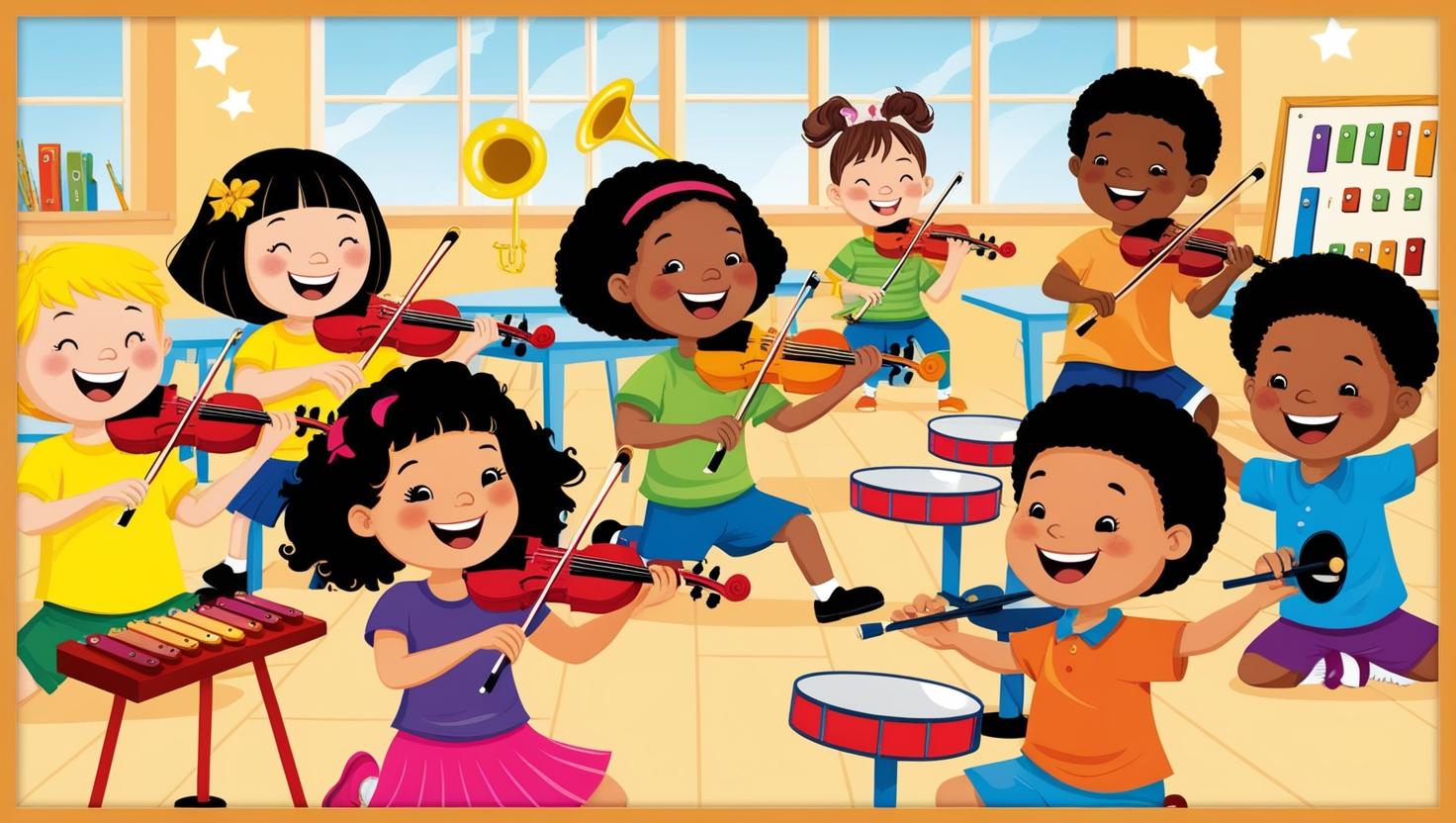
Musical Instruments for Kids
Start him or her learning new music motion through a toy drum set, a xylophone, or maracas. These child-sized, bright, and child-friendly musical instruments are good for sensory play. And developing music will help your toddler improve his/her hand-eye coordination and rhythm.
Cuddly and Plush Toys
Nothing beats the feeling a soft cuddly stuffed animal brings. Plush toys can become best buddies for toddlers when they start associating them with their sense of security. Choose one according to your child’s favorite animal or cartoon character – whether it be a teddy bear or a character from animals.
Interactive Books
Interactive books are one of the best Christmas presents to give your toddler. Check out the books you can gift at Parents Arena. They are enjoyable for toddlers to read since they can also see, feel, and hear. Such books would have pages to lift, textures to feel, or buttons that can produce sounds. Books like these stimulate curiosity and imagination while creating a love for reading in a toddler.
Art Supplies for Toddlers
Clog your toddler’s creativity with toddler-safe art supplies. Non-toxic crayons, washable markers, and finger paints free you from worrying about your little ones expressing themselves with art. Attach an easel or drawing pad for a complete supply package. It is also cool to do art with your child over the holidays.
Ride-Ons
Ride-on toys are good for active toddlers who love moving around. It can be a small trike, a balance bike, or even a toy car-another similar type of toy-it can keep your toddler entertained for some hours while at the same time, improving his or her balance and coordination. Most ride-on toys come with lights and sounds to keep your toddler focused on playing.
Puzzle Sets
Puzzles are excellent boredom-busters for toddlers. Puzzles might serve as a great challenge for toddlers while keeping them amused. Opt for puzzles with big chunky pieces easy to grasp with a small hand. Puzzles with animals or alphabets are trending right now to increase your toddler’s knowledge as they have fun.
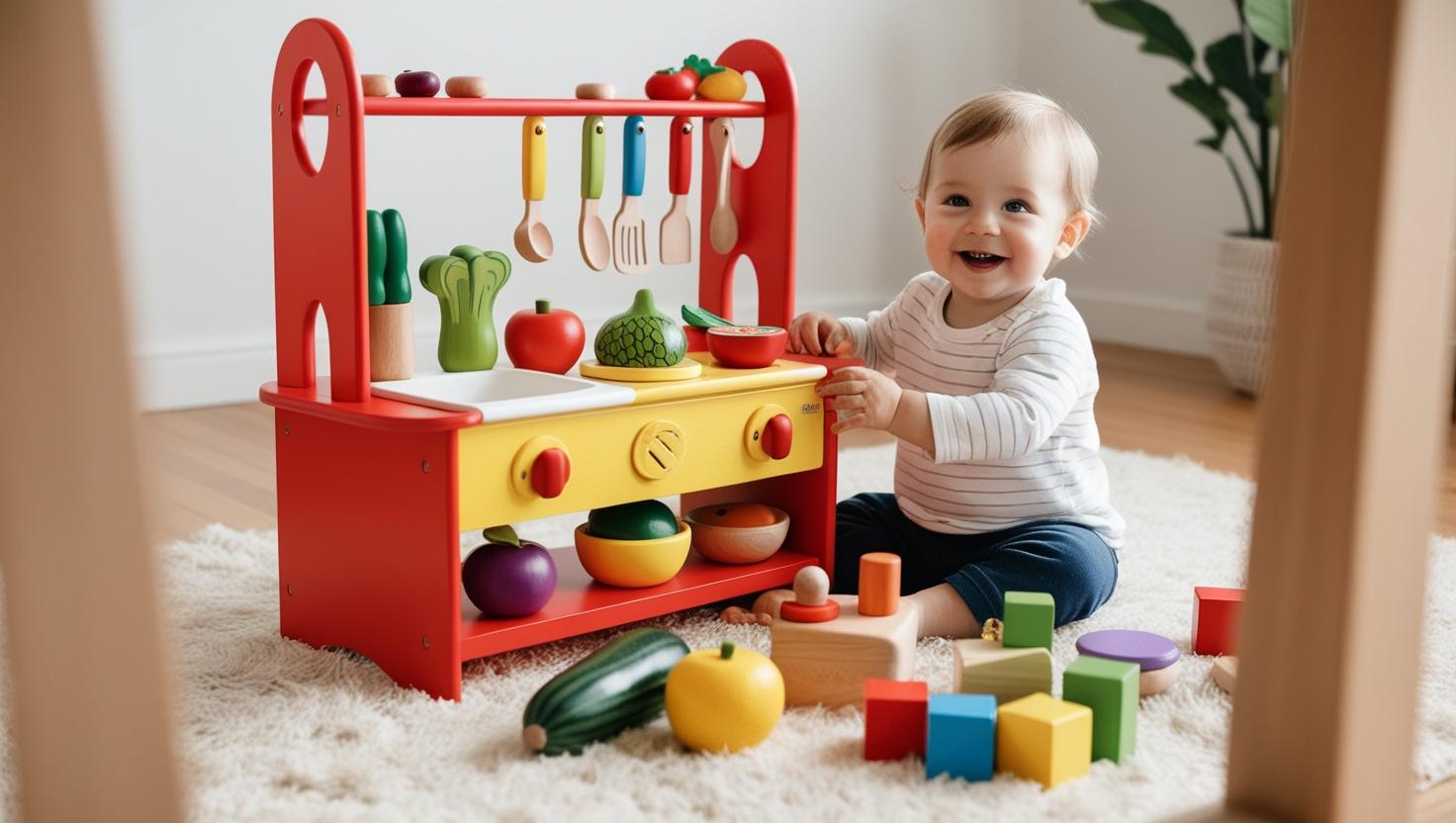
A Pretend Play Set Prepares a Toddler’s Mind
Children love to pretend and play their parts in life, which pretend playsets provide. It could be a play kitchen, a doctor kit, or a toolset that comes with mouth-running to inspire one into imagination, and again teach social situations. It means toddlers can role-play, investigate ideas, and discover the way of life in really fun ways.
Stackable Toys
Simple stacking toys evoke big entertainment thrills among toddlers. They also improve hand-eye coordination and problem-solving skills. The colorful stacking rings or cups are appropriate for preschoolers from birth to 30 months old.
Personalized Gifts
What with Christmas around, do a personal touch on gift-giving this time. You can have items like personalized storybooks, blankets, or even a puzzle with your toddler’s name on it that will be one-of-a-kind. Adding these little treasures to childhood memories creates a lifetime of loving thought.
Your search for the best Christmas presents for your toddler need not be exhausting, be it wooden blocks as classics or something more creative – art supplies or fun craft kits. Above all, presenting should be indeed a matter of the heart. Nothing makes the holiday season more magical than watching your toddler’s face light up as he or she unwraps a gift.
So, pick any of these ten best Christmas presents and fill your baby’s Christmas with memories. The truth is that the greatest gifts leave behind the most beautiful radiant memories in the hearts and lives of our loved ones.

The Ultimate Homework Help Guide for Parents
Homework help is an essential element of the kid’s learning journey. It supports what they acquire from school and teaches them responsibility. Thus, homework time can sometimes be a challenge for the child as well as the parents; the good news is, there are lots of ways parents can help to make homework a less stressful, more productive time for their children. Here are several simple and practical ways by which parents can help their kids with homework:
Homework Routine Is A Must
One of the foremost practices to help your child with homework help is to set up a constant routine. Allocate a specific time each day when your child should be sitting down for homework sessions. This can either be immediately after school, right before dinner, or at night, thus assisting with creating discipline and helping kids stay grounded.
Provide a Quiet and Comfortable Space
Dedicate an area to homework help because it makes a significant difference. Go with peaceful spaces with very little distraction in your home. It could be a well-lighted area, accompanied by a comfortable chair, plus all the supplies your child requires, like pencils, erasers, notebooks, and others. A clean and organized workspace helps children delve better.
Show Interest and Be Involved
Kids are more likely to stay motivated when they realize that their parents can care about them and their education. Ask them about the homework help. Show interest in what they do and encourage good learning. Thus, their confidence is boosted with the knowledge that their attempts are appreciated.
Time Management
Time management is an essential skill that will benefit your child throughout life. Teach your child to break homework down into smaller tasks, with a date assigned to each for its completion. For example, say they have a math worksheet plus an essay to write; they should finish one of these before the other can be started. Using a timer can help them stay focused and keep procrastination away.
Do Not Do Their Homework for Them
It is tempting to step in and do your child’s homework help when he or she is struggling. Such a course does not pay off in time. Instead, you can guide the child through the problem. Encourage them to think critically and derive solutions independently by asking questions. You are there to support their learning, not to take it from them.
Encourage Breaks
Kids who sit for long hours get tired and frustrated. Small breaks in between tasks should be encouraged. A five-minute stretch, having a quick snack, or stepping outside for fresh air could give them a refresh and enhance concentration.
Resource Utilization
If your child is stuck with homework help, then he/she has to utilize the resources that are already there to understand the topic from other perspectives. Books, educational websites, and videos can simplify that. Now, there are so many online sites that offer help with assignment writing, tutoring, and interactive lessons. Use these tools to make the process of learning fun.
Communication with Teachers
Do not shy away from communicating with teachers concerning their students. The teachers might tell you the learning styles of your kids and suggest some approaches to offload their work. They can also modify the assignment in case it is deemed too difficult for the child.
Note their Valuable Efforts
Children do respond to positive reinforcement. They should be acknowledged even for their hardest efforts and the smallest accomplishments. Just saying something simple like “Great Job!” or “I’m so proud of you” will keep them going and pushing hard for results. Don’t just focus on the outcome and homework help. Let them see how much effort they put in even when results aren’t showing.
Be Patient
It is perfectly fine for children to learn at different paces. Specific happenings might take longer than expected or maybe the child would have to spend extra time or effort in learning that one specific subject. Be patient and supportive. Your calm and understanding attitude works like an ointment for anxiety and builds confidence.
Set up an example
Teach them the drive of hard work and good learning by the learning example itself. You could read a book or maybe work on a project or solve puzzles, while your child is busy with homework help. Be this as it may, the positive and active learning environment finds itself very rich at home.
Growth Mindset
Set an example, for instance, by reading a book, working on a project, or solving a puzzle while your child is doing their homework. In this way, children learn by observing relatives mainly if they see them involved in the same activities. Exercising for learning, like fixing a problem using the computer, will strengthen the child’s perseverance and foster his or her growth mindset.
The right setting, backing, and maneuvers that will help your child learn awesome skills such as time management and problem-solving are what will help. Day by day, homework help can be converted into something very nice for your child where it grows into something that will help that child flourish not only in school but throughout life.

10 Parenting Lessons You Should Learn From Your Parents
As much as parenting is a journey full of fun and happiness, it is also known to be one of the greatest jobs of a lifetime. Often, parents teach us the greatest possible lessons in life. Generally, experiences, values, and how they were normally raised guide us in raising our children. So here we give you ten such valuable lessons from parents that could be passed on from your parents to create a healthy environment for your kids:
It is important to have patience
Of all the parenting lessons parents teach us, one of the most important is patience. It takes time, energy, and understanding to raise a child. Remember how your parents waited as you tied your shoelaces or learned to ride a bike, now, be as patient with your children as they grow and learn at their own pace.
Be a role model
An imitation of what they saw is always what children learn. If your parents were kind to each other, you probably were taught to be honest, resilient, and so on. Your child will mirror your qualities if you want him to have such traits by practicing them on your own.
Power comes from routine
Routine gives children security. There had been dinner times, bedtime stories, or weekend outings that were a big part of your life and passed more or less by giving you a structured environment. Continue this feeling of stability by creating regular family rituals.
It’s important to work hard
Unconditional love. Your parents loved you through every tantrum, scraped knee, and school performance. Giving your children the same unconditional love and support and telling them that your love won’t ever be dependent on their achievements or behavior.
Assets in their entirety
Assets in their entirety is one of the greatest parenting lessons of all time. Many parents are worried about getting through this aspect of hard work and perseverance. They were diligent at their workplace and demonstrated their work ethics to make us learn that work pays off. They further instill values of how good it feels to work hard and fight for something.
Time with family and friends should be treasured
Quality time spent together as a family is more vital in today’s hectic world than ever before. Remember those movie nights or strolls in the park with your parents? Make similar memories with your children, moments when families build up the bonds.
Don’t forget to thank
Your parents probably taught you one of the parenting lessons to say ‘thank you’ or be thankful for what you have. Teaching your children the discipline of developing those attributes will make it easy for them to grow as positive and humble individuals.
Establish independence by persuading
Even the best parents, who will always be there for their kids, allow their children to learn from their choices and mistakes. Provide necessary guidance, but let your children be independent.
Respect is to be earned and given
From respecting elders to valuing others’ opinions, your parents likely modeled respectful behavior. Teach your children the importance of mutual respect in relationships, both inside and outside the family.
At Last, show unconditional love
Love from a parent should always be there, come hell or high water. It gives your child a sense of security and self-worth.
Parenting is ongoing love, learning, and growth. Reflect on the parenting lessons your parents taught you, and you will keep building a strong basis for your family. Each child is unique, but the core principles are similar-patience, love, and guidance.
While taking these ageless parenting lessons, know that no parent is perfect. What matters most is the effort that counts and the love you devote to raising your children.

Top 10 Parenting Lessons to Learn from Lord Krishna
Parenting is an adventure full of love and experiences that one undertakes. Parents wish and hope to see their children lead a life full of values and meaning. While examples of modern parenting abound, ancient Indian wisdom offers timeless lessons. The life story of Lord Krishna is amongst the greatest inspirations; divine and deeply human. His relationship with his parents, caretakers, and disciples extends an exceptional insight into nurturing children.
Let us now look into all these parenting lessons from Lord Krishna’s life in the course of parenting.
Trust Your Child’s Potential
One of the greater parenting lessons that Yashoda and Nanda, Krishna’s foster parents, have left for all the parents is that they had always viewed their child as gifted with special abilities. They never gave up trust in him, nor did they ever underestimate him. They gently corrected him for his pranks, such as stealing butter, rather than punishing him severely.
Parenting Tip: Every child is gifted with unique potential. Do not try to curb their instincts; inspire them with boundless love and trust. Take pride in their individuality. Allow them the freedom to explore and grow.
Be a Role Model
The courage and the self-sacrifice shown by Krishna’s biological mother and father, Devaki and Vasudeva respectively, were immense. Suffering for long periods would never etch their virtue. The same suffered by Lord Krishna was an inspiration for him to defend the downtrodden and work for justice.
Parenting Tip: Your children will reflect you. So, whatever you do, imbibe these values: Courage, kindness; integrity. Your actions will teach your children more than your words ever could.
Teach Through Stories and Play
Krishna loved to narrate stories from childhood, and simple stories turned into profound parenting lessons. He explained the universe by showing his cosmic form and imparted lessons through playfulness. He engaged with the children and kept the lessons engaging and memorable.
Parenting Tip: The more fun lessons are, the better children learn. Do the teaching through moral stories, games, and real-life examples of virtues like honesty, compassion, and perseverance.
Encourage Curiosity
Questions formed the very foundation of Krishna’s childhood. Whatever questions he asked, be it about shooting stars or riddles of life, would find answers in the face of Yashoda, who answered Krishna’s questions with admirable patience and wisdom.
Parenting Tip: Inspire your child to be curious and ask questions about the universe. Curiosity indicates intelligence and creativity. A discussion with them would nurture the child’s curious mind.
Accept Their Defects
Wherever Krishna went, he left behind a trail of mischief that earned him the nickname of “Makhan Chor” (butter thief). Instead of scolding or punishing him, his parents lovingly accepted his defect and guided him with great care.
Parenting Tip: Perfect and imperfect are two oppositional sides of the same coin. The better way to go is to accept the child’s flaws and gently guide him on the right path. The focus is more on modification of behavior and less on being judgmental of the self-esteem of a child.
Teach Responsibility Early
In his childhood, Krishna was tasked with the melliferous duty of the protection of cows and nurturing the Gokul community. This was a way to nurture leadership and responsibility at a young age.
Parenting Tip: Let children share responsibilities according to their age. Chores and assignments develop the virtues of accountability and confidence in a child.
Balance Discipline with Freedom
The parenting style of Krishna included a mix of discipline and freedom for him to play freely and express himself while realizing where the boundaries lay.
Parenting Tip: Provide firm guidance on the boundaries you set, but grant the child freedom to make decisions. Balance of freedom aids in developing independence coupled with the understanding of how important rules actually are.
Instill the Value of Friendship
Krishna says that his indomitable faith in his friends forms the very basis of friendship. There is nothing more famous than Krishna’s humility and faithfulness in friendship, particularly with Sudama.
Parenting tip: Teach your child about meaningful relationships. Approach them kindly, loyally, and empathetic toward friends. Help them understand that trust and respect are the cornerstones of relationships.
Preparation for Life’s Challenges
Since childhood, Krishna has encountered huge challenges, including threats from Kansa. Nevertheless, Krishna grew up courageous and tenacious, supported by a bunch of his loved ones.
Parenting tip: If life isn’t easy for your child, you should help them prepare for it. Teach them qualities like resilience, problem-solving, and a positive attitude.
Raise Awareness of Knowledge
In the Bhagavad Gita, Krishna spoke of knowledge and self-awareness. Through knowledge and scrutiny, he aided Arjuna in conquering doubts and fears.
Parenting tip: Encourage your child to learn from experience and take learning away from experiences. Teach them the importance of reflecting on their actions and learning from their experiences.
Similar to life itself, parenting is a divine journey. The life of Lord Krishna is a treasure trove of parenting lessons that tell us to lead us with love, patience, and wisdom. Let them trust their kids, allow their unique perspectives to emerge, and emulate those unrealized values to steer them toward an enigmatic and meaningful future.

A Guide To Family Road Trips With Kids
An empty road and a full backseat make for the ideal family road trip. But the path the trip takes relies primarily on how well you plan. You’ve probably already thought about the basics like snacks, toys, and fully-charged tablets, but there’s likely something you’ve ignored.
That’s why we’ve made a complete guide to family road trips with kids before you head out on your family vacation. It includes expert tips on smart packing, staying safe, keeping the kids entertained, and setting rules for a smooth trip.
First of all, know your limits
If your kids can’t bear a two-hour drive to Grandma’s without crying, this might not be the most suitable way to dive into a long cross-country journey.
Begin with more concise trips and work your way up. Discover what time of day works best for driving, that may be, early morning, overnight, or afternoon.
Understanding your limits, like how many hours you can drive each day without losing your cool, will help you plan a road trip that’s much more fun for everyone!
Timing is everything
It’s almost unimaginable to prepare for a road trip with kids without considering the timing. Also, it is one of the vital aspects of the guide to family road trips with kids. Think about their everyday routines and push to schedule your drive around nap times or bedtime. If they’re sleeping, you’ll have a much calmer ride.
Beginning early in the morning can likewise work well. Children are usually more pleased after a sound night’s sleep and an ample breakfast, which can make the trip a lot downier.
Let kids help plan pit stops
It is nearly impossible to keep kids satisfied in the car for long periods without giving them something to look ahead to. A terrific idea is to plan stops at galleries, aquariums, or historical landmarks along the way.
Take a glance at a map and see what attractions are near your destination. This might be your only chance to explore that area, so if something catches your eye, take the detour! Let your kids join in on the planning, too—they can help pick some of the stops to make the trip even more exciting.
Provide easy access to snacks.
There’s nothing more frustrating than kids constantly asking for snacks, so we’ve found it helps to give them a little more control over the snack bag. For older kids, we provide a small container of easy-to-eat snacks they can help themselves with.
For younger kids, we make a snack mix of their favourites—like goldfish, Cheerios, and raisins—in a snack cup with a handle. We just refill it as needed, and it keeps everyone happy!
Gather the gadgets
You’ll likely fill plenty of devices for your road trip—like smartphones, tablets, e-readers, and portable DVD players (don’t ignore grabbing some DVDs from the library). Ensure you gather everything ahead of time and completely charge before you leave.
Having your iPod pass away an hour into a long drive is the most sinister thing that can happen. Even worse? When only one gadget runs out of battery, leading to a backseat tug-of-war over the other one!
Surprise your kids
Surprising is also one of the important aspects of the guide to family road trips with kids. Kids feel closer to you when you give them things they love, like visiting their favorite places or surprising them with their favorite toys and chocolates. They truly cherish these moments and remember them for years to come. Adding a little surprise for them during a road trip can make it extra special and unforgettable! Know more about kids and preschoolers at Parents Arena.
At Last, think about comfort and convenience
Road trips can be a lot of delight, but they can likewise get tiring and irritating—particularly if you’re voyaging with immature children. To make the passage downier and more pleasant, it’s essential to plan and pack the right necessities.
And there you have it, the ultimate guide to family road trips with kids!
Try initiating your drive earlier in the morning or near bedtime so the kids can rest through a few hours of the journey. Keep them in their pajamas and load a covering and pillow to make the conveyance extra comfortable for them.

Why Panda Parenting Makes Sense
Parenting is a journey fraught with challenges, attachment, and wisdom. With numerous parenting styles out there, choosing which one is best is particularly challenging. One style gaining traction is Panda Parenting. If you wonder what this is and why it makes sense, let’s break it down.
What is Panda Parenting?
Panda Parenting draws motivation from the aspects that pandas are gentle yet firm. This approach concentrates on being supportive and caring while motivating kids to explore, solve troubles, and learn from their experiences. Rather than controlling every decision or cracking every issue for the kid, panda parents step in when truly required, thereby allowing their kids to grow more independently.
Why is Panda Parenting a Good Idea?
Builds Confidence in Kids
When parents allow children to try new things and figure out problems on their own, it fosters self-esteem in them. They learn that mistakes are okay and that what’s possible is to overcome them.
Promotes Independence
Children brought up by the panda parenting system learn to think independently. In this, they acquire skills such as decision-making and problem-solving among others as they grow into different stages of life.
Fosters Emotional Strength
Panda parenting guides kids on how to haggle with dissatisfaction, frustration, and other sentiments by giving them room to take care of their emotions. It is an ideal way to build dynamic stability in children for the ups and downs of life.
Does not Abandon
Panda parents do not leave their children to fend for themselves totally. They are there, providing love and management at appropriate times. This helps in creating the right balance of freedom and support.
Readies Kids for Life as It Is
Life is not a bed of roses, and panda parenting teaches children as much early in life. By allowing them to feel small failures and successes in a secure environment, parents prepare them for the big falls of the future.
Steps to Panda Parent
Be Observant: Observe what your child is doing and feeling so that you know just when to intervene and just when to let them learn from their mistakes on their own.
Stay Calm: Do not try to solve every little problem for your child. Give them some opportunities to try first.
Be Supportive: Encourage your child with kind words and offer help when necessary.
Teach by Example: Show your child how you also solve problems or deal with emotions in your life in healthy ways.
Panda parenting seeks to find a balance between overprotection and do-nothingness. As such, panda parenting inculcates critical life lessons and holds the child tight, close enough to a guiding parent. Allowing children to grow through experiences knowing they are loved and guided is what makes them blossom into strong and confident personalities.
So, if you’re looking for a way to raise happy, independent, and emotionally strong kids, Panda Parenting might just be the perfect style for you!

A Growth Mindset is the Secret to Success; Find Out!
Do you ever feel stuck, like you just aren’t good at something and never will be? If so, you’re not alone. Many of us feel this way because we have what’s called a “fixed mindset.” But the great news is that you can change this! By adopting a growth mindset, you can open the doors to realizing your true potential and achieving so much more than you ever thought you could.
Let’s talk a bit about a growth mindset and how you can develop it.
What Is a Growth Mindset?
A growth mindset is the view that your abilities and intelligence can be developed through hard work, learning, and persistence. People with a growth mindset instead of saying, “I can’t do this,” say, “I can’t do this yet, but I can learn.”
Rather than seeing challenges as barriers, it’s about seeing them as prospects for development.
Steps to Developing a Growth Mindset
Take on Challenges
Don’t avoid difficult tasks. You grow with challenges. The next time you encounter something hard, remind yourself that every expert once was a beginner.
Tip: Try one thing in a day that pushes you out of your comfort zone.
Learn from Mistakes
Failure is not the end, but a stepping stone. The minute you take steps that prove to be failures, you learn something valuable. Consider failure as feedback, not as a personal flaw.
Tip: Ask yourself anytime you experience a setback: What’s the thing that I can do differently next time?
Replace Negative Self Talk
Catch yourself saying or thinking, for instance, “I’m not smart enough.” Change these thoughts to positive words such as “I’m learning and becoming better every day.
Tip: Keep a journal of positive affirmations and read them often.
Value Effort Over Talent
Natural skill is amazing, but measure is what drives success. Individuals with a growth perspective know that working hard and staying constant will get them closer to their objectives.
Tip: Mark your small wins and identify the measures you put in to achieve them.
Get In Contact With Individuals Who Have a Growth Mindset
The conditions you reside in have a considerable influence on your attitude. You should spend time with individuals who support you to develop, teach you new things, and help you on your journey.
Tip: Become part of communities, groups, or workshops where you can discover new aptitudes and share thoughts.
Keep Learning
A growth mindset thrives on continuous learning. Stay inquisitive and open-minded to new wisdom. Whether it’s reading, taking a course, or trying a unique pursuit, keep developing your knacks.
Tip: Devote 15-30 minutes daily to discovering something unexplored.
Why It’s Worth It
Developing a growth mindset takes time and measure, but the rewards are invaluable. You’ll encounter challenges confidently, view errors as prospects, and continually enhance yourself.
Remember: Your mind is like a muscle. The more you utilize it and stretch it, the more powerful it evolves. So begin today—welcome the idea that you can develop, and observe how it transforms your life.
Having a growth mindset is not just about success; it’s about enjoying the ride of becoming the best version of yourself. Believe in these capabilities; work on them; we promise you will see the difference.

Parents Arena: Parenthood’s Second Phase, Childhood’s First Phase
Throughout a person’s life, there are different phases with different challenges and joys. Parents and children so often find their phases intersecting in curious ways. When their parents are in that “second phase of life” — settling, finding a balance, and perhaps now with new responsibilities — the children are just entering their “first phase.” The first phase has all the exploratory excitement, discovering things, and learning. Although these two phases are disparate, they share something so special: both need love, care, and acceptance for them to be well.
What Constitutes a “Second Phase” for Parents?
This is the time when parents enter their second phase. They could be in either their 40s or their 50s, wherein people are already thinking about career development, planning for the future, or even caring for their aging parents. Indeed, it’s the balancing phase regarding work, family, health, and personal dreams.
You can ask questions related to parenting at Parents Arena and receive expert guidance.
Parents may have achieved some of their goals. At the same time, they may now be prepared to be more focused on their development, interests, and well-being.
The “First Phase” for Children
The first stage of life for a child is one of learning and growing. It is the time when they look up for direction, security, and encouragement from their parents. There is no end to the energy, curiosity, and creativity of a child. He lives things anew because everything feels novel and thrilling. This is the stage when the child is expected to be socialized and to gain patience and comprehension. He learns about himself, the world, and how to live through everything surrounding him. The parent can guide the child in building trust, safe exploration, and hopefully a place in the world.
How These Phases Shape the Family Bond
Although the two phases are different, they offer the potential for a strong family bond: The older, wiser, and more experienced parents can add substance, while the younger children in their initial phase bring freshness and joy. Recognition of such differences makes for a fantastic balancing act for families. Find more at Parents Arena.
A good time is also when parents can share their life experiences with children and get reminded by the latter how to look at life with wonder. This is also the time when parents can give examples of how to manage challenges and changes, which will be adopted by the children into their future.
Second Phase: Supporting Children in Their First Phase
Tips for Parents in Their Second Phase: Supporting Children in Their First Phase
Be Patient: They are learning, and it takes time. It shows them that they matter and that you’re there for them.
Share Your Stories: Let them learn from your experiences. Your stories can help them feel connected to you, understand life better, and integrate the lessons learned from their own experience.
Keep Growing Together: Just because you’re in your second phase doesn’t mean you stop learning or growing. Welcome new things with them-it is a great way to stay close to them.
Make Memories: Time passes too fast. Count each moment that you spend with your love. Shared experiences strengthen the bond between lovers and add happy moments to their lives.
More information can be found at Parents Arena, where you can ask questions related to parenting.
Each phase of life is somehow different, but all these differences make family so special. It can bring families closer to each other by embracing these phases with open minds and hearts, setting a base of love and understanding that will last for generations.

A List of 10 Things to See When Adopting a Child
Adopting a child is a significant and remarkable measure. It’s all about giving a child a residence and evolving as an affectionate parent. But before beginning the journey, there are a few essential things you must look for and consider. Here is a checklist of 10 things to check when adopting a child:
Understand the Adoption Process
Every country and state has different adoption rules. Some adoptions are via agencies, while others may be confidential. Make sure to learn how the approach works where you live so there are no wonders.
Know Your Reasons for Adopting
Take time to reflect on why you want to adopt. Is it to expand your family, help a child in need, or for other private reasons? Understanding your “why” will get you through the process.
Select the Correct Form of Adoption
There are documents of adoption: domestic, international, foster-to-adopt, or kinship adoption (adopting a family member). Reflect on what is best for your family and situation.
Check Your Finances
Adoption might be expensive: agency fees, legal fees, travel. Be prepared financially in the same way you need to be for raising a child-to include food, education, and medical care.
Prepare Your Home When Adopting a Child
You do not need to live in a villa, but you should provide a house for a kid who is secure and affectionate. Give the child space, secure facilities, and a warm climate where the child feels free and cared for.
Learn About the Child’s Background
Every child has a story, especially in adoption: understand their experiences, any medical or emotional needs that they may have, and what life was like before they met you. This will prepare you to support them better.
Be Ready for a Home Study
A home study is when a social worker comes to visit you to check whether you are ready to adopt. They will visit your house, ask questions, and look at your background. It is a way of ensuring that the child is safe and happy with you. Be open, honest, and prepared for this step.
Be Prepared for Emotional Changes
Adopting a child can bring about much emotion that a kid has to go through; think of how this might keep you and your adopted child at odds. It rarely goes well right after its adoption. Prepare to endure the patience to give them time. You may go with this child to support groups for adoption or ask for a counselor when in need.
Understand Support After Adoption
Many agencies and organizations provide post-adoption support following an adoption. Many include counseling, parenting classes, or special events for adopted families. Knowing what’s available can help you get through the difficult moments after you bring your child home.
Keep an Open Mind and Be Flexible
No two adoption stories are ever the same. Expect change and embrace learning processes as you build a new life with your child together.
Adopting a child is a beautiful journey that brings with it challenges and rewards. Considering these 10 things can help you better prepare to give a child a loving home.

How Much Time Should I Let My Kid Play Video Games?
As guardians or parents, we all desire to make the most suitable determinations for our youngsters, notably when it comes to screen time and video games. It can be challenging to resolve how much time is adequate and what’s too extensive. Video games can be delightful, scholastic, and even social, but too much can influence kids’ health, sleep, and concentration. What is the definitive amount of time to spend? Let’s shatter it down.
Why Children Love Video Games
Video games propose adventure, challenges, and imagination—all things that inherently lure children. They also provide a way to bond with buddies, particularly via multiplayer games. With suitable limitations, video games can be a wholesome part of your kid’s life.
Suggested Time by Age
Professionals typically present the following:
On weekdays, children who are under 6 years should play for approximately 30 minutes to 1 hour, and on weekends, they should play for at least 2 hours.
Kids aged 6 to 12 spend approximately one hour during the school week and about three hours on the weekends.
If it continues to impact schoolwork or sociable activities, it’s crucial to mark it. Teens (13 and up): 1.5-2 hours per day is fair, but it must not influence schoolwork or social activities.
Balance is Key
It’s essential to offset video game time with other sports, like outdoor play, homework, assignments, and family time. Specifying a routine can help—like enabling video game time after schoolwork and undertakings are done.
Signs of Too Much Gaming
Look out for these signs that your child might be playing too much:
Mood changes: If they get irritated when asked to stop playing.
Less interest in other activities: If video games become their main interest.
Sleep issues: Playing too close to sleep can make it more challenging for children to wind down and nap.
If you see these symptoms, it may be time to cut back or set more structured boundaries.
Tips for Managing Gaming Time
Set Clear Rules: Choose day-to-day or weekly boundaries and adhere to them.
Create a Reward System: Kids can earn additional gaming time for doing chores, reading, or spending time outdoors.
Encourage Breaks: Remind your kid to take furloughs to stretch or do something else, like reading or playing outdoors.
Join In Sometimes: If it’s right, play with them! It enables you to see what they relish and can be a delightful way to communicate.
Making Gaming a Positive Part of Their Life
Video games can be a favorable affair with a suitable approach and limitations. By enabling your kid to manage their time, you’re introducing them to the extent of balance—something that’s valuable for life, not just gaming. Just remember, it’s okay to modify as required; every kid is different, and the right balance is what works nicely for your family.
Enjoy gaming time with your kid, and utilize it as a way to bond and have fun together!

Top 10 Good Books for Newborns
Introducing good books to newborns is one of the finest ways to help them develop a fondness for reading and learning straightaway from the beginning. Even though they may not understand the terms just yet, the colors, sounds, and the rhythm of your voice help their brainiac prosper. Below are ten good books for newborns that are just an excellent match. These are uncomplicated, bright, and entertaining for both newborns and parents!
Goodnight Moon by Margaret Wise Brown
This classic bedtime story is a must-have for every baby’s library. Its gentle, rhyming text and soothing illustrations make it a perfect book to read to your newborn as part of a bedtime routine.
The Very Hungry Caterpillar by Eric Carle
With colorful, kaleidoscopic images and easy text, these sort of good books for newborns familiarizes babies with counting and additional sorts of food. The simple story is easy to follow, and the textures in some editions add a fun, interactive element.
Guess How Much I Love You by Sam McBratney
This sweet book shows a conversation between Little Nutbrown Hare and Big Nutbrown Hare as they express their love for each other. Its heartwarming message makes it a great choice for snuggling and bonding with your newborn.
Brown Bear, Brown Bear, What Do You See? by Bill Martin Jr. and Eric Carle
The repetitive, rhythmic text and colorful illustrations in this book help develop babies’ recognition of colors and animals. Babies love familiar patterns, and it’s a great way to introduce them to storytelling.
Where Is Baby’s Belly Button? by Karen Katz
This is one of the interactive lift-the-flap good books for newborns and is perfect for curious little hands. It helps babies learn about body parts in a fun and playful way while also building their motor skills through lifting the flaps.
Dear Zoo by Rod Campbell
This lift-the-flap book introduces babies to different animals as they discover what kind of pet would be perfect. The surprises behind each flap make it exciting for little ones, and the simple text keeps them engaged.
Peek-a-Who? by Nina Laden
A perfect board book for babies who love playing peek-a-boo. The colorful illustrations and the surprise element on every page are sure to make your baby giggle with delight.
Pat the Bunny by Dorothy Kunhardt
This is one of the most interactive, touch-and-feel good books for newborns and is a classic. Babies can touch different textures, like soft fur or smooth mirrors, which keeps them engaged while stimulating their senses.
Ten Little Fingers and Ten Little Toes by Mem Fox
This adorable rhyming book celebrates babies all over the world, with beautiful illustrations and simple text. It’s a great way to teach babies about their own little hands and feet.
Baby Faces by DK Publishing
Babies are naturally drawn to other baby faces. This book is filled with close-up pictures of babies making different expressions, which helps your little one recognize and respond to emotions.
The advantages of reading to your baby include bonding, comforting them, and helping their development in the early years. Choose good books for newborns that are easy, bright, and interactive to grab their attention. Whether it’s rest or playtime, these books will create unforgettable memories as you share the joy of reading together.

10 Most Satisfactory Parenting Books
There is no doubt that parenting is a voyage sufficed with adoration, delight, and, at times, overwhelming. You can discover parenting books that furnish practical direction, wisdom, and motivation, whether you’re a new parent or have been raising kids for years. Here are the ten most satisfactory parenting books:
“The Conscious Parent” by Dr. Shefali Tsabary
This book enables parents to be alert and conscious of their own emotions and behaviors. It teaches that parenthood is not just about raising a kid, but also about growing privately and recovering ourselves in the process.
“The Happiest Baby on the Block” by Harvey Karp
For parents with infants, this parenting book offers straightforward strategies to ease a fussy baby and help them sleep better. It’s especially helpful during those early awake nights!
“The 5 Love Languages of Children” by Gary Chapman and Ross Campbell
Every kid voices and receives love differently. This book enables you to find your child’s immediate love language, whether it’s physical touch, words of promise, or something else, so you can unite with them in a way that counts the most.
“Raising an Emotionally Intelligent Child” by John Gottman
This book concentrates on emotional intelligence and how to help kids understand and express their emotions wholesomely. It provides valuable direction for teaching kids via their emotional ups and downs.
“Simplicity Parenting” by Kim John Payne
In today’s fast-paced world, kids frequently feel overwhelmed by too much stuff and numerous activities. This book offers parents how to facilitate their child’s environment to relieve stress and let them concentrate on what’s vital.
“No-Drama Discipline” by Daniel J. Siegel and Tina Payne Bryson
Discipline doesn’t have to involve yelling or penalties. This one of the parenting books concentrates on bonding with your kid during hard moments and utilizing discipline as a way to teach, not penalize, for long-term learning.
“Positive Discipline” by Jane Nelsen
This book helps parents teach their kids essential life skills like commitment, consideration, and problem-solving without utilizing punishment. The positive discipline approach is about being kind yet firm, encouraging collaboration and understanding.
“The Whole-Brain Child” by Daniel J. Siegel and Tina Payne Bryson
This book helps parents understand how a kid’s brainiac originates. With clear illustrations, it introduces how to foster a child’s emotional and academic growth by utilizing strategies that help them address their feelings and behavior.
“How to Talk So Kids Will Listen & Listen So Kids Will Talk” by Adele Faber and Elaine Mazlish
Communication is key to building a wholesome affinity with your kid. This classic book offers valuable techniques for enhancing how you talk and listen to your children, making them feel attended and appreciated.
“Parenting with Love and Logic” by Charles Fay and Foster Cline
This is one of the parenting books that facilitates parents to grow trustworthy, self-reliant kids by giving them choices and allowing them to learn from their blunders in a caring and supportive atmosphere.
These parenting books cover a wide range of parenting styles and methods, helping parents at different phases of their journey. Whether you’re looking to enhance communication, manage discipline, or understand your kid’s emotions, these resources will provide you with the advice and support you need.

100 Fun Questions To Ask Your Little Kid
Children are full of creativity, and occasionally, the most joy you can have with them is simply by asking a few simple questions. Whether you’re on a long car ride, sitting at the dinner table, or merely looking for some quality bonding time, these fun questions can spark their imagination, help you get to know them better, and even lead to some chuckles! Here are 100 fun questions to ask your little kid.
- If you could have any superpower, what would it be?
- What’s your favorite animal, and why?
- If you could fly anywhere in the world, where would you go?
- What’s your favorite color of the rainbow?
- If you could be a cartoon character for a day, who would you be?
- What do you love most about your friends?
- What’s your favorite food to eat for dinner?
- If you could only eat one food for the rest of your life, what would it be?
- What’s the funniest thing you’ve ever seen?
- If your toys could talk, what would they say?
- What’s your favorite thing to do outside?
- What would you name a pet dragon?
- If you built a treehouse, what would it look like?
- What’s the best part about being a kid?
- What’s something that always makes you laugh?
- If you could grow anything in the garden, what would you grow?
- What’s your dream job when you grow up?
- If you were a parent for a day, what would you do?
- Who is your favorite superhero?
- If you could make up a holiday, what would it be about?
Amusing questions to ask your little kid
- What’s the silliest thing you’ve ever done?
- What’s your favorite bedtime story?
- If you were invisible for a day, what would you do?
- What’s your favorite thing to learn about in school?
- If you could live anywhere, where would it be?
- What’s your favorite way to spend a rainy day?
- If you could have any pet, what would it be?
- What’s your favorite song to dance to?
- If you could meet a famous person, who would it be?
- What’s the coolest thing you’ve ever built with blocks?
- If you could make a new flavor of ice cream, what would it be?
- What’s your favorite game to play?
- If you were a superhero, what would your costume look like?
- What’s the best thing about your family?
- If you could visit outer space, what would you want to see?
- What’s your favorite kind of birthday cake?
- What’s your favorite animal sound?
- If you could design your own playground, what would it have?
- What’s your favorite thing to draw or paint?
- If you were a character in a movie, what would the movie be about?
Delightful questions to ask your little kid
- What’s the best gift you’ve ever gotten?
- What’s your favorite season, and why?
- If you could switch places with your teacher for a day, what would you teach?
- What’s your favorite snack?
- What’s the most fun you’ve had in a day?
- If you could turn into any animal, what would it be?
- What’s your favorite thing to wear?
- What do you think is the best thing about being a grown-up?
- What’s your favorite holiday, and why?
- If you had a robot, what would it do for you?
- What’s the best adventure you’ve ever been on?
- If you could make a new rule for the house, what would it be?
- What’s the most exciting thing you’ve ever done?
- If you could change your name, what would you pick?
- What’s your favorite thing to do with your friends?
- What’s the funniest joke you know?
- If you could have any animal as a pet, what would it be?
- What’s your favorite part of the day?
- If you were a magician, what would your first magic trick be?
- What’s your favorite breakfast food?
Questions to ask your little kid
- If you could visit any place in the world, where would you go?
- What’s your favorite cartoon to watch?
- If you could invent something, what would it be?
- What’s the best surprise you’ve ever had?
- If you could make a new animal, what would it look like?
- What’s your favorite thing about school?
- If you could stay up all night, what would you do?
- What’s the silliest sound you can make?
- If you could have a super fast car, where would you drive?
- What’s the best dream you’ve ever had?
- If you could jump into a book, which one would you pick?
- What’s your favorite fruit?
- If you could create a new sport, what would it be?
- What’s your favorite thing about the weekend?
- If you could visit a time in the past, where would you go?
- What’s the best thing about your bedroom?
- If you could only wear one outfit for a whole week, what would it be?
- What’s your favorite thing to do at recess?
- If you could talk to animals, what would you say to them?
- What’s your favorite toy?
Fun questions to ask your little kid
- If you were a chef, what would you cook?
- What’s your favorite color?
- If you could invent a new toy, what would it be?
- What’s the funniest thing someone has ever said to you?
- If you were a pirate, where would you sail your ship?
- What’s your favorite dessert?
- If you could make a new friend, who would it be?
- What’s your favorite thing about the park?
- If you could decorate a room in any way you wanted, what would it look like?
- What’s the best present you’ve ever given someone?
- If you could fly in a hot air balloon, where would you go?
- What’s your favorite ice cream topping?
- If you were an astronaut, what planet would you visit?
- What’s the silliest face you can make?
- If you could meet a talking animal, what would you ask?
- What’s your favorite thing about your birthday?
- If you could make a wish right now, what would it be?
- What’s your favorite word to say?
- If you could have any job in the world, what would it be?
- What’s your favorite thing to do with your family?
So here you have, 100 fun questions to ask your little kid.
These questions are a wonderful way to get kids talking, flare their creativity, and learn more about how they see the earth. Whether they’re responding with something foolish or giving you a glimpse into their pursuits, these questions will surely lead to fun conversations and some unforgettable moments!

Which latest parenting trends are making a splash?
Parenting is constantly evolving at a fast pace, and every year brings new thoughts on how to raise glad, wholesome kids. Some fascinating latest parenting trends are making waves, as more parents look for sounder ways to relate with and help their kids. Here are a few of the latest parenting trends that are getting engaged.
Gentle Parenting
Gentle parenting has been rising in favor for a time now, and it resumes to make an effect. This strategy concentrates on understanding a kid’s emotions and requirements, rather than utilizing punishment. Parents who practice gentle parenting aim to direct their youths with compassion, care, and tolerance. They work to create a secure area for children to voice their feelings, helping them learn self-control and emotive code.
Minimalist Parenting
Many parents are adopting minimalist parenting as one of the latest parenting trends. This trend motivates parents to streamline their lives and concentrate on what counts. It’s about receding the mess—both physically and mentally. By having fewer playthings, activities, and duties, families can spend more quality time together and relieve stress. Minimalist parenting highlights experiences over things and enables children to relish what they have.
Screen Time Balance
Managing screen time has consistently been one of the latest parenting trends. Parents are becoming more cautious about how and when their children utilize screens. Rather than completely banning devices, numerous are forming structured agendas that possess educational content along with pleasure, ensuring that screen time is fruitful. The objective is to aid kids develop wholesome tech habits without skipping outdoor activities, hobbies, and face-to-face interactions.
Inclusive Parenting
Inclusive parenting is earning traction as more parents seek to raise socially conscious kids. These latest parenting trends enable families to welcome diversity and guide their kids about diverse cultures, races, and views. Parents are making deliberate efforts to disclose their kids to a variety of affairs, books, and discussions that foster inclusion, compassion, and pity.
Sustainable Parenting
Numerous parents are looking for ways to introduce their children in an eco-friendly manner. Sustainable parenthood concentrates on diminishing junk, employing reusable products, and familiarizing kids regarding environmental duty. From cloth diapers to eco-friendly playthings, more households are prioritizing sustainability in their everyday lives, showing kids the significance of taking care of the world.
Bringing Mental Health to the Public’s Attention
Mental health is evolving as a fundamental focus in parenting. Parents are now more conscious of the importance of keeping their kids’s emotional well-being. This includes being unrestricted to speaking about emotions, seeking help from mental health experts when required, and introducing kids to how to address stress. There’s likewise a growing trend in parents practicing self-care to ensure they’re mentally and emotionally wholesome, which enables them to be better guardians.
Parenting is all about creating a balanced, conscious, and encouraging atmosphere for children. These latest parenting trends display that parents are concentrating on pity, inclusion, and sustainability while adapting to the challenges of everyday life. As we continue to learn and grow as guardians, these trends will probably shape the tomorrow of how we raise our children.

What Is The Meaning Of A Parent? All You Need To Know
Being a parent represents a ton more than just having kids. It’s about devotion, supervision, accountability, and direction. Whether you’re a mother, father, or guardian, parenting is a massive stake of life that shapes not simply your child but even you.
So, What Is a Parent?
A parent is someone who raises and watches a child, regardless of whether they are biological or adopted. Being a parent means being there for them. A parent is an individual who helps, guards, and adores their offspring unconditionally.
Parents enable youngsters to grow, guiding them in everything from how to step and speak to how to be a sound person. They’re there through the ups and downs, coaching kids as they encounter challenges in life.
The Distinct Classes of Parents
- Biological Parents: The ones who give birth to the youth.
- Adoptive Parents: Some parents don’t give birth to their children but instead adopt them. These parents legally take accountability for their kids and love them as they love themselves.
- Step-Parents: Step-parents are individuals who wed someone who has kids from a prior relationship. They may not be the kid’s real parents, but they play a vital role in their lives.
- Guardians: A guardian is someone who takes on the role of a parent when needed. These individuals are often grandparents, relatives, and even housemates.
How do you define a good parent?
A good parent is a person who places their kid’s needs preferably. It’s not constantly about being ideal but doing your best to watch for and love your kid. Here are some markers of good parents:
Love and Support: Kids ought to feel loved and sustained. Parents who show their kids love to help build their trust and self-esteem.
Patience: Raising kids can be difficult, and tolerance is key. Kids make blunders, and parents need to help them learn without failing their spirit.
Guidance: Parents are the foremost educators in a kid’s life. They teach them significance, right from wrong, and how to meet the world.
Consistency: Specifying rules and tracking through with them allows kids to understand limits. Consistency builds a sense of security for children.
Listening and Communicating: Open communication between a parent and kid is important. It helps build confidence and understanding.
Challenges Parents Face
Parenting isn’t ever easy. Parents usually have to juggle work, household, and private life. Occasionally, it’s difficult to discover a balance, and every parent encounters moments of anxiety or suspicion. But at the end of the day, the love for their kid keeps them running.
Standard challenges possess:
- Offsetting work and house life
- Dealing with the Teenage Revolution
- Fearing about the kid’s future
- Addressing financial strains
Despite these challenges, the bond between a parent and youth is one of the most powerful in the world.
So here you have it all, the meaning of a parent and a lot more.
An individual who is a parent values, safeguards, and instructs their child. It’s one of the most compulsory chores anyone can have to shape the life of a kid. No matter if you’re a birth parent, an adoptive parent, or a guardian, it’s one of the most influential jobs anyone can have.!

Top 100 Baby Boy Names Guide With Meaning
Choosing the ideal name for your baby boy is a memorable moment. It’s not solely a name—it’s part of his essence, something that will remain with him permanently. To help you out, here’s the top 30 baby boy names guide with meaning. You’ll find classic names, modern favorites, and amazing picks too!
Baby Boy Names with Meanings
Classic & Timeless Names
Liam – Strong-willed warrior
A popular choice, Liam is short, strong, and easy to say.
Noah – Rest, comfort
Noah is a gentle, timeless name often linked to strength and peace.
Ethan – Strong, firm
Ethan has been a favorite for years and reflects resilience and determination.
James – Supplanter (one who replaces another)
James is a classic name, steeped in history, meaning someone who takes the place of another.
Oliver – Olive tree (symbol of peace)
It is a nature-inspired name symbolizing peace and harmony.
Henry – Ruler of the household
A name of regal heritage, Henry symbolizes leadership and authority in a family.
Alexander – Defender of the people
A strong, historic name, Alexander signifies bravery and protection.
Benjamin – Son of the right-hand
A timeless biblical name, Benjamin represents favor and strength.
William – Strong protector
With royal associations, William embodies resilience and guardianship.
Joseph – He will add (God will increase)
A deeply spiritual name, Joseph conveys blessings and abundance.
Strong & Powerful Boys Names with Meaning
Wyatt – Brave in war
A rugged and bold name, Wyatt signifies courage in battle.
Leo – Lion (symbol of courage)
Short and powerful, Leo represents strength and bravery.
Caleb – Whole-hearted, faithful
A name of deep conviction, Caleb stands for loyalty and devotion.
Owen – Young warrior, noble
With Celtic roots, Owen symbolizes youthfulness and honor.
Samuel – Heard by God
A classic biblical name, Samuel conveys divine connection and wisdom.
Nathaniel – Gift of God
Elegant and meaningful, Nathaniel signifies divine blessing.
Julian – Youthful, full of life
A name that radiates energy, Julian symbolizes vitality and freshness.
Isaac – He will laugh
With biblical origins, Isaac represents joy and happiness.
Mason – Worker in stone
A strong occupational name, Mason reflects craftsmanship and stability.
Gabriel – God is my strength
A heavenly name, Gabriel represents divine support and fortitude.
Modern & Trendy Boy Names with Meaning
Jackson – Son of Jack
A stylish and versatile name, Jackson is both modern and classic.
Aiden – Little fire
This fiery name symbolizes passion and intensity.
Ezra – Help, protector
A name of wisdom and strength, Ezra stands for guidance and support.
Levi – Joined, attached
Short and trendy, Levi represents unity and connection.
Sebastian – Venerable, respected
An elegant and classic name, Sebastian conveys dignity.
Maverick – Independent, nonconformist
A bold name, Maverick represents free spirit and individuality.
Jaxon – God has been gracious
A modern twist on Jackson, Jaxon carries a strong and grateful meaning.
Zayden – Growth, increase
A unique and fresh name, Zayden symbolizes progress.
Grayson – Son of the gray-haired one
A stylish surname-turned-first name, Grayson represents wisdom.
Asher – Happy, blessed
A joyful name, Asher embodies positivity and fortune.
Biblical & Spiritual Baby Boy Names with Meanings
Elijah – My God is Yahweh
A strong biblical name, Elijah symbolizes faith and devotion.
Matthew – Gift of God
A name of divine blessing, Matthew carries deep spiritual significance.
Jacob – Supplanter
One of the most enduring biblical names, Jacob represents transformation.
Daniel – God is my judge
A powerful and righteous name, Daniel conveys wisdom and justice.
Isaiah – God is salvation
A deeply spiritual name, Isaiah represents divine guidance.
David – Beloved
A royal and biblical name, David signifies love and strength.
Jonathan – God has given
A name of generosity and blessing, Jonathan carries a strong meaning.
Micah – Who is like God?
A name of humility and faith, Micah embodies devotion.
Joshua – God is my salvation
A classic biblical name, Joshua represents protection and guidance.
Zion – A holy place
A name of spiritual significance, Zion symbolizes divinity and peace.
Nature-Inspired Baby Names for Boys with Meaning
River – Flowing water
A serene and adventurous name, River symbolizes movement and life.
Atlas – Enduring, the strength of the world
A name of mythological power, Atlas represents strength and perseverance.
Rowan – Little red-haired one, tree name
A nature-based name, Rowan symbolizes wisdom and protection.
Aspen – Tree with heart-shaped leaves
A fresh and modern name, Aspen embodies resilience.
Cedar – Strong, spiritual tree
A name representing strength and endurance, Cedar holds deep roots.
Flint – A hard, strong stone
A short and rugged name, Flint symbolizes toughness.
Phoenix – A mythical bird symbolizing rebirth
A powerful name, Phoenix represents transformation and resilience.
Kai – Sea, ocean
A short and energetic name, Kai embodies nature’s depth and power.
Forrest – Dweller near the woods
A name of peace and nature, Forrest represents tranquility.
Oakley – From the oak tree meadow
A strong and grounded name, Oakley symbolizes stability and growth.
Short & Simple Male Name Meanings
Luke – Light-giving
A name of brightness and clarity, Luke represents illumination.
Ryan – Little king
A regal yet simple name, Ryan signifies leadership.
Eli – Ascended, uplifted
A strong yet short name, Eli embodies spiritual elevation.
Finn – Fair, white
A sleek and stylish name, Finn represents purity.
Cole – Charcoal, dark
A short and cool name, Cole symbolizes depth and mystery.
Nico – Victory of the people
A trendy and international name, Nico conveys triumph.
Zane – God is gracious
A modern and sharp name, Zane symbolizes divine favor.
Tate – Cheerful
A lighthearted and joyful name, Tate embodies happiness.
Jude – Praised
A biblical and meaningful name, Jude represents gratitude.
Max – Greatest
A strong and confident name, Max symbolizes excellence.
Unique & Cool Boy Names and Meanings
Ryder – Knight, warrior
A modern and adventurous name, Ryder symbolizes strength.
Axel – Father of peace
A cool and edgy name, Axel represents harmony.
Blaise – Fire, flame
A fiery and dynamic name, Blaise embodies passion.
Cruz – Cross
A spiritual and sleek name, Cruz symbolizes faith.
Jett – Black gemstone
A sharp and modern name, Jett represents energy and power.
Knox – Round hill
A strong and grounded name, Knox conveys resilience.
Milo – Merciful, soldier
A name of duality, Milo symbolizes both kindness and strength.
Orion – Hunter, constellation name
A celestial name, Orion represents exploration and adventure.
Remy – Oarsman, rower
A stylish and unique name, Remy symbolizes travel and determination.
Zander – Defender of men
A cool variation of Alexander, Zander represents bravery.
Vintage & Old-School Boys Names and Meanings
Arthur – Bear, noble
A regal and legendary name, Arthur symbolizes strength and wisdom.
Felix – Happy, lucky
A cheerful and fortunate name, Felix radiates positivity.
Hugo – Mind, intellect
A sophisticated name, Hugo represents intelligence and deep thought.
Silas – Forest, woods
A nature-inspired name, Silas embodies peace and resilience.
Theodore – Gift of God
A timeless name, Theodore carries a sense of divine blessing.
Walter – Ruler of the army
A strong and classic name, Walter symbolizes leadership and strategy.
Louis – Famous warrior
A name of noble heritage, Louis represents bravery and honor.
Vincent – Conquering
A powerful name, Vincent embodies victory and strength.
Everett – Brave, strong boar
A bold and enduring name, Everett symbolizes tenacity.
Leonard – Brave lion
A name of courage, Leonard represents fierce strength and nobility.
International & Exotic Male Names with Meaning
Diego – Supplanter (Spanish origin)
A vibrant and adventurous name, Diego carries a strong spirit.
Luca – Light-giving (Italian origin)
A soft yet powerful name, Luca symbolizes brightness and guidance.
Mateo – Gift of God (Spanish origin)
A charming and classic name, Mateo represents divine blessing.
Thiago – May God protect (Portuguese origin)
A deeply meaningful name, Thiago conveys faith and protection.
Enzo – Ruler of the home (Italian origin)
A stylish and strong name, Enzo signifies leadership.
Hiro – Abundant, generous (Japanese origin)
A name of kindness and prosperity, Hiro represents generosity.
Emir – Prince, ruler (Arabic origin)
A regal and commanding name, Emir embodies leadership and power.
Nikolai – Victory of the people (Russian origin)
A sophisticated name, Nikolai represents strength and triumph.
Santiago – Saint James (Spanish origin)
A name of faith and tradition, Santiago holds deep historical significance.
Bodhi – Awakening, enlightenment (Sanskrit origin)
A spiritual and profound name, Bodhi symbolizes wisdom and peace.
Futuristic & Sci-Fi Baby Boy Names with Meaning
Apollo – God of prophecy, music
A legendary name, Apollo represents creativity and vision.
Caspian – Inspired by the Caspian Sea
A mysterious and adventurous name, Caspian evokes exploration.
Neo – New, young
A modern and fresh name, Neo symbolizes renewal and innovation.
Zephyr – Gentle wind
A poetic and airy name, Zephyr embodies freedom and movement.
Onyx – A precious black gemstone
A bold and striking name, Onyx represents strength and mystique.
Orpheus – A legendary musician in mythology
A name of artistry and myth, Orpheus signifies music and storytelling.
Solaris – Of the sun
A radiant and celestial name, Solaris symbolizes warmth and energy.
Jorah – Early rain, autumn rain
A unique and soothing name, Jorah conveys renewal and growth.
Dorian – Gift, belonging to Doria
A classic yet futuristic name, Dorian represents refinement.
Nova – A star that shines brightly
A luminous and cosmic name, Nova embodies brilliance and transformation.
So here you have the top 100 baby boy names guide with meaning.
Choosing a name is personal, and each name has a beautiful meaning behind it. Whether you’re drawn to traditional, trendy, or unique names, you’ll discover one that resonates with your heart and feels just right for your little one.

Top 30 Baby Names Guide With Meaning
Choosing the ideal name for your baby is a unique and compelling task. It’s not simply about discovering a name that chimes nicely; the significance behind the name can make it even more special. To assist you in this important decision, we’ve put together a checklist of baby names guide with meanings. Whether you’re looking for something traditional, modern, or unique, there’s something here for everyone.
Popular Baby Names Guide with Meaning
- Emma – A timeless name that means “whole” or “universal.” Perfect for a baby destined to be a loving, caring person.
- Liam – This strong name means “resolute protector.” It’s a great choice for a baby boy who you hope will grow up to be a brave and caring man.
- Olivia – A beautiful name meaning “olive tree,” symbolizing peace and fruitfulness.
- Noah – A classic name that means “rest” or “comfort,” ideal for a calm and gentle boy.
- Sophia – Meaning “wisdom,” this name is perfect for a little girl who will grow up to be smart and thoughtful.
Unique Baby Names
- Aria – A musical name that means “air” or “song,” perfect for a child who will bring harmony into your life.
- Milo – This quirky name means “soldier” or “merciful,” a great choice for a little boy who will grow up strong and kind.
- Luna – A mystical name meaning “moon,” ideal for a child who will light up your world.
- Ezra – A name with biblical roots meaning “help,” perfect for a boy who will grow up to be a dependable friend.
- Nova – Meaning “new,” this name is great for a baby who is your new star in the sky.
Traditional Baby Names Guide with Meaning
- Elizabeth – A regal name that means “pledged to God,” perfect for a girl who will grow up with a strong moral compass.
- William – A classic name meaning “resolute protector,” great for a boy who will be strong and caring.
- Charlotte – This elegant name means “free man,” symbolizing independence and strength.
- James – A strong and timeless name meaning “supplanter,” perfect for a boy who will grow up to be a leader.
- Margaret – Meaning “pearl,” this name is ideal for a girl who will be as precious as a gem.
Nature-Inspired Baby Names
- Willow – A serene name meaning “slender” or “graceful,” ideal for a gentle and graceful girl.
- River – A flowing name, perfect for a child who will have a free spirit.
- Ivy – Meaning “faithfulness,” this name is great for a girl who will grow up strong and enduring.
- Ash – A simple, strong name inspired by the ash tree, perfect for a boy who will be solid and dependable.
- Sage – A name meaning “wise,” ideal for a child who will grow up thoughtful and insightful.
Modern Baby Names Guide with Meaning
- Aiden – A modern name meaning “little fire,” perfect for a boy with a fiery spirit.
- Zoe – A lively name meaning “life,” great for a girl who will bring joy and energy to your life.
- Levi – A trendy name meaning “joined” or “attached,” perfect for a boy who will be close to your heart.
- Mia – A short and sweet name meaning “mine” or “wished-for child,” ideal for your precious little girl.
- Jaxon – A modern twist on Jackson, meaning “God has been gracious,” perfect for a boy who is a blessing.
Names with Powerful Meanings
- Ethan – A strong name meaning “firm” or “strong,” perfect for a boy who will grow up to be resilient.
- Isabella – Meaning “devoted to God,” this name is ideal for a girl who will grow up with a strong spirit.
- Alexander – A powerful name meaning “defender of the people,” perfect for a boy who will stand up for others.
- Grace – A name symbolizing elegance and kindness, ideal for a girl who will be a graceful presence in your life.
- Gabriel – Meaning “God is my strength,” this name is perfect for a boy who will grow up strong in spirit.
Choosing a name is a big decision, but it’s also a fun one. Take your time, explore the baby names guide with meaning options, and most significantly, choose a name that feels right for you and your little one. After all, it’s a name they’ll carry with them for the rest of their life!

The 100 Most Inspirational Parenting Quotes
When a new member joins the household, it becomes a sensational and delightful moment. But with joys come challenges too! Therefore, we’ve compiled 100 inspirational parenting quotes to uplift and support new parents on this amazing journey. These inspirational parenting quotes can offer advice, motivation, and understanding as you steer the parenting path.
Inspiring Parenting Quotes
“Being a parent means loving your children more than you have ever loved yourself.” — Unknown
“Your children will become who you are; so be who you want them to be.” — Unknown
“A child’s laugh could simply be one of the most beautiful sounds in the world.” — Unknown
“The best inheritance a parent can give to his children is a few minutes of his time each day.” — Unknown
“The most precious thing a parent can give a child is their time.” — Unknown
“To love and be loved is to feel the sun from both sides.” — David Viscott
“Children are not a burden but a blessing.” — Unknown
“The best thing to spend on your children is your time.” — Louise Hart
“There is no greater gift than the love of a parent.” — Unknown
“You don’t have to be perfect to be a perfect parent.” — Unknown
“Children are the anchors of a mother’s life.” — Sophocles
“The influence of a mother in the lives of her children is beyond calculation.” — James E. Faust
“A mother’s arms are more comforting than anyone else’s.” — Princess Diana
“Parents aren’t perfect, but they’re perfect for their children.” — Unknown
“Every day with your child is a new adventure.” — Unknown
“The love between a parent and child is forever.” — Unknown
“You have been given the greatest job in the world: to love and guide your child.” — Unknown
“Parenting is not a practice. It is a daily learning experience.” — Unknown
“Children make you want to start life over.” — Muhammad Ali
“The more you give, the more you get. This is true for love and patience with children.” — Unknown
Emotional Parenting Quotes
“The best way to make children good is to make them happy.” — Oscar Wilde
“There is no way to be a perfect parent, but a million ways to be a good one.” — Jill Churchill
“Parenting is not about raising perfect children, but about raising children who are kind and resilient.” — Unknown
“The greatest legacy we can leave our children is happy memories.” — Unknown
“Children are not a distraction from more important work. They are the most important work.” — C.S. Lewis
“To the world, you may be one person, but to one person you may be the world.” — Dr. Seuss
“The most important thing a father can do for his children is to love their mother.” — Theodore Hesburgh
“In raising children, spend half as much money on them and twice as much time.” — Unknown
“A parent’s love is whole no matter how many times it is divided.” — Robert Brault
“Every child begins the world anew.” — Unknown
“There is no such thing as a perfect parent. So just be a real one.” — Sue Atkins
“The heart of a father is the masterpiece of nature.” — Antoine François Prévost
“The way we talk to our children becomes their inner voice.” — Peggy O’Mara
“Children are the living messages we send to a time we will not see.” — John W. Whitehead
“A child’s smile is the best reward for a parent.” — Unknown
“The love you give your children will stay with them forever.” — Unknown
“A child’s first teacher is its mother.” — Peng Liyuan
“Every parent wants to be proud of their children, but it’s the children who are proud of their parents.” — Unknown
“Parenting is the ultimate exercise in patience and love.” — Unknown
“Children are the most precious gift of all.” — Unknown
“When you look into your child’s eyes, you see the future.” — Unknown
“The best thing you can give your children is a happy home.” — Unknown
“The most important thing a parent can do is listen.” — Unknown
“A child’s love for their parents is the most unconditional love there is.” — Unknown
“Raising children is not about being perfect, it’s about loving them perfectly.” — Unknown
“Children are the reflection of the love and care they receive.” — Unknown
“The greatest thing a father can do for his children is to love their mother.” — Theodore Hesburgh
Passionate Parenting Quotes
“You don’t have to be perfect to be a great parent.” — Unknown
“Being a parent is learning about strengths you didn’t know you had and dealing with fears you didn’t know existed.” — Linda Wooten
“In the eyes of a child, you are a superhero.” — Unknown
“The best way to raise children is to love them unconditionally.” — Unknown
“A parent’s love is a child’s guiding star.” — Unknown
“Children are the most beautiful gifts.” — Unknown
“The greatest gift you can give your children is your time and attention.” — Unknown
“Every parent wants their child to be successful, but the most important thing is to raise them to be kind and loving.” — Unknown
“Children are the greatest teachers.” — Unknown
“The love of a parent is the greatest blessing a child can receive.” — Unknown
“Parenting is a journey, not a destination.” — Unknown
“A parent’s love is endless and boundless.” — Unknown
“The most important thing a parent can do is to show their child they are loved.” — Unknown
“Every child deserves a parent who believes in them.” — Unknown
“Parenting is about nurturing, guiding, and loving with all your heart.” — Unknown
“Children are the heart of a family.” — Unknown
“A parent’s love is the foundation of a child’s happiness.” — Unknown
“The best thing a parent can do is show their child they are loved and valued.” — Unknown
Heart-Touching Parenting Quotes
“A child’s love is a light that never fades.” — Unknown
“The joy of being a parent is in the little moments shared.” — Unknown
“The love you give your child is the greatest gift you can offer.” — Unknown
“Parenting is not a race. It’s a journey to be cherished.” — Unknown
“Children are the light of our lives and the joy of our hearts.” — Unknown
“The love between a parent and child is forever.” — Unknown
“The greatest thing a parent can do is be present in their child’s life.” — Unknown
“A child’s laughter is the sweetest sound.” — Unknown
“The best thing a parent can do is to be a role model for their children.” — Unknown
“The love you show your children will shape who they become.” — Unknown
“Parenting is the art of loving and guiding with patience and understanding.” — Unknown
“The bond between parent and child is the strongest of all.” — Unknown
“Children are a blessing and a joy, and they bring light into our lives.” — Unknown
“A child’s love is the greatest reward a parent can receive.” — Unknown
“The best way to show your children love is through your actions.” — Unknown
“Parenting is about guiding your child to be their best self.” — Unknown
“The love you give your child is the greatest gift of all.” — Unknown
“Children are the greatest source of happiness.” — Unknown
Motivational Parenting Quotes
“Being a parent is a journey filled with love, joy, and discovery.” — Unknown
“The greatest gift a parent can give a child is their time and attention.” — Unknown
“A parent’s love is the most powerful force in a child’s life.” — Unknown
“Parenting is a beautiful adventure full of love and learning.” — Unknown
“Children are the most precious and valuable part of our lives.” — Unknown
“The best way to raise happy children is to be a happy parent.” — Unknown
“A child’s happiness is the greatest reward for a parent.” — Unknown
“Parenting is a journey that is best traveled with love and patience.” — Unknown
“The love between a parent and child is the strongest bond of all.” — Unknown
“Children are a gift that brings joy and happiness into our lives.” — Unknown
“The most important thing a parent can do is to love and cherish their child.” — Unknown
“Parenting is about guiding and nurturing with love and care.” — Unknown
“The love you show your children will stay with them forever.” — Unknown
“Children are the heart and soul of a family.” — Unknown
“Being a parent is about loving and guiding with all your heart.” — Unknown
“The greatest joy of parenting is seeing your child grow and thrive.” — Unknown
“A child’s love is the greatest gift a parent can receive.” — Unknown
So here you have the quotes about raising children.
Lastly, remember that parenting can be challenging and overwhelming, and there will be moments when it feels like too much. It’s not an effortless job to be a mom, dad, or guardian. While you’ll encounter many challenges, emotions, and special moments, there’s one thing that stands true: it’s all worth it. Being a parent is an extraordinary journey. Keep going—you’re doing an excellent job!

10 Wholesome Snack Ideas for Preschoolers
Do your children struggle with eating habits? Do feasts feel like combat? Kids can get readily distracted or bored, which can impact their appetite.
Some parents try to make their children consume, but this can be dangerous. It might cause them to throw up or develop harmful eating habits later.
Rather, you can offer delicious and nutritious snacks that preschoolers will appreciate. This way, they get the nourishment they require without any strain. Here are ten wholesome snack ideas for preschoolers!
Oatmeal
Oatmeal is one of the nourishing snack ideas for preschoolers and performs well as a snack. Oats are decadent in soluble fiber, which enables a boost of adequate bacteria in the digestive system and offers other health advantages.
Rather than utilizing spiced packs, which are generally high in sugar, make your oatmeal with whole, rolled oats. You can add a bit of cinnamon and some diced apples to enrich it.
If you cook the oatmeal with milk instead of water, it will give your children more protein and calcium.
Applesauce Muffins
These Applesauce Muffins are merely a suitable amount of precious spice, making them a delicious breakfast or snack. They’re great on their own, but you can likewise try them with nut or seed butter, or even a bit of cream cheese. See what your children choose!
Fruit Pizza
Making fruit pizzas is one of the delightful snack ideas for preschoolers. Let the kids embellish their pizzas with berries, bananas, orange slices, and raspberries for a combination of fruit toppings. Kids can each pick a fruit to personify that represents their choice.
Smoothies
Smoothies are an effective way to sneak extra fruits and veggies into your toddler’s diet. Just meld them with milk or yogurt, and you’ll count protein, calcium, and other vital nutrients. You can effortlessly add spinach, zucchini, or cauliflower to smoothies without altering the flavor or consistency too much.
Steamed vegetables
For children, steamed veggies, such as broccoli, cauliflower, green beans, and carrots can be entertaining due to their shapes. It is even possible to direct broccoli, cauliflower, and green beans as “little trees” or “little sticks.” Serve them with something scrumptious to sink in, such as ranch dressing or liquefied cheese. These tips can help your fussy kid consume more green veggies.
Olives
Some individuals don’t start liking these small Mediterranean snacks until they’re grown-ups at a cocktail party, but lots of kids relish chewing on these salty delights during snack time. They’re a sound source of wholesome fats and pair well with crackers and cheese.
Skewered melon balls
Cling melon balls onto toothpicks for effortless eating by scooping out melon and watermelon with a melon baller. If you’re making a snack for toddlers, ensure the melon is soft and adequate for them. Instead of using a melon baller, cut the melon into small bite-sized pieces with the rind extracted.
Cucumber sushi
This easy wrench on classic sushi is much easier to make. It’s a wonderful appetizer for summer barbecues and excellent for packing in lunchboxes. Just don’t forget the soy sauce!
Herbed Potatoes
This one of the quick snack ideas for preschoolers features potatoes, which are lower in calories and a sound source of Vitamins C and B6, manganese, and phosphorus. It too has the added benefits of honey, garlic, and other herbs. Honey provides Vitamin B6, thiamine, pantothenic acid, and riboflavin.
Air Fryer Pizza Rolls
Great news for Pizza Roll fans! The fastest way to make them is likewise the best. Your air fryer will cook them in just 8 minutes, making them extra crispy. They’ll be very hot at first, so remind your children to be cautious.
These fun and easy treats are ideal for kids. With numerous tasty options this break season, these ten healthy and creative snack ideas for preschoolers will cover all your needs for fun and nutritious snacks!
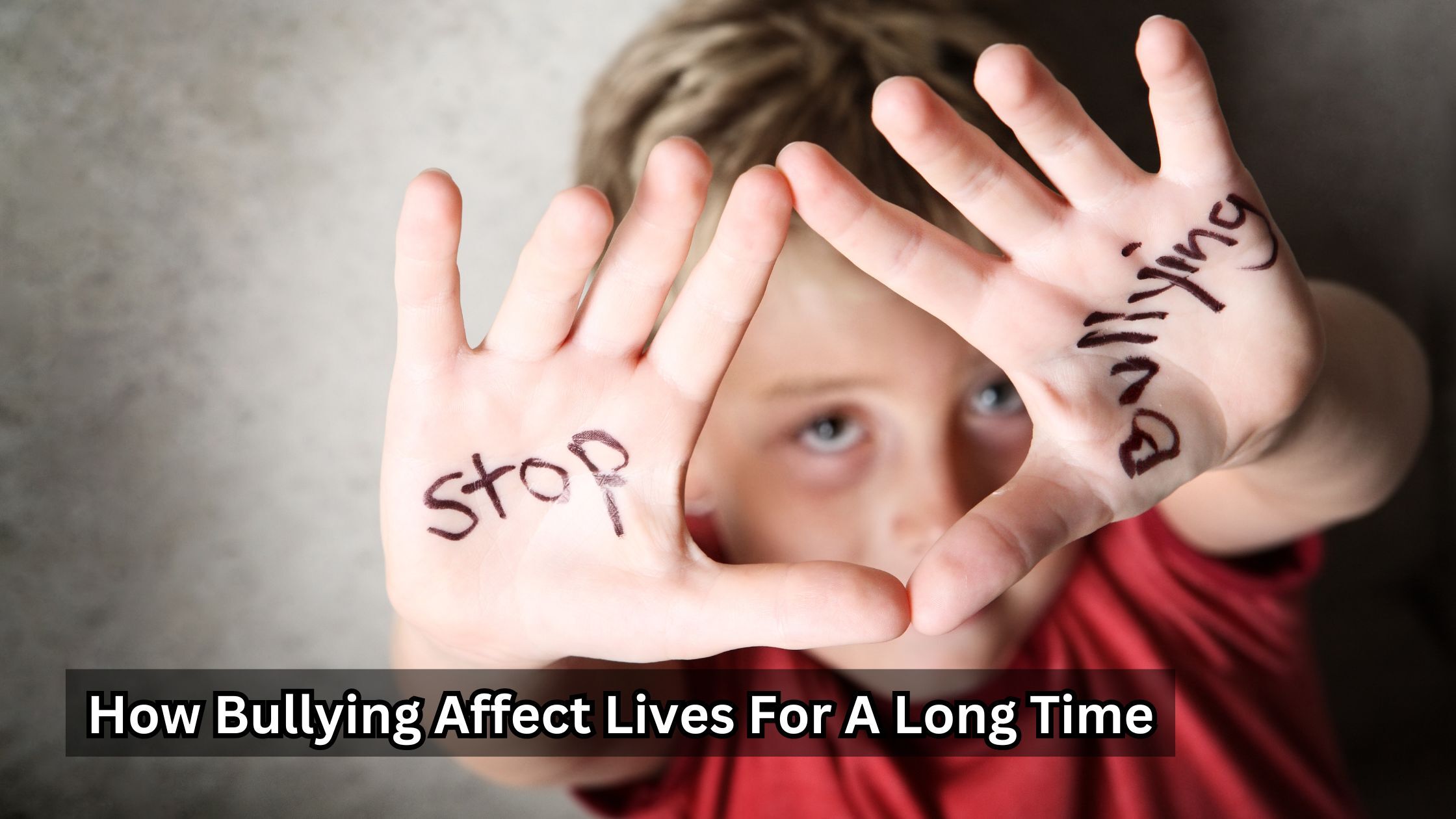
How Bullying Affect Lives For A Long Time
Being bullied is truthfully disheartening and can make you feel horrible. Regardless, numerous grown-ups, unless they’ve been bullied themselves, don’t completely understand how much children can suffer or how long it can affect them.
Bullying can have serious and long-lasting consequences that they might not realize. This absence of knowledge is understood as the “empathy gap.” Closing this hole is necessary for enhancing bullying policies and preventing it. Backing for prey won’t be sufficient unless individuals honestly understand how painful and traumatic bullying can be.
Learn how bullying affects lives in the long run.
Mental Health Issues
Bullying is linked to numerous cognitive health issues like sorrow, anxiety, and PTSD. Individuals who are bullied frequently feel weak and ineffective as they try to deal with regular verbal and physical abuse. Over time, these harmful emotions can shift into more severe mental health issues that may require professional assistance to get sounder.
Low Self-Esteem
Bullying can enormously hurt an individual’s self-esteem. When someone is regularly slammed and made to feel small, it becomes tough for them to feel fine about themselves. Targets of bullying might begin to believe the harmful things they hear and feel like they’re not promising adequately. This can initiate a revolution of low self-esteem that’s difficult to flee. Bullying, particularly verbal bullying—can be so dangerous that it leads to beliefs of suicide and, in some cases, even suicide itself due to the low self-esteem and discomfort it causes.
Perpetuating Bullying Behavior
Sadly, bullying doesn’t just impact the victim—it can form a process. Sometimes, individuals who are bullied evolve bullies themselves because of the concussion and pain they’ve gone through. They might bully others to feel less isolated or to turn the adverse awareness away from themselves. This behavior can keep the process of bullying running, as those who were once targets may begin treating others the identical way they were feted.
So how does bullying affect lives in the long run?
Childhood bullying can enormously influence a child’s health, both now and in the future. Acting fast and delivering long-term support can help lessen some of these effects. Schools, families, and communities require to work jointly to understand bullying, and its influence, and to discover ways to diminish and hopefully end bullying in schools and communities.
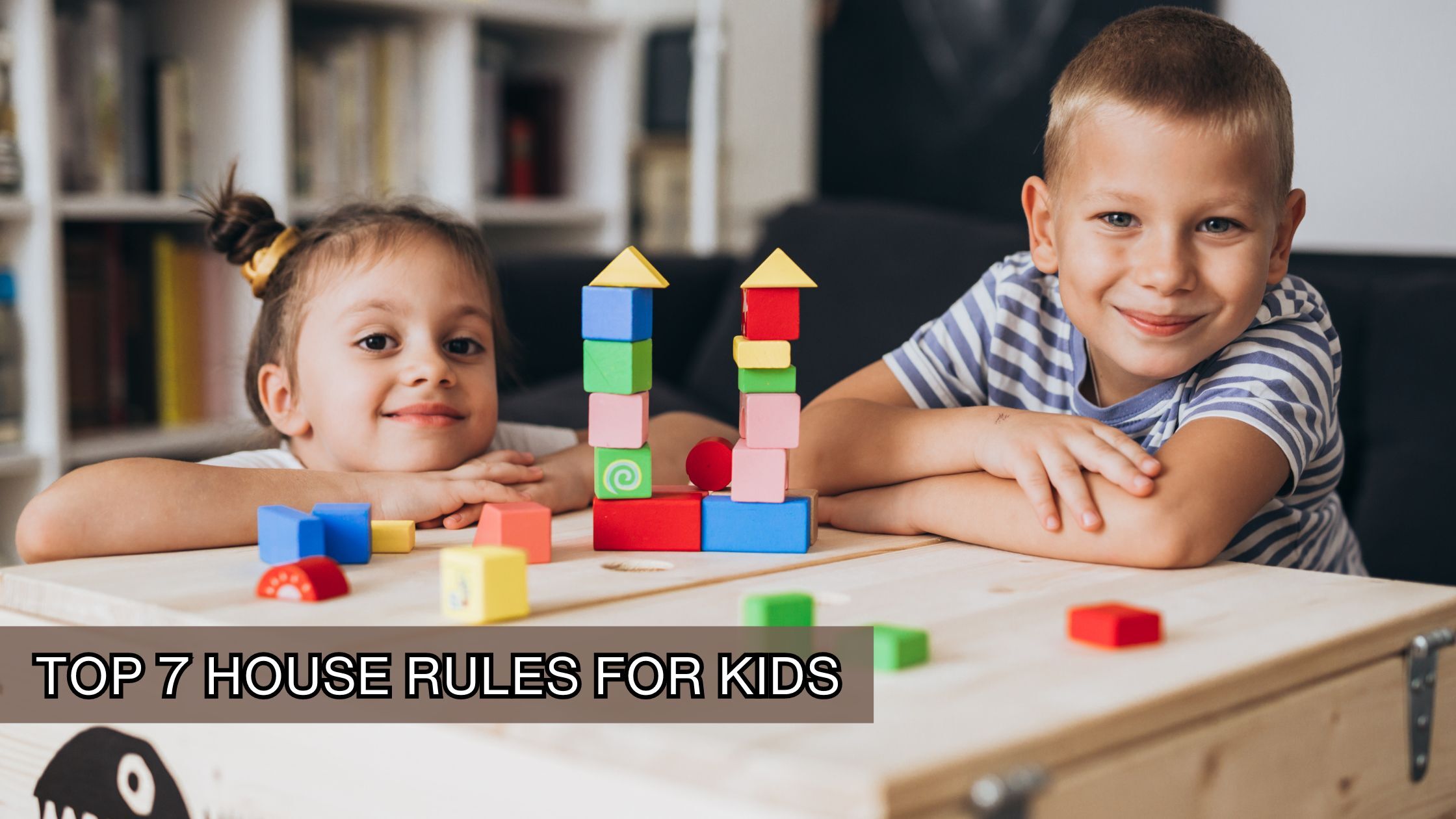
Top 7 House Rules for Kids
Creating precise house rules for childern is essential for a happy and supportive family. These rules help guide a kid’s behavior and growth, ensuring a safe and orderly home while teaching important life skills. Here are the top seven house rules for kids.
Promoting family values
Families often show what’s important to them through their house rules, reflecting their values. Parents also teach cultural morals and ethics to help children understand right from wrong. These lessons guide kids as they grow up, helping them make good decisions about what’s acceptable behavior.
Encourage good manners and respectful behavior
Clear house rules for kids can teach them proper social boundaries and behavior. Decide how you want your children to speak and act around family and guests, and show them by setting a good example yourself.
Set consequences when household rules for kids are broken
Kids will sometimes break the rules, so they must know the consequences. To get their cooperation, always follow through with the decided consequence. If you let it slide, they’ll think they can break the rules without any trouble. You can also set a specific time for them to do their chores, and only after finishing can they have playtime. Sometimes, let them help make the rules so they remember them better. Remind them of the rules and consequences from time to time.
Honesty and morality
All parents acquiesce that it’s essential to guide kids right from wrong and the significance of honesty. Kids learn morals and honesty in two ways: by observing the grown-ups around them and by being led. Speaking with your children frequently about your impressions allows them to understand these ideas. Including these thoughts in your house rules for kids makes them more straightforward for kids.
Ask permission
Make it clear what actions kids can do on their own. For example, they don’t need to ask to eat cake, but they should tell you if they want to drink sparkling water. Create a list of things your kids should check with you first.
Personal hygiene
Personal hygiene is a must for your child. You need to make sure your child learns it at the earliest.
Make some rules and some healthy habits for your child, such as brushing the teeth, washing hands before every meal, taking regular showers, and many more. Make these activities fun with songs or plays suited to their age.
Creating adequate hygiene routines sets your child up for a lifetime of healthy practices.
If a kid makes a mess, let them clean it up on their own
Kids frequently make clutter, but they ought to learn to clean up after themselves. If they can’t clean up on their own, they should request a grown-up for help. This teaches them about cleanliness and commitment, and it also prevents mishaps, like falling on a wet floor.
You don’t have to begin with all these house rules for kids at once. Pick a few that best manage your kid’s problem behaviors or that fit your home the best.
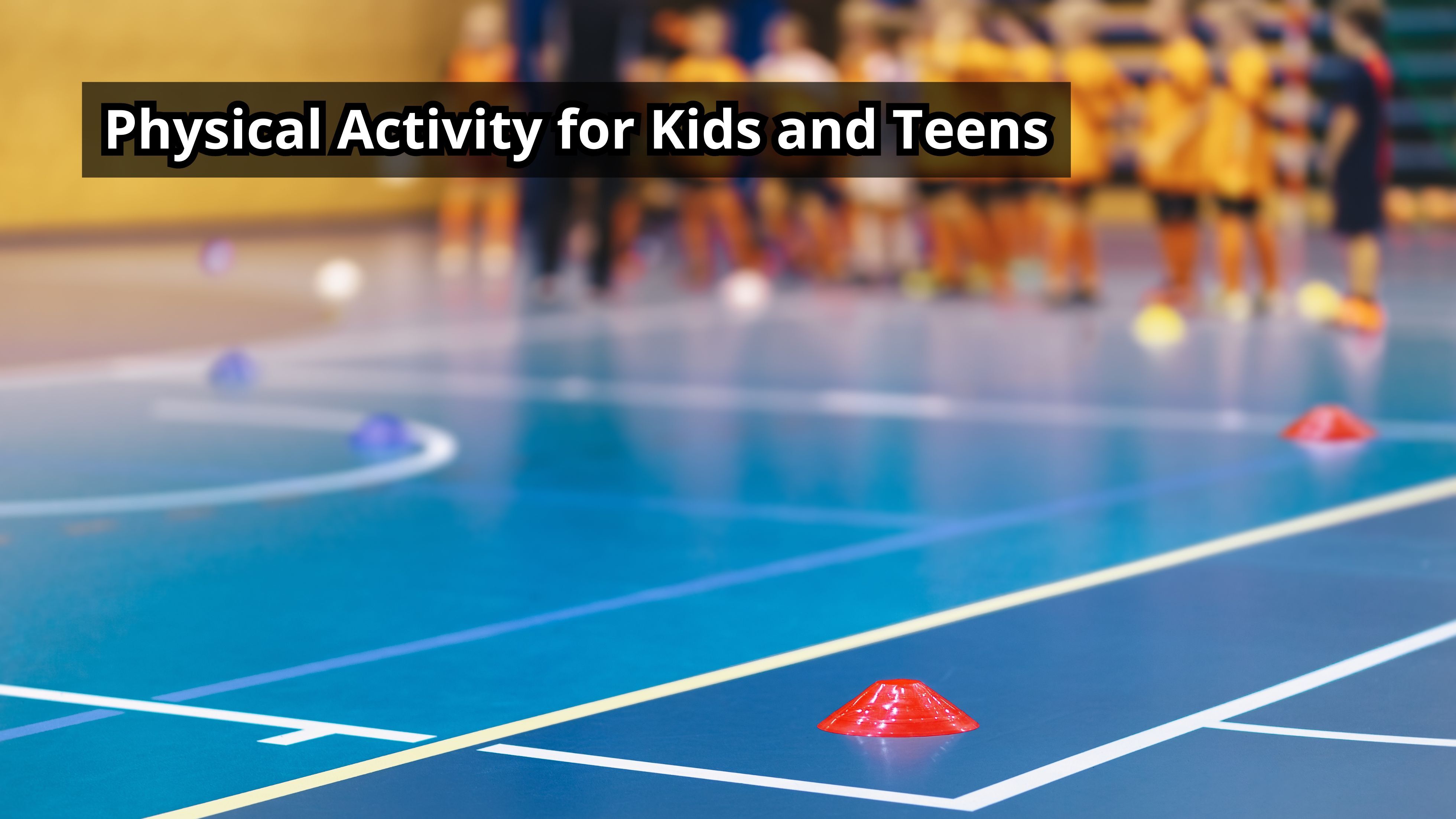
Top 7; Physical Activity for Kids and Teens
As summer break starts, parents often look for fun and useful activities for their kids. While rest and play are important, getting kids involved in physical activities can be really good for them. It aids in enhancing their soundness, expands their social skills, and builds their trust. Parents ought to guide their children toward actions that are both entertaining and wholesome.
Here are the top 7 physical activities for kids and teens to try this summer:
Musical Chairs
Put on your dancing shoes! This play game functions pleasingly with at least 4 children playing and 1 individual stopping the music.
If you don’t have adequate chairs, you can utilize pieces of colored paper taped to the bottom instead. When the music stops, the kid who gets both feet on the paper first claims the spot.
Cycling
Riding a bicycle is a delightful exercise that helps enhance heart health, leg potency, and coordination.
Dancing
Dancing is a wonderful way for children to express themselves creatively while even enhancing their core health, coordination, and flexibility.
Animal Races
Fun activities that utilize the entire body are amazing for kids’ wellness. Races that involve more than merely running are a blast and frequently silly. Bunny hop, frog jump, and duck, crab, or bear walk races will have you and the children giggling while acting on nearly every muscle in their bodies.
Football
Football is a significant action for kids who love contests, sprinting, and strategy. There’s nothing more pleasing than seeing your kid toss an excellent pass, make an excellent catch, or sprint into the end zone. If you’re concerned about the roughness of the sport, football doesn’t forever have to involve tackling. Touch and flag football are safe options that boys and girls of all generations can relish.
Swimming
Swimming is the most reasonable exercise for kids’ prevailing fitness. It tones the body, burns calories, relieves stress, and is good for the lungs.
The Human Knot
In this play, participants stand in a circle and hold hands, creating a “human knot.” They then attempt to separate themselves without allowing go of each other’s hands. This activity usually takes 15 to 20 minutes, but it can take longer with more participants.
The human knot is a famous icebreaker and an excellent team-building activity for teens, allowing them to learn to work jointly and closely. To make it harder, you can have the group try to untangle themselves with their eyes shut.
So here you have, these are the top 7 physical activities for kids and teens.
Kids and teens of all ages should bypass sitting for long periods without moving. They should spend less time on computers or watching TV and take frequent breaks from studying.

The Ultimate Checklist of Healthiest Foods for Kids
As a parent, you can help your kid make nutritious meal choices that will help them for life. Preparing them to feast well when they’re young enables them to remain wholesome as they grow up.
Giving them suitable nutrients permits their bones to develop robustly, stimulates their brain, and helps their physical and cognitive evolution. It even helps keep them from getting unhealthy and can stop troubles like obesity, diabetes, and heart conditions.
Let’s look at the top 10 healthiest foods for kids, their advantages, and how to count them to your kid’s feasts.
Avocado
The monounsaturated fats in avocados help kids feel whole for a more extended time. As an outcome of their high-fat content, avocados enable kids to keep cholesterol levels. Avocados possess a lot of monounsaturated fats, which reduce inflammation and maintain wholesome cholesterol levels. Avocados’ most significant advantage is their adaptability.
Avocados can be consumed directly, squashed on toast, blended into chicken or tuna salad, or used to make pasta sauces, such as avocado pesto.
Dairy or Dairy Alternatives
Dairy or dairy choices for children:
- Low-fat or Greek yogurt is rich in calcium and probiotics, which are right for gut health.
- Cheese offers them calcium and protein, which are vital for potent bones and muscles.
Whole Grains
Another healthy food for your growing children is whole grains. Most kids today don’t get sufficient of the nutrients that whole grains furnish. That’s why whole grains should be a standard part of the diet for kids ages 4 to 8.
Pulses and Beans
The dietary requirements of kids begin to switch between the periods of one and a half to two years. Ideally, this is when they commence to require additional sorts of food. In Asian nations, individuals begin paying attention to heart health and present different types of bean puree at this age.
Nuts
Distinct types of nuts and nut butter, like peanut butter and almond butter, are excellent fast snacks for children. Nuts are a sound origin of wholesome fats and protein that kids require. Be cautious with peanuts, though, as they can be perilous for some children. Other nut butters might be more safe.
Salmon
Salmon is a sort of fish that is indeed exemplary for your brain and heart. It has tons of omega-3 fatty acids, which are necessary for brain development and heart health. Eating salmon can help you do better in school and remain healthy. You can try baked salmon, salmon patties, or even salmon sushi rolls!
Every parent is concerned about what to offer their kids to consume between meals when they are starving.
The best key is to pick the healthiest foods for kids. It’s likewise useful to know about the food pyramid for kids. This blog post provides data about the fundamental nutritious foods that give children the fuel they require.

What You Need To Talk About Drugs To Your Child
Parents can help prevent their children from drug abuse by talking to them about the threats before they encounter any scary troubles. This can make children less likely to try drugs or to ask pals for facts.
As a parent, you are ideal for your kiddies. Your views on liquor, tobacco, and drugs can greatly impact how they think about these implications. So, make sure to talk about drugs to your child, when you talk about healthiness and safety.
Begin Earlier
Experts suggest beginning discussions about drinking, smoking, and drug use with your child when they are between 5 and 7 years old and restarting these conversations as they unfold.
Look for opportunities to teach your kid about these topics. For instance, if family members consume wine at dinner, clarify why they do it and what reliable drinking signifies. If a beer commercial comes on while your kid is watching TV, talk about how the individuals in the ad appear to be having fun, but consuming too much can lead to poor judgments and harm. It’s extremely significant to have these discussions if there are household members with alcohol or drug issues, as children with a family record of substance misuse are more likely to struggle with it themselves.
As your kid gets older, keep speaking to them regularly about drugs, alcohol, and tobacco in ways that suit their age. Make your thoughts apparent and recite them frequently. If you don’t approve of smoking or drinking, ensure your kid understands this and knows why. They must understand that drug use is never adequate and that no street drugs are safe.
Discuss peer pressure and your child’s incidents at school and with friends
Try to understand what children are going through today. Don’t get sore or emotional; this might make your kid less likely to flare up to you. Rather, remain calm and listen to what your kid says about what other children are doing. Teach your kid ways to say no to drugs or bypass them. Let your child know they can still use you as an excuse to turn down offers.
Talking about drugs to your child is significant and can help prevent them from trying these substances in the future. Begin these discussions before they are exposed to drugs and alcohol, and keep speaking as they grow up. To have a good chat, keep an open dialogue and apparently explain your rules. Discuss how to address peer pressure, and try not to lecture.

The 5 Best Educational Science Games For Kids
When teaching children about the art of science, there are multiple things to dig, like static electricity and aerodynamics. Fortunately, you don’t require a Ph.D. or a classroom to help your kid learn about the world. These five fun and educational science games for kids make education satisfying and can keep them occupied for hours.
Solar System
Kids love space, planets, and stars. Use Play-Doh to teach them about the solar system. Use different colors for each planet: red for Mars, blue and green for Earth, blue rings for Saturn, and so on. While teaching the planet names, share interesting facts, like scientists looking for life on Mars, Pluto not being a planet anymore, and the rings around Saturn.
Cloud Cool Down
Cloud Cool Down is one of the best scientific games for kids. Send energetic kids outside to draw pictures of the clouds they see. Stay inside and take a deep breath. Once you feel calm, let the kids come back in. Assist them in specifying, labeling, and adorning their images with cotton and glue.
Anatomy Chalk Draw
Using chalk outside or paper and markers, students can practice human anatomy. In pairs, they outline their partner on the ground. Jointly, they draw and mark the primary organs in suitable places. Who can get the most organs in the correct spots? Pairs can compete against each other or work together to compete against other pairs.
Body Part Bingo
Body Part Bingo is one of the best educational science games for preschoolers. Kids aged seven to nine can start learning about anatomy. “Human Body Bingo” is a fun way to help them learn. You can download free printable bingo sheets from Darcy & Brian, which have cute drawings of body parts like the brain, heart, stomach, and lungs. Gather playing pieces and an announcer before starting the game.
Astronaut Space Box Game
Kids can wear astronaut gloves to see what it’s like to use their hands with these bulky gloves. Fill a box with small objects like cups and marbles. Let the kids handle these items while wearing kitchen gloves! They’ll practice fine motor skills and imagine what it’s like to work in space.
Science is all about exploring, and the best way to get kids excited is through hands-on experiments, like educational science games for kids. The great thing about science is how practical it is. Demonstrating and discussing experiments with kids helps them get interested in the concepts.
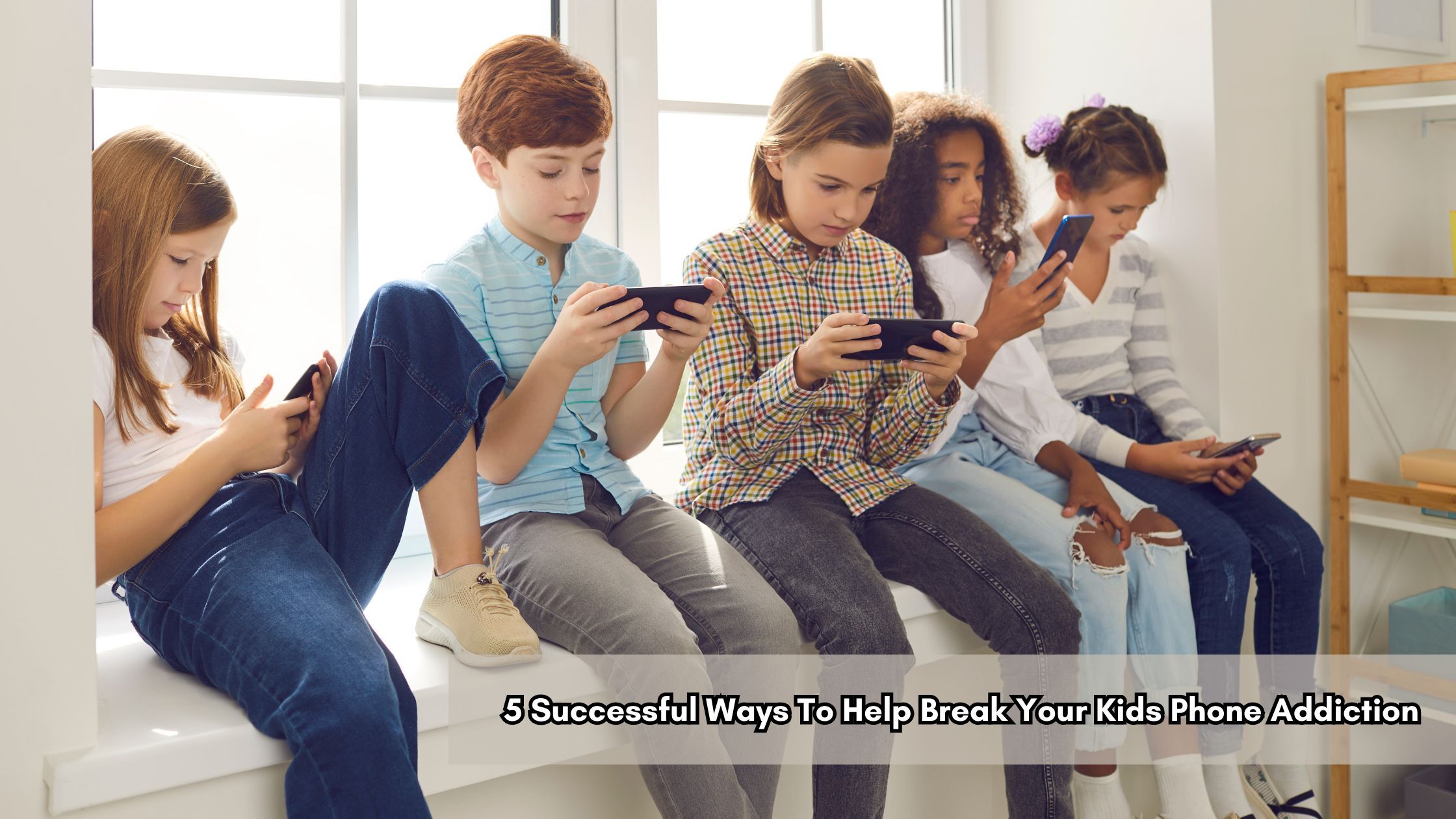
5 Successful Ways To Help Break Your Kids Phone Addiction
Kids around utilize cell phones for things like speaking to mates, playing games, and taking care of themselves. However, using phones too much can induce troubles with stress and mood. Here are some ways to help your child stop being so addicted to their phone.
Make sure your phone is not charged near your bed, first of all
Want to know the most suitable way to keep your children from utilizing their phones too much? Don’t let them charge their phones in their bedroom.
Want to know a wonderful way to keep yourself from using your phone too much? Don’t charge it in your bedroom.
A lot of the bad consequences of operating phones too much, like poor sleep and communication issues, can be bypassed by keeping your phone out of your sleeping arena.
Reduce notifications
Managing addictive behavior is frequently about lowering temptation, and the sound of a notification can easily pull you back to your cell phone.
You might not discover how many alerts you get in a day until you pay attention to them.
Try utilizing your phone’s Do Not Disturb function during specific times, or turn off notifications for all but your most-used apps. This can be a decisive way to remind yourself that you control your phone.
Offer your kid rewards for less time spent on your phone
This concept is named positive self-reinforcement. It’s utilized in therapy to teach individuals good habits by rewarding them. For instance, if you satisfy your objective of utilizing your cell phone less, you can treat yourself to your favorite food, buy something unique, or do a delightful activity.
Communicate with your child
Individuals are extremely observable. The bright colors and animations on a smartphone screen are very attractive to kids. That’s why parents ought to tell their kids about the damaging consequences of too much phone use on their health. Show your kids videos that demonstrate the negative effects of utilizing smartphones too much.
Go Offline!
Foster activities that don’t involve screens. Purchase games, sports equipment, art supplies, or books to help your kid relish different occasions. If your child has a hobby or special interest, support them and help them spend more time on it.
Plan a day outdoors and let your kids help plan it. This way, they’ll be more curious and willing to join in without requiring their smartphone all the time.
After you’ve made these small transformations, try something bigger, like having one phone-free day each month or social media-free weekends.

The Three Trimesters of Pregnancy, Explained! Week By Week
For women, pregnancy is one of the most joyful moments in their lives, with changeovers transpiring, evolution, and more. But do you know? Pregnancy specifically has three phases, named trimesters of pregnancy, each lasting about three months. Here are some things you can anticipate during each trimester of pregnancy.
The First Trimester of Pregnancy
In the first trimester of pregnancy, your baby unwinds from a petite cluster of cells into a fetus. The trimester lasts from the 1st of the week until almost the 12th.
- Weeks 1–4: The fertilized egg implants itself into the lining of your uterus, and your baby starts to develop.
- Weeks 5-8: Primary organs like the heart, brain, and spinal cord begin to form. By the end of week 8, your baby is almost the size of a kidney bean.
- Weeks 9–12: Your newborn’s traits evolve more specifically. The arms, legs, fingers, and toes take shape, and the heartbeat can be witnessed.
Throughout the first trimester of pregnancy, your body undergoes significant discrepancies as it adjusts to pregnancy. Here is what you might undergo: morning sickness, tiredness, breast transformations, and frequent urination.
The Second Trimester of Pregnancy
The second trimester of pregnancy is frequently quoted as the “golden period” because many women feel most satisfactory during these weeks.
- Weeks 13–16: Your baby’s bones begin to solidify, and they can make sucking movements with their mouth.
- Weeks 17–20: You may begin to sense your infant move! This is named “quickening.”
- Weeks 21–24: Your baby’s skin is flimsy and sheer, but they’re beginning to gain weight.
- Weeks 25–26: Your baby’s sanities are evolving, and they might begin reacting to sounds.
During the second trimester of pregnancy, you may feel more nominal nausea, more fuel, baby bows, discomforts, and distress.
The Third Trimester of Pregnancy
The third trimester is all concerning development and absolute preparations. Preparations are in progress for your baby’s life outside the womb.
- Weeks 27–30: Your baby’s brain is growing at a fast pace, and they can flare and shut their eyes.
- Weeks 31–34: Your baby begins to shift head-down in preparation for birth.
- Weeks 35–37: Your baby’s lungs are almost fully formed, and they’re gaining weight fast.
- Weeks 38–40: Your baby is deemed full-term and can be born at any moment.
As you near the end of your pregnancy, your body goes through more transformations to prepare for birth, such as frequent urination, swelling, Braxton hicks contractions, discomfort, and more.
At last, always remember that the trimesters of pregnancy come with all-around challenges and excitement, so addressing them carefully is imperative.
Be safe and secure, and don’t hesitate to think of any additional help or assistance when undergoing trimesters of pregnancy. Happy Pregnancy!

5 Challenges a Single Child Faces
People pay a lot of attention to only children. It’s important to understand the special problems they have in their families. They go through some tough times that kids with brothers or sisters don’t have to deal with as much.
First of all, High expectations
Some parents push their kids to do well in things that matter a lot to them, like school, looks, religion, or sports. Only kids might feel additional stress because they’re the only ones their parents have to show off. This can make them feel like they have to live up to their parent’s expectations and expectations. As they grow up, they might discover it difficult to offset what they want with what their parents desire for them.
Loneliness
Without siblings to play with at home, only kids might feel lonesome at times. While they might have mates outside of the family, there’s a discrepancy between sibling friendship and company with peers. Uncovering modes to cope with and crush sentiments of loneliness can be a challenge.
Decision-Making Dilemmas
As a single child, you might discern that you have to make all the determinations on your own. From deciding what movie to watch to choosing an academy major, the accountability of decision-making can feel daunting. It’s imperative to learn how to make picks that are right for you without feeling devastated.
Identity and Independence
Only children usually wrestle with queries of individuality and independence, as they steer their place within the family dynamic. Discovering your voice and maintaining your freedom can sometimes be difficult when you’re the sole focus of your parent’s attention.
Family Dynamics
Family dynamics can be diverse for solely children compared to those with siblings. Without siblings to share incidents with, only children might feel separated from individual family traditions or dynamics. Finding your place within your family crew and navigating connections with vast family members can require some extra effort.
While being an only child has its advantages, it’s important to identify and address the distinctive challenges that come with it. By recognizing these challenges and finding healthy ways to cope with them, only children can navigate their family dynamics and prosper in their unique way.

How To Raise A Good Behaved Toddler
Every toddler has moments when they act up, but it’s a consolation when you know your kid will usually behave well. When your kid does something right, honor them for it. Encourage them to learn sound manners and bypass whining or complaining. Be uniform with rules and utilize moments of mischief as teaching opportunities rather than just punishing.
So without further ado, here are some of the best parenting tips for toddlers that you will surely not gonna miss when raising him/her.
Create and follow basic routines
Having a day-to-day routine enables us to feel more relaxed because we know what’s arriving ahead. Even throughout messy times, it’s valuable to establish straightforward routines like standard meal times, waking up, and bedtime. When troubles occur, try to be lax and don’t be too hard on yourself. Go with the flow as much as possible, and seek to return to your routine when things settle down. Always remember, that every new day is a new start.
Teach Patience
Teaching patience is one of the invaluable parenting tips for toddlers. Patient toddlers tend to act less impulsively, think more calmly and are slower to get upset when things don’t happen as they’d like. Just like a muscle, patience grows stronger with practice! One effective method is ‘patience-stretching,’ where you deliberately delay giving your child what they want and commend them for waiting patiently.
Encourage Independence
Assign tasks suitable for their age to help them learn responsibility. Avoid doing tasks for your children that they can manage on their own. Even when you’re out, involve them in simple tasks like assisting with the grocery list or holding items at the store.
Physical Affection Is a Must
Showing physical affection, like hugs, kisses, or high-fives, is a wonderful way to reinforce positive behavior and one of the prominent parenting tips for toddlers. It’s even better when combined with specific praise. Vary your gestures, so it doesn’t feel like your child gets the same hug every time they behave well.
Accept The Child’s Reactions
Children often react strongly when faced with restrictions, sometimes resulting in outbursts. It’s important to anticipate this possibility. Feeling resentful or furious when broken or humiliated is a genuine human response. To support a child’s emotional development, it’s essential not to penalize them for voicing their emotions, which are intrinsic and uncontrollable. Allow them to express their feelings, within appropriate boundaries.
Keep promises
Keeping promises is one of the best parenting tips for toddlers. When you keep your commitments, your toddler learns to rely on and appreciate you. They understand that you mean what you say, whether it’s offering something nice or explaining a consequence. For example, if you promise a walk after they tidy up their toys, be ready to go. If you tell your 3-year-old they’ll have quiet time if they keep throwing dirt, be prepared to enforce it.
Laugh with your Toddler
Sharing laughter, light teasing, or simply having fun with your child can help ease tension and prevent potential conflicts.
Encouraging positive behavior in toddlers may be tough, but it pays off in the end. Offering praise along with clear expectations and achievable goals can help guide them toward good behavior.
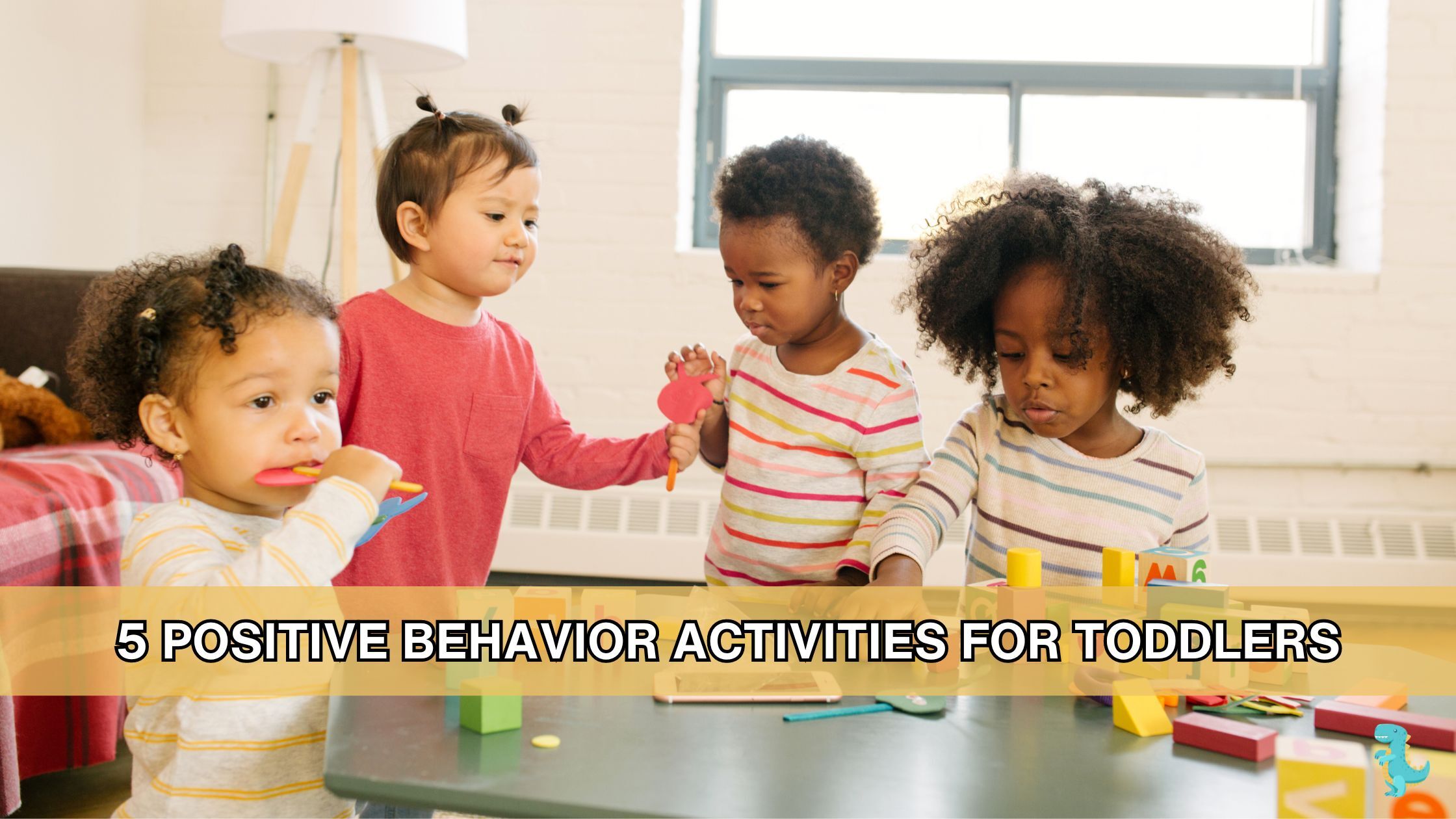
5 Positive Behavior Activities for Toddlers
Are you one of those parents looking for positive behavior activities for toddlers? If so, you’ve arrived right. Toddlers are full of fuel and inquisitiveness, and they love analyzing the globe around them. Here are five positive behavior activities for toddlers that will not only keep them entertained but also help promote their overall development.
Exploring Nature
Take a stroll outdoors and let your toddler survey nature. Whether it’s a journey to the playground, a trek to the mountains, or just examining your backyard, there’s so much for them to learn. Boost them to touch the grass, smell the blossoms, and hear the birds twittering. They learn about the world around them via this movement, which facilitates their senses. Plus, spending time in nature has been shown to have multiple benefits for both physical and mental health.
Creative Play
Set up a specified place in your house for innovative play. This could be a corner of the living room or a table with art supplies. Provide your toddler with crayons, markers, colors, and paper, and let their creativity run wild. You can likewise give them different materials like playdough, clay, or building blocks to explore. Creative play enables toddlers to define themselves and develop fine motor skills, and problem-solving capabilities. Recall to praise their measures and portray their artwork proudly!

Music and Movement
Put on some music and have a dance party with your toddler! Toddlers love to move and groove to the beat, so clear some area in your residence room and boogie down jointly. You can even present simple musical instruments like shakers, drums, or tambourines for them to play along. Music and movement not only provide a delightful outlet for energy but also help develop coordination and rhythm. Plus, dancing together fortifies the bond between you and your little one.
Storytime
Storytime is one of the best positive behavior activities for toddlers. Reading to your toddler is one of the finest ways to encourage language development and a love of learning. Set aside some time each day for storytime, whether it’s before naptime, bedtime, or just a quiet moment during the day. Choose age-appropriate textbooks with bright pictures and straightforward text. Inspire your toddler to participate by asking questions, implying pictures, and even acting out parts of the story. Not only does reading together promote a healthy parent-child bond, but it even sets the foundation for a lifelong love of reading.
Praise and Encouragement
Lastly, don’t undervalue the fuel of recognition and motivation. Toddlers thrive on positive reinforcement, so be sure to acknowledge and praise their efforts, no matter how small. Whether they successfully pile blocks, share a toy with a friend, or utilize their manners, let them know you’re proud of them. Utilize precise praise, such as “You did a great job cleaning up your toys” or “I love how you’re using your words to ask for what you want.” Positive reinforcement not only intensifies their self-esteem but also backs positive behavior.
Engaging in positive activities with your toddler not only keeps them engaged but also promotes their growth and fosters positive behavior. Whether it’s exploring nature, getting innovative, dancing to music, reading together, or offering praise and encouragement, these positive behavior activities for toddlers are sure to bring smiles to both you and your little one. So, what are you waiting for? Let the fun begin!
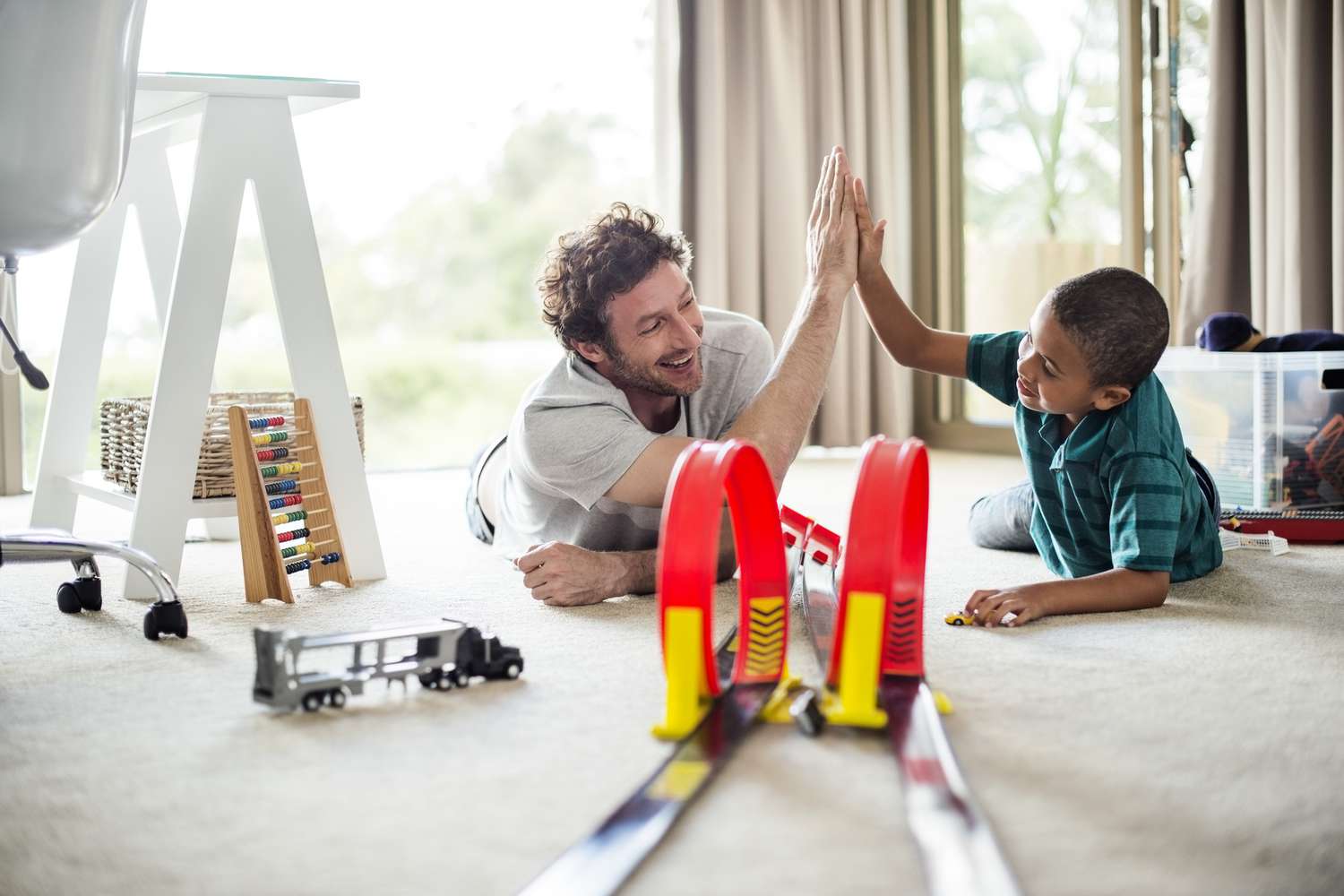
10 Tips On How To Motivate Toddlers To Behave Well
Being independent and depending on oneself is a knack every individual should learn. And it’s soundest to start learning this when you’re a toddler. Teaching kids to be self-sufficient isn’t effortless, but there are some straightforward things you can do to help them learn and grow. In this article, we’ll talk about ten parenting tips for toddlers to behave well.
Spend some good time together
Spending time is one of the best parenting tips for toddlers. Kids want your attention! Make sure to set aside some time every day to play or hang out with your child alone. Just 5 minutes can help a lot! If they don’t get a fair lookout from you, they might start misbehaving to get seen. Throughout this time, put away phones and devices. Utilize this particular time for playing, reading, or working on something jointly.
Tell your child how you feel
Being open with your kid concerning how their moves make you feel helps them understand emotions better. When you utilize “I” statements, it lets them see things from your point of view. It’s fine to talk about emotions when both of you are relaxed.
Teaching your child about feelings, both theirs and others, is essential. It helps them address big sensations like frustration, which can lead to tantrums occasionally.
Remain positive
Remaining positive in every situation is one of the best parenting tips for toddlers. If your kid notices fear or doubt in you, they might start doubting themselves too. Being optimistic will make them feel more confident and change how they see things.
Make Communication a Priority
Kids need reasons, just like adults do. They won’t always do things just because you tell them to. If you don’t explain things, they’ll start questioning your values and why you want them to do something. Talking and reasoning with kids helps them understand and learn without feeling judged.
Focus on Routines
Children do well with routines, so create clear schedules for tough times of the day, like mornings, after school, meals, and bedtime.
Involve your kids in planning the routine. Ask them what should come first, like getting dressed or brushing their teeth. See how they can help with dinner preparation.
For younger kids, make a list of the routine with pictures or words. Let them decorate it and put it up where they can see it every day. Then, stick to the schedule.
Good Education
Getting a good education helps us gain knowledge, learn how to behave well, be disciplined, and develop good character. Education teaches us many important things, including how to interact with others and why good behavior and habits matter.
Try Distraction
Trying distraction is one of the best parenting tips for toddlers. Toddlers often get easily distracted. When your toddler throws a tantrum, you can use their short attention span to your advantage. Distract them with something fun or interesting, and it might help them forget about the tantrum.
Speak quietly
Sometimes, when you want to say something important or get something done with your child, it might seem like raising your voice or talking louder will help. But actually, speaking softly and calmly might grab their attention better. Give instructions in a relaxed tone. It can help kids focus on what you’re saying without getting distracted by how loud or intense your voice is.
Offer Feedback
Feedback is one of the best parenting tips for toddlers. Constantly make certain to witness and acknowledge what your kid does. If they’ve cleaned their space well, give them a pat on the back or say thank you. Utilizing positive remarks like “Great job!” or “Thank you!” or “You’re showing such commitment!” will make them feel good and proud of what they’ve achieved.
Praise Good Behaviour
Whenever your child shows good behavior, make sure to praise him or her. This enables her/him and encourages their confidence. Even if actions seem small or silly, it’s important to praise good behavior to keep doing it in the future.
So these are some of the best parenting tips for toddlers!

A Guide to Healthy Pregnancy, Week-by-Week: What to Expect
Pregnancy is a mystical voyage loaded with suspense and excitement. As you undertake this outlandish adventure, it’s worthwhile to understand what to foresee week by week. Each phase of pregnancy brings remarkable transitions and junctures, both for you and your evolving infant. In this blog post, we’ll provide an outline of gestation week-by-week, healthy pregnancy tips, from beginning to delivery, so you can satisfactorily equip yourself for the amazing journey onwards.
Weeks 1-4: Conception and Early Development
The first few weeks of gestation frequently go overlooked, as conception generally transpires around week 2. Throughout this period, the fertilized egg implants itself in the uterus, and the cells diverge at a fast pace, composing the embryo. As one of the healthy pregnancy tips, begin taking prenatal vitamins with folic acid throughout this span to support the baby’s neural tube development.
Weeks 5-8: Organ Formation Initiates
By week 5, your infant’s heart starts to pound, and organ-building boots into lofty gear. The embryo is currently named a fetus and is about the dimensions of a pea. You may commence encountering signs like morning illness, exhaustion, and breast tenderness as your body acclimates to pregnancy hormones.
Weeks 9-12: First Trimester Milestones
Throughout weeks 9-12, your baby’s facial traits evolve more specified, and tiny fingers and toes begin to develop. This span observes the end of the first trimester, and numerous women discover solace from premature pregnancy signs about this time. Your healthcare provider may suggest a first-trimester screening to evaluate the baby’s risk of inborn conditions.
Weeks 13-16: Baby’s Movements and Gender Reveal
As you enter the second trimester, your baby’s actions evolve more apparent. You may begin feeling flutters or “quickening,” which is a thrilling juncture for numerous pregnant mothers. Around week 16, you may have an ultrasound that can display the baby’s gender if you desire to discover it.
Weeks 17-20: Growing Bump and Baby’s Senses
Your abdomen persists to extend as your baby experiences prompt growth. By week 20, your infant can listen to sounds from outside the womb, and their senses are evolving. As one of the healthy pregnancy tips, this is a wonderful time to initiate connecting with your baby by talking or singing to them.
Weeks 21-24: Milestones and Development of the Lungs of the Baby
Week 24 is deemed a striking juncture as it observes the point of viability, implying the infant could survive outside the womb with medical intervention. Your baby’s lungs are evolving rapidly during this time to prepare for breathing air after birth.
Weeks 25-28: Third Trimester Begins
As you set foot in the third trimester, your baby’s lifts and activities may intensify. You may experience Braxton Hicks compactions, which are practice contractions that help equip your body for labor. As one of the healthy pregnancy tips, it’s vital to continue attending prenatal appointments and supervising your baby’s blossoming and well-being.
Weeks 29-32: Baby’s Growth Spurt
Throughout weeks 29-32, your infant experiences a substantial growth spurt, and their body stores fat for insulation and energy. You may begin feeling more exhausted as your body works hard to support your developing baby.
Weeks 33-36: Preparation for Birth
Your baby’s head may begin to engage in your pelvis in preparation for birth, which can reduce pressure on your diaphragm but may likewise increase pressure on your bladder. As one of the healthy pregnancy tips, it’s important to stay hydrated and practice pelvic floor exercises to be ready for labor and delivery.
Weeks 37-40: Full-Term Pregnancy
By week 37, your gestation is believed full-term, and your baby is equipped for life outside the womb. Nevertheless, it’s normal for newborns to arrive anytime between 37-42 weeks. As your due date approaches, you may encounter nesting instincts and raised anticipation of meeting your infant.
Labor and Delivery: Welcome to Parenthood
When labor commences, you may undergo contractions, a break of membranes (water breaking), and other symptoms that reveal your baby is willing to be born. Every labor experience is special, but knowing what to expect can aid you feel more set.
Pregnancy is a lovely journey filled with growth, landmarks, and uncertainty. Understanding the transformations and developments week by week and healthy pregnancy tips can help you navigate this adventure with enthusiasm and excitement. Remember to take care of yourself, attend frequent prenatal appointments, and adore each moment as you prepare to welcome your little one into the world.
Your Attractive Heading

10 Expert Parenting Tips to Help Your Preschooler Thrive
Parenting a preschooler is still fascinating and will be forever. One minute, your kid might be questioning about rocks and the subsequent, they’re pretending to be unicorns! That’s precisely how it goes when you have a preschooler. They’re inquisitive, affectionate, and full of creativity. It’s a distinctive time!
Kids between 3-5 can likewise have some challenging moments. They might struggle with controlling their emotions and not forever desire to heed the rules. Here are some effective parenting tips for preschool kids to help navigate this thrilling and sometimes tricky stage of a kid’s life.
Safety
To be a good parent, the initial step is keeping your kid safe. This implies ensuring your house is secure for them, learning how to hold them appropriately, and keeping a close watch on them to bypass mishaps. But what about when you’re not there to guard them?
It’s essential to check safety rules and teach them to your kid. This can help reduce your concerns, particularly if you’re a parent who works outside the house. Train your kid how to request assistance if they get hurt and how to discover a trusted grown-up in any circumstances. While it’s tough to think about sinful things happening, preparing your kid can help prevent casualties or damage.
Use positive reinforcement
You can help your preschoolers behave well by praising and giving them attention when they do something good. This positive feedback makes them feel happy and confident, especially after they finish a task.
Be A Good Role Model
Your behavior has a big impact on your child because they learn from watching you. Show them kindness, responsibility, and how to solve problems. If you make a mistake, admit it. This instructs them that it’s alright to not be excellent and that we can learn from our blunders.
For instance, if you feel angry and want to shout at your kid, think about whether that’s how you desire them to act when they’re angry.
Practice self-care
When you’re a parent, it’s straightforward to feel overwhelmed and stressed, but taking care of yourself preferably is incredibly essential. Don’t forget to give yourself time, eat well, and get enough sleep.
All of these things can help you have a good connection with your child and help them become accountable and confident adults. Remember that nobody’s perfect, so mistakes are okay. It’s much more essential to continue learning and growing together.
Maintain Consistency with Your Discipline
Consistency and discipline is one of the effective parenting tips. In every home, it’s important to have rules and consequences. The point of having rules is to teach kids how to behave well and control themselves. Sometimes, kids will push these rules to see what they can get away with, but having rules helps them become responsible adults.
Setting up rules in your home helps kids know what you expect from them and teaches them self-control. Some rules could be: finish homework before watching TV, and no hitting, calling names, or teasing in a mean way.
Solve Problems Together
Rather than punishing kids, we should concentrate on problem-solving to help them learn reliable and compliant behavior. Punishment is a form of pushing kids to do what they like, but it doesn’t prepare them for essential qualities like compassion and character. It can even contribute to creating teasers. Kids don’t learn well when they’re nervous or forced. When they misbehave, it’s usually a signal that they’re struggling with something, not that they’re deliberately causing crisis.
Foster Good Relationships
It’s important to show your child how to appreciate and be kind to their friends and family. This sets a good example for their future. Having a pet that matches their age teaches them how to be caring, kind, and responsible.
Independence
Independence is one of the effective parenting tips for preschool kids. As a parent, your most crucial job, besides building a secure and caring home, is to get your kid ready for life as a grown-up. Kids should learn to be self-reliant, think for themselves, take accountability, and be resilient. If parents do everything for their kids, they might grow up depending too much on others, feeling entitled, and not knowing essential skills like cooking, doing laundry, addressing money, and most significantly, solving crises on their own. Parents should teach and empower their kids so they feel influential and skilled in the family.
Pick the Right Daycare or Preschool
If you have employment, you’ll be required to discover a daycare or preschool that’s exemplary for your kid. Look for a residence that’s hygienic, secure, and has overseeing and talented teachers. Check out different options near you and visit them in person before picking one.
Promote a Healthy Lifestyle
Ensuring your kid lives a wholesome life is truly imperative for their prevalent health. Encourage them to consume nutritious foods, exercise regularly, and get sufficient sleep. These habits help their body stay healthy, help them think pleasingly, and keep their sentiments in balance. Teaching them to take care of themselves puts them up to make good choices throughout their life, which keeps them healthy and robust in the long run.
Parenthood is unlike everyone, and these effective parenting tips for preschool kids are just hints to aid you, not rules you have to heed. Whether you’re making lots of unforgettable memories or turning walks outside into entertaining learning ventures, these straightforward things are imperative for building strong connections and teaching worthwhile lessons.

What to Do Instead of Yelling at Your Kids
Parenting is a tough job. It’s full of challenges and moments that can push us to our limits. One of the biggest challenges parents face is managing their emotions, especially when dealing with difficult behavior from their children. Yelling may seem like a quick fix, but it often leaves everyone feeling worse in the end. So, what can you do instead of yelling at your kids? Here are five gentle parenting strategies that can help build a stronger connection and create a more positive environment at home.
Patience and Empathy is Imperative
When your child is acting out or not listening, it’s easy to get frustrated and raise your voice. However, taking a moment to pause and practice patience can make a world of difference. Put yourself in your child’s shoes and try to understand what they might be feeling or experiencing. Maybe they’re tired, hungry, or overwhelmed. By showing empathy, you can validate their emotions and find a calmer way to address the situation.
Make Utilization of Positive Reinforcement
Instead of focusing on what your child is doing wrong, try to catch them doing something right. Positive reinforcement involves praising and acknowledging good behavior. For example, if your child cleans up their toys without being asked, you can say, “I’m so proud of you for being responsible and cleaning up. That’s helpful!” This approach encourages positive behavior and reinforces your child’s self-esteem.
Always Establish Clear Expectations and Boundaries
Children thrive on routine and structure. Setting clear expectations and boundaries helps them understand what is acceptable behavior and what isn’t. Be consistent with your rules and consequences, and communicate them calmly and respectfully. Instead of yelling at your kids, you can say something like, “In our family, we speak kindly to each other. When we’re upset, we use words to express our feelings instead of yelling.”
Practice Active Listening
Listening is a powerful tool in parenting. When your child is upset or expressing their feelings, practice active listening by giving them your full attention. Get down to their eye level, maintain eye contact, and show that you’re truly listening by nodding or using encouraging words like “I understand” or “Tell me more.” By validating their feelings and showing that you care, you can prevent conflicts from escalating into yelling matches.
Invest in Yourself
Parenting can be overwhelming, and it’s important to take care of your own well-being too. When you feel stressed or on the verge of yelling at your kids, take a step back and practice self-care. This could be as simple as taking a few deep breaths, going for a walk, or finding a quiet moment to collect your thoughts. By managing your own emotions and stress levels, you’ll be better equipped to respond to your child with patience and understanding.
Yelling at your kids may provide temporary relief, but it often leads to negative consequences and strained relationships. By practicing patience, empathy, positive reinforcement, setting clear boundaries, active listening, and self-care, you can create a more peaceful and harmonious environment at home. Remember, parenting is a journey, and it’s okay to seek support and learn from your experiences. Your efforts to be a gentle and empathetic parent will have a lasting impact on your child’s well-being and your relationship with them.

Top 10 Things Kids Need From Their Parents
Being a parent is a big responsibility, but it’s also one of the most rewarding roles in life. As a parent, you want the best for your kids and you strive to give them everything they need to grow up happy and healthy. But sometimes, it’s easy to get caught up in the busyness of life and forget about the simple things that matter most to children. So, let’s talk about the top 10 things kids need from their parents.
Love and Affection
The most important thing kids need from their parents is love and affection. Children thrive when they feel loved and cherished by their parents. Spend quality time with your kids, hug them, kiss them, and tell them how much you love them every day.
Attention and Presence
Kids need their parents to be present in their lives. Put down your phone, turn off the TV, and give your child your full attention when they’re talking to you. Show interest in their activities and listen to what they have to say.
Support and Encouragement
Children need their parents to be their biggest cheerleaders. Encourage your kids to pursue their interests and dreams, and support them every step of the way. Celebrate their achievements, no matter how big or small.
Consistency and Routine
Kids thrive on routine and consistency. Establish regular mealtimes, bedtime routines, and rules for behavior. Consistency helps children feel secure and know what to expect, which reduces anxiety and promotes healthy development.
Respect and Understanding
Treat your children with respect and understanding. Listen to their thoughts and feelings, even if you don’t agree with them. Avoid yelling or belittling them, and instead, communicate calmly and respectfully.
Boundaries and Discipline
Children need boundaries and discipline to feel safe and learn right from wrong. Set clear rules and consequences for their behavior, and enforce them consistently. Discipline should be fair and age-appropriate, focusing on teaching rather than punishment.
Quality Time Together
In today’s busy world, it’s easy to let quality time with your kids slip away. Make an effort to spend meaningful time together as a family. Whether it’s playing games, going for a walk, or cooking dinner together, cherish these moments and make them count.
Independence and Responsibility
Encourage your children to become independent and responsible individuals. Give them age-appropriate tasks and responsibilities around the house, and praise them for their efforts. Allow them to make decisions and learn from their mistakes.
Emotional Support and Guidance
Kids need their parents to be a source of emotional support and guidance. Be there for them during tough times, listen to their concerns, and offer guidance and advice when needed. Help them develop coping skills and resilience to navigate life’s challenges.
Unconditional Love and Acceptance
Above all, children need to know that they are unconditionally loved and accepted by their parents, no matter what. Show them that you love them for who they are, not for what they do or achieve. Be their haven in a world full of uncertainties.
Being a parent is about more than just providing for your child’s physical needs. It’s about nurturing their emotional well-being, supporting their dreams, and being their rock through thick and thin. By prioritizing love, attention, support, and respect, you can give your children the foundation they need to thrive and succeed in life. So, cherish every moment with your kids and strive to be the best parent you can be.
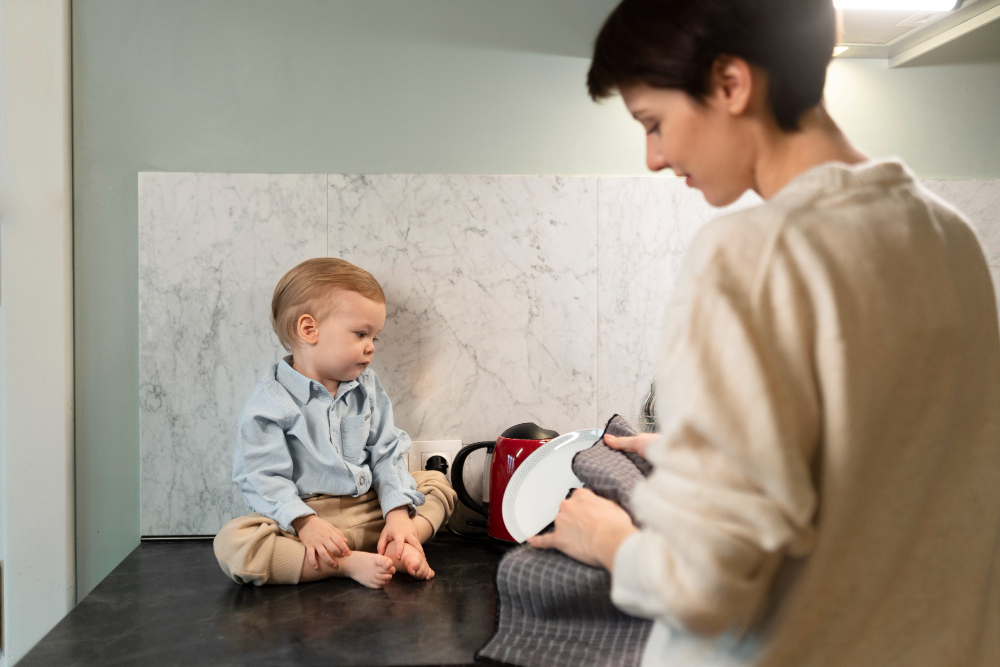
The Best Ways to Prepare Your Toddler for a Sibling
Are you desiring a new bundle of joy? Congratulations! Welcoming a new infant into the family is a thrilling time, but it can likewise bring some transformations, specifically for your toddler. Introducing a sibling to your little one requires some preparation to ensure a smooth transition for everyone involved. Here are some simple tips to help you prepare your toddler for a sibling.
Start Early
It’s never too early to prepare your toddler for a sibling. As soon as you know you’re desiring, start speaking to your child about the new infant. Keep the discussions easy and age-appropriate, utilizing language your toddler can understand.
Read Books About Siblings
Children’s books are a great way to teach the idea of siblings to your toddler. Look for books that show positive sibling relationships and highlight the joys of having a brother or sister. Reading these stories together can help your kid feel more enthusiastic and organized for the new addition to the family.
To Prepare Your Toddler for a Sibling Involve Him/Her
Make your toddler feel like a crucial aspect of the process by involving them in preparations for the new baby. Let them help select items for the nursery, such as bedding or toys. You can likewise ask for their intake when choosing out baby names or setting up the baby’s room.
Talk About Their Role as a Big Brother or Sister
Emphasize the special role your toddler will have as a big brother or sister. Talk about all the fun things they’ll be able to do together with their new sibling, like playing games, reading stories, and going on adventures. Encourage your child to feel proud of their upcoming role and the responsibilities that come with it.
Practice Baby Care
Help your toddler get used to the idea of caring for a newborn by practicing with dolls or stuffed animals. Let them feed, clean, and “put to bed” their pretend infant, imitating the routines they’ll soon be doing with their new sibling. This can assist your child feel more secure and will prepare your toddler for a sibling.
Address Any Concerns or Fears
It’s standard for toddlers to feel a combination of emotions about the appearance of a new sibling, including excitement, envy, and fear. Encourage your child to express their feelings openly and comfort them that it’s okay to feel however they feel. Listen to their problems and provide comfort and support as required.
To Prepare Your Toddler for a Sibling Maintain Routines
With all the excitement and transitions happening, it’s crucial to maintain some sense of routine for your toddler. Stick to standard meal times, nap schedules, and bedtime routines as much as possible to provide resilience and reassurance during this time of change.
Arrange Special Time Together
Set aside one-on-one time with your toddler to bond and tie before the infant arrives. Whether it’s going for a walk, playing a game, or reading a book jointly, make sure your child understands they are always loved and appreciated, even with the new baby on the way.
Visit Friends or Family with Babies
If feasible, set playdates or visits with pals or family members who have babies. This can give your toddler exposure to babies and assist them become more comfortable around babies before their sibling arrives.
Be Patient and Understanding
Above all, be patient and understanding with your toddler during this time of transition. It’s normal for them to have ups and downs as they adjust to the idea of becoming a big brother or sister. Offer plenty of love, reassurance, and support as your family prepares for this exciting new chapter.
To prepare your toddler for a sibling, you need good communication, involvement, and reassurance. By beginning early, involving your kid in the process, and addressing any concerns they may have, you can help ensure a smooth transition for your growing family. Remember to be patient and understanding as your toddler adjusts to their new role as a big brother or sister, and honor this special time together as a family.

How Do You Guide Your Kid The Right Way?
Being a parent is a journey filled with joy, challenges, and countless decisions. One of the most important roles we have as parents is to guide our children in the right direction. But how do we do that? How do we navigate the complexities of parenthood to ensure our children grow up to be happy, healthy, and successful individuals? In this blog, we’ll explore some simple yet effective ways to guide your kid through life’s ups and downs.
Lead by Example
As parents, we are our children’s first and most influential role models. Our actions speak louder than words. If we want our children to develop positive habits and values, we must demonstrate them ourselves. Whether it’s kindness, honesty, perseverance, or resilience, our children learn by observing how we behave in various situations. So, guide your kid by being the person you want them to become.
Encourage Open Communication
Communication is key to any relationship, including the one with our children. Create an environment where your child feels comfortable expressing their thoughts, feelings, and concerns. Listen to them attentively without judgment and validate their emotions. By fostering open communication, you build trust and strengthen your bond with your child. This allows you to guide your kid effectively through life’s challenges.
Set Clear Expectations and Boundaries
Children thrive in environments with structure and consistency. Set clear expectations and boundaries for their behavior, and communicate them in a way that is age-appropriate and understandable. Be firm yet compassionate when enforcing these boundaries. Consistency is key in guiding your child toward understanding the difference between right and wrong.
Provide Love and Support
Unconditional love and support form the foundation of a child’s emotional well-being. Let your child know that you love them no matter what and that you are there to support them through thick and thin. Celebrate their successes, no matter how small, and offer comfort and encouragement during times of failure or disappointment. Your love and support will guide your kid through life’s ups and downs with confidence.
Teach Problem-Solving Skills
Life is full of challenges, and it’s essential to equip your child with the skills they need to navigate them successfully. Teach them problem-solving skills by encouraging them to think critically, explore different solutions, and learn from their mistakes. Guide your kid through the process of making decisions and facing consequences, allowing them to develop resilience and independence along the way.
Encourage Exploration and Curiosity
Children are naturally curious beings who learn best through exploration and discovery. Encourage your child to explore their interests, try new things, and ask questions about the world around them. Foster a love of learning by providing them with opportunities for hands-on experiences and engaging activities. By nurturing their curiosity, you guide your kid toward a lifelong journey of growth and discovery.
Lead with Empathy and Understanding
Empathy is the ability to understand and share the feelings of others. Teach your child the importance of empathy by demonstrating compassion, kindness, and understanding towards others. Encourage them to consider different perspectives and to treat others with respect and empathy. By leading with empathy, you guide your kid toward becoming a caring and compassionate individual who makes a positive impact on the world.
Be Patient and Flexible
Parenting is not always easy, and there will be times when you feel frustrated or overwhelmed. It’s essential to be patient with yourself and with your child as you navigate the ups and downs of parenthood. Be flexible in your approach, willing to adapt and adjust as your child grows and develops. Remember that parenting is a journey, and mistakes are a natural part of the learning process. Guide your kid with patience and flexibility, knowing that you are doing the best you can.
In conclusion, guiding your child through life is a journey that requires patience, love, and dedication. By leading by example, encouraging open communication, setting clear expectations, providing love and support, teaching problem-solving skills, fostering exploration and curiosity, leading with empathy, and being patient and flexible, you can help your child navigate life’s challenges with confidence and resilience. So, embrace the opportunity to guide your kids and watch them flourish into the amazing individuals they are meant to be.
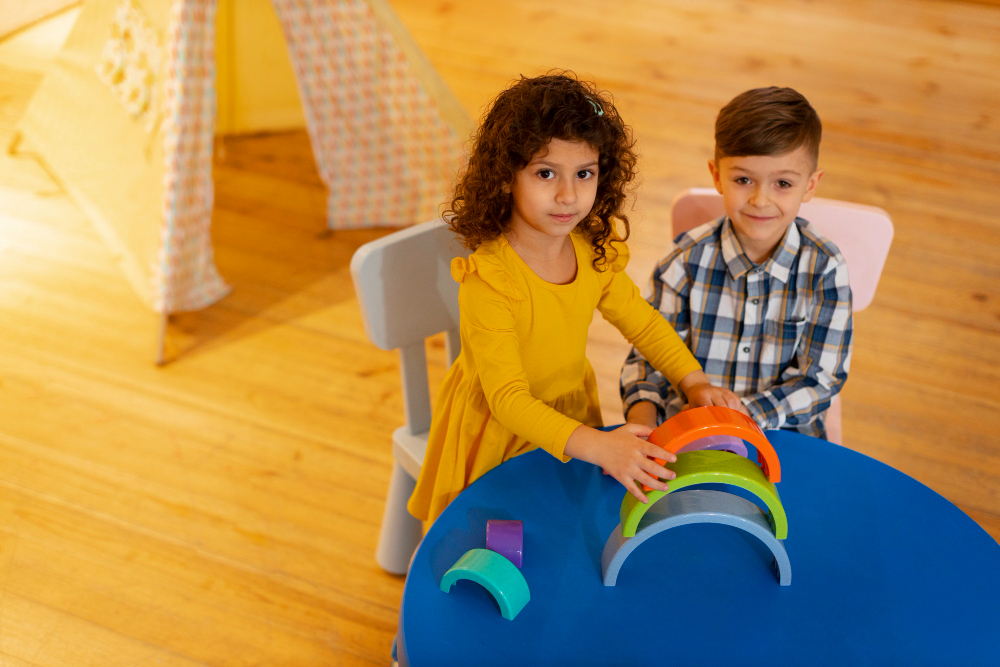
The Importance of Play for Kids; Explained!
When it comes to the mental well-being of children, play is indeed essential. It enables them to dip into the world around them, understand where they are suited, and develop the critical skills they require to flourish. Not only is play an excellent education tool, but likewise a terrific way for households to bond and have fun jointly. However, despite its importance, some parents might struggle to discover the time to let their kids play willingly or might not know how to integrate more play into kids’ routines.
In this post, we’ll delve into the importance of play for kids and why play is so vital during childhood!
What Is Play?
In our day-to-day talks, we toss around the word ‘play’ to cover an entire bunch of stuff we do. Whether it’s shooting hoops, rolling dice, or engaging ourselves in make-believe worlds, we’re all about play. But psychologists and educators get a bit more specific about it.
Play? It’s all about being spontaneous, keeping us on our toes, letting us take the reins, and, of course, having a fun blast.
The Importance of Play for Kids
How children learn, develop, and make sense of the planet near them. So, let’s off-load the importance of play for kids:
Learning Through Play
Did you know that play is one of the most powerful forms of kid’s learning? Whether they’re creating buildings with blocks, forming fantastic worlds with dolls, or pretending to be superheroes, play helps children develop important skills like problem-solving, originality, and essential thinking. It’s like their very own classroom, but way more fun!
Social Skills
Playtime isn’t just about toys and games- it’s likewise about interaction. When kids play jointly, they learn valuable social skills like cooperation, sharing, and compassion. They practice taking turns, negotiating conflicts, and understanding additional viewpoints. These are skills that will serve them well throughout their lives, both in school and beyond.
Physical Health
In today’s world of screens and passive activities, play furnishes a much-needed possibility for kids to get moving and stay active. Whether it’s running around in the backyard, riding bikes with friends, or playing tag at the park, physical play is crucial for evolving motor skills, strength, and coordination. Plus, it helps keep those little bodies healthy and strong.
Emotional Well-being
Play isn’t solely good for kids’ bodies- it’s good for their minds and hearts too. Engaging in play helps kids express their emotions, reduce stress, and build strength. It’s a secure space where they can explore their feelings, work through challenges, and develop confidence in themselves and their abilities.
So, what can you do to promote more play in your child’s life? It’s simple, really- just let them play! Provide them with plenty of prospects for amorphous playtime, both indoors and outdoors. Stock up on toys, games, and art supplies that spark their imagination and creativity. And most importantly, join in the fun! Play with your kids, laugh with them, and cherish these precious moments of childhood magic.
In conclusion, the importance of play for kids is not simply a fanciful pastime- it’s an essential aspect of childhood development. By prioritizing play in your child’s life, you’re giving them the gift of learning, growth, and happiness. So, go ahead, let them play- and watch as they blossom before your eyes.
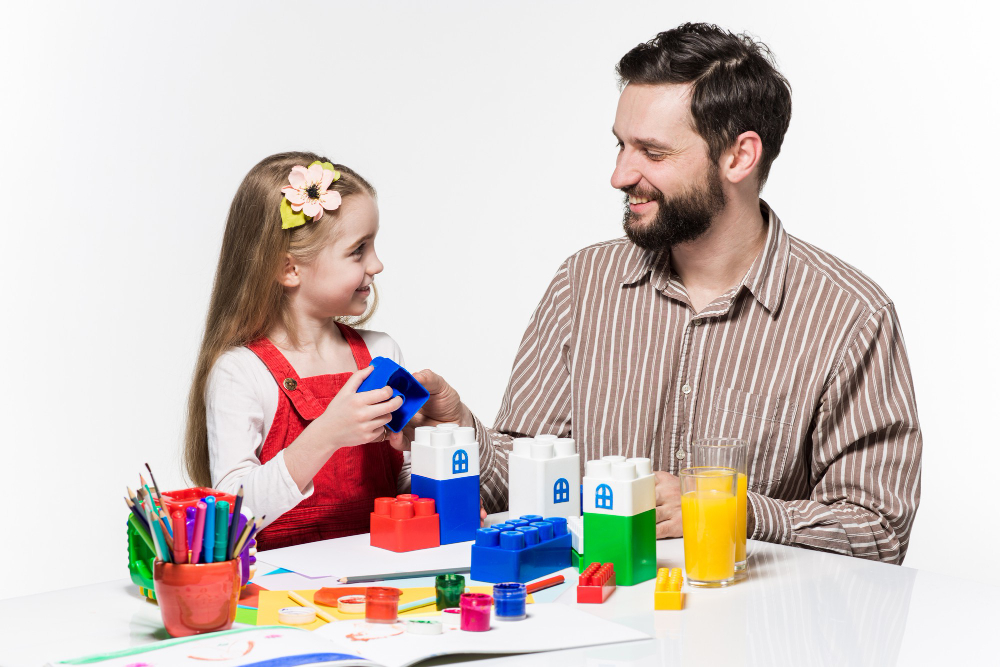
10 Best Parenting Tips for Preschoolers
If you’re reading this, chances are you’re navigating the exciting, albeit challenging, journey of raising a preschooler. As a parent, the endless energy, the barrage of questions, and the constant need for attention can be overwhelming at times. But fear not! With a little patience, love, and some tried-and-true parenting tips, you can foster a nurturing environment that helps your preschooler thrive. So, let’s dive into the 10 best parenting tips for preschoolers:
Establish a Routine
Preschoolers thrive on predictability, so establishing a consistent daily routine can work wonders. From wake-up time to bedtime, try to stick to a schedule for meals, playtime, and other activities. This helps your little one feel secure and know what to expect throughout the day.
Encourage Independence
One of the best parenting tips for preschoolers is encouraging independence. Preschoolers are eager to assert their independence, so give them opportunities to do so! Encourage them to dress themselves, pour their own cereal, and pick out toys to play with. Allowing them to make choices and take on small responsibilities boosts their confidence and fosters a sense of autonomy.
Practice Positive Reinforcement
Praise and encouragement go a long way in shaping your preschooler’s behavior. When they exhibit positive behavior such as sharing or using manners, be sure to praise them for their efforts. Positive reinforcement reinforces good behavior and helps build a strong parent-child bond.
Set Clear Boundaries
While it’s essential to encourage independence, setting boundaries is another best parenting tips for preschoolers. Let your preschooler know what behavior is acceptable and what isn’t, and be consistent in enforcing rules. Consistency helps your child understand expectations and promotes a sense of security.
Promote Emotional Intelligence
Preschoolers are learning to navigate their emotions, so help them develop emotional intelligence by validating their feelings and teaching them healthy ways to express themselves. Encourage them to talk about their feelings and model positive coping strategies like taking deep breaths or using calming techniques.
Foster Creativity
Preschoolers have vivid imaginations, so foster their creativity by providing plenty of opportunities for imaginative play. Stock up on art supplies, encourage storytelling, and engage in pretend play together. Creative expression not only stimulates your child’s imagination but also enhances cognitive development.
Limit Screen Time
While screens can be a convenient distraction, it’s essential to limit your preschooler’s screen time, and is one of the best parenting tips for preschoolers. The American Academy of Pediatrics recommends no more than one hour of high-quality screen time per day for children ages 2 to 5. Instead, encourage active play, reading, and hands-on activities to promote healthy development.
Encourage Exploration
Preschoolers are natural explorers, so encourage their curiosity by providing opportunities for hands-on learning and discovery. Take nature walks, visit museums, and engage in sensory activities that stimulate their senses. Encouraging exploration fosters a love of learning and helps your child develop critical thinking skills.
Practice Patience
Parenting a preschooler can be challenging, but practicing patience is key. Remember that your child is still learning and growing, so try to approach challenging situations with empathy and understanding. Take a deep breath, count to ten if you need to, and respond calmly rather than reacting impulsively.
Make Time for Quality Time
Amidst the hustle and bustle of daily life, don’t forget to carve out quality time to connect with your preschooler. Whether it’s reading a bedtime story, baking cookies together, or simply snuggling on the couch, spending one-on-one time with your child strengthens your bond and creates lasting memories.
These are the ten best parenting tips for preschoolers. Parenting a preschooler is a rewarding journey filled with love, laughter, and endless learning opportunities. So, embrace the adventure, cherish the moments, and remember that you’re doing an amazing job!

How Can Parents Involve Their Families In Fitness?
In the hustle and bustle of daily life, discovering time for family fitness can seem like a challenge. However, incorporating physical activity into your family routine not only promotes a healthy lifestyle but also creates lasting memories. Here are five easy and enjoyable ways for parents to involve their families in fitness.
Create a Family Fitness Challenge
Turn exercise into a friendly competition! Set achievable fitness goals for each family member, such as the number of steps taken in a week or the time spent being active. Create a chart to track everyone’s progress and celebrate achievements together. This not only fosters a sense of accomplishment but also encourages teamwork and motivation.
Outdoor Adventures
Explore the great outdoors as a family. Whether it’s a weekend hike, a bike ride, or a simple game of catch in the backyard, outdoor activities provide a fun and refreshing way to stay active. Choose activities that everyone can enjoy and tailor them to your family’s interests. It’s not just exercise; it’s an adventure!
Make Chores Fun
Housework doesn’t have to be a bore! Turn daily chores into a fitness routine by incorporating movement. For example, crank up the music and dance while cleaning, or challenge each family member to a “speed cleaning” race. Not only does this keep your living space tidy, but it also transforms mundane tasks into lively family moments.
Family Fitness Classes
Joining a fitness class together can be a fantastic way to bond as a family. Look for activities like family yoga, dance, or even martial arts classes. Many communities offer family-oriented fitness options, making it a great opportunity to connect with other families while staying active. Plus, learning new skills together can be both educational and entertaining.
Tech Time with a Twist
Embrace technology in a way that promotes movement. Invest in interactive video games that encourage physical activity, such as those that involve dancing or sports simulations. Turn screen time into a family affair by playing together. Just be mindful of the duration to balance screen time with other activities.
Incorporating fitness into family life doesn’t have to be a chore. By making it fun, interactive, and tailored to your family’s interests, you can create a healthy and active lifestyle that everyone will enjoy. Remember, the goal is not just to get moving but to build lasting connections and foster a love for fitness that will benefit your family for years to come. So, lace up those sneakers, grab your water bottles, and embark on a fitness journey that’s as joyful as it is beneficial!

What You Need To Know About Permissive Parenting?
Permissive parenting is set apart by a surplus of parental devotion and warmth, yet a lack of precise boundaries, rules, and expectations. In this parenting style, kids frequently see their parents more as pals than as authoritative busts. Due to the absence of oversight and control over their activities, children raised by permissive parents may be more prone to exhibit challenging behavior or participate in dangerous activities.
What Is Permissive Parenting?
Permissive parenting, likewise recognized as passive, lax, or lenient parenting, is a style that highlights strong parental consent, responsiveness, and encouragement while providing minimal structure or control. These parents don’t place multiple demands on their kids and apply little punishment. Kids grown by permissive parents might see them as easy-going, indulgent, and delightful. However, this parenting approach falls short of imparting essential life skills such as understanding rules and appreciating authority.
Characteristics of Permissive Parenting
Permissive parents:
- Typically, they show a lot of love and care for their kids.
- They involve their children in important decisions by seeking their opinions.
- The focus is more on granting freedom to their children rather than emphasizing responsibility.
- Regulations and norms of behavior are minimal, and if there are any, they tend to be erratic.
- Sometimes, they might resort to bribery, utilizing toys, gifts, or food to foster good behavior in their child.
- Their approach frequently leans towards being a companion to their kids instead of a standard parent.
- A structured schedule is not a significant part of their parenting style, and consequences for actions are rarely enforced.
Examples of permissive parenting
Now that we’ve discussed the characteristics of this indulgent parenting style, let’s take a look at some examples of permissive parenting to gain a more precise insight:
Example 1:
Imagine: You’re at the regional grocery store with your kid, occupied with a checklist of things to purchase. As you step towards the candy and chocolate passageway, your child expresses a craving for candy, despite having indulged in sweets earlier that day. Despite your awareness of their prior treats, you give in and buy the candy to bypass worrying your child.
Example 2:
At home in the afternoon, following a satisfying lunch, you discover that your child has a school test the next day. Despite the looming test, when your child requests to watch a movie on the iPad, you concede, overlooking the need for studying.
Example 3:
Fantasize you have a teenage daughter who’s just made multiple friends and desires to spend a lot of time with them. She comes to you, telling her plans to go out for dinner with her buddies. Despite already preparing dinner for the family and not being told about her dinner plans, you still grant her approval to go.
Benefits
Permissive parenting creates a nurturing and responsive atmosphere for a child, leading to various potential advantages. Kids brought up in permissive households often develop greater self-assurance as they’re encouraged to express themselves openly. This parenthood approach provides children with more freedom, promoting a feeling of trust to explore and test with new ventures. The lax borders of permissive parenting can likewise enhance a child’s capability to tap into their creativity and follow their desires. In general, kids raised with permissive parenting tend to exhibit robust social skills and heightened self-esteem.
Drawbacks
Opting for a permissive parenting style can come with its share of downsides. The absence of precise boundaries and duties might guide a child towards disruptive behaviors, such as impulsivity and aggression. They may even be prone to forming sick habits linked to sleep, consumption, screen time, and schoolwork due to the lack of rules in these areas. Besides, kids raised by permissive parents may have challenging and selfish behaviors and could be more sensitive to signs of mental health disorders such as anxiety and depression.
Is Permissive Parenting Neglectful
Permissive parenting doesn’t naturally correlate to sloppy parenting. Those who embrace this style actively engage with and react to their kids, never ignoring or neglecting them. Despite being adoring and facilitating, their approach may lean towards leniency and inconsistency in rules and structure. Nevertheless, the downside is that the absence of structured conditions may direct the kids to grow up without a robust sense of self-control and minimal self-discipline.
Permissive parenting is a somewhat familiar trend, but it can have severe long-term outcomes for children. Identifying it early on and making the required changes is vital. Begin with small adjustments at home, and you’ll soon witness considerable improvements in the prevailing situation.

4 Cs of Parenting; Find Out!
Parenting is one of the most rewarding and challenging roles in life. While there’s no one-size-fits-all approach to being a perfect parent, there are certain principles that can guide us in the right direction. These principles can help us provide the best environment for our children to grow, learn, and thrive. In this blog, we’ll explore the 4 Cs of parenting and why they are essential.
Caring
Caring is the cornerstone and one of the 4Cs of good parenting. It involves showing love, affection, and empathy towards your child. It’s more than just providing for their basic needs; it’s about being emotionally present. A caring parent listens to their child, offers comfort, and reassures them during difficult times. This emotional support helps children develop a strong sense of security and self-worth.
Tips for being a caring parent:
- Spend quality time with your child.
- Offer praise and encouragement.
- Be a good listener.
- Show physical affection, like hugs and kisses.
- Create a safe and nurturing environment.
Consistency
Children thrive on routine and predictability. Consistency in parenting helps children understand what to expect and provides a sense of stability. This doesn’t mean you can’t be flexible, but it does mean setting clear expectations and boundaries. When children know the rules and the consequences of their actions, they are better equipped to make good choices.
Tips for being a consistent parent:
- Establish a daily routine.
- Set age-appropriate rules and expectations.
- Follow through with consequences.
- Communicate openly with your child about rules.
Communication
Effective communication is key to understanding your child and helping them express themselves. It’s a two-way street: you need to listen and talk. Encourage your child to share their thoughts, feelings, and concerns. Create an open and non-judgmental space for dialogue. When your child feels heard, they are more likely to come to you with their problems and seek your guidance.
Tips for being a communicative parent:
- Ask open-ended questions to encourage conversation.
- Validate your child’s feelings and opinions.
- Be patient and attentive when they want to talk.
- Use age-appropriate language and explanations.
Control (with Love)
Control in parenting is not about being a strict disciplinarian but about providing structure and guidance. Children need to know the limits and boundaries to feel safe and secure. It’s important to strike a balance between allowing independence and providing guidance. Discipline should always be rooted in love and respect, not punishment.
Tips for being a parent with appropriate control:
- Set clear and reasonable boundaries.
- Use positive discipline techniques, like time-outs or loss of privileges.
- Explain the reasons behind the rules.
- Be a role model for the behavior you expect from your child.
Good parenting is an ongoing journey that involves caring, consistency, communication, and appropriate control. While every family and child is unique, these 4 Cs of good parenting provide a solid foundation for nurturing a healthy parent-child relationship. Remember that no one is a perfect parent, and mistakes happen. What’s crucial is the effort to continuously improve and provide a loving and supportive environment for your child to flourish.

How Much Is Too Much Social Media Use?
In today’s fast-paced digital world, it’s no secret that social media has become an integral part of our lives. Whether it’s scrolling through your Instagram feed, tweeting witty thoughts on Twitter, or catching up with friends on Facebook, it’s hard to imagine a day without a quick peek into the online world. But have you ever stopped to wonder how much is too much when it comes to social media use?
The allure of social media is undeniable. It connects us to friends and family, keeps us informed about current events, and provides endless entertainment. However, it’s essential to strike a balance between digital engagement and the real world. In this blog, we’ll explore the signs of excessive media use and provide some tips on achieving a healthier balance.
Signs of Excessive Social Media Use
You Check Your Phone First Thing in the Morning: If your morning routine includes reaching for your phone to check notifications on various media platforms, it might be a sign of dependency.
Your Screen Time Keeps Increasing: Most smartphones offer screen time monitoring features, which can be a real eye-opener. If your daily average keeps climbing, you might want to reconsider your habits.
It Interferes with Real-Life Relationships: Neglecting in-person interactions in favor of virtual ones is a sign that your social media use might be taking over your life. If your dinner with friends becomes an Instagram photoshoot, it’s time to reassess.
You Feel Anxious or Depressed After Scrolling: Constant exposure to idealized versions of others’ lives can lead to negative self-perception and FOMO (Fear of Missing Out). If scrolling leaves you feeling down, it’s a red flag.
You Can’t Remember the Last Time You Unplugged: If you can’t recall the last time you went an entire day without social media, it might be a good indication that you need to take a step back.
Finding a Healthy Balance:
Set Boundaries: Establish designated “no-phone” times during the day, such as meal times or before bedtime. Stick to them, even if it’s just for an hour.
Limit Notifications: Turn off non-essential notifications to reduce the constant urge to check your phone.
Curate Your Feed: Unfollow or mute accounts that make you feel negative emotions or consume your time needlessly. Your feed should inspire and uplift you.
Engage Actively: Instead of passive scrolling, engage actively with the content. Comment, like, or share posts that truly interest you, and interact with friends.
Use Social Media with Purpose: Define your goals for using social media. Is it to connect with friends, gain knowledge, or showcase your creativity? Knowing your purpose will help you use these platforms more intentionally.
Plan Offline Activities: Make plans for activities that don’t involve screens. Whether it’s hiking, reading a book, or simply spending quality time with loved ones, investing in offline experiences can be incredibly rewarding.
Practice Mindfulness: Be aware of how you feel when using social media. If you notice negative emotions, take a break, and reflect on what’s causing them.
Remember, social media is a tool that can be harnessed for good, but it can also become a source of stress and distraction. It’s up to you to strike a balance that allows you to enjoy the benefits without being consumed by its drawbacks.
In conclusion, the question of how much is too much social media use is a personal one. It varies for each individual. Pay attention to the signs that indicate excessive use and be proactive in finding that sweet spot where social media enhances your life rather than dominating it. Ultimately, your well-being and the quality of your real-life relationships should be the guiding factors in determining the right amount of social media for you.
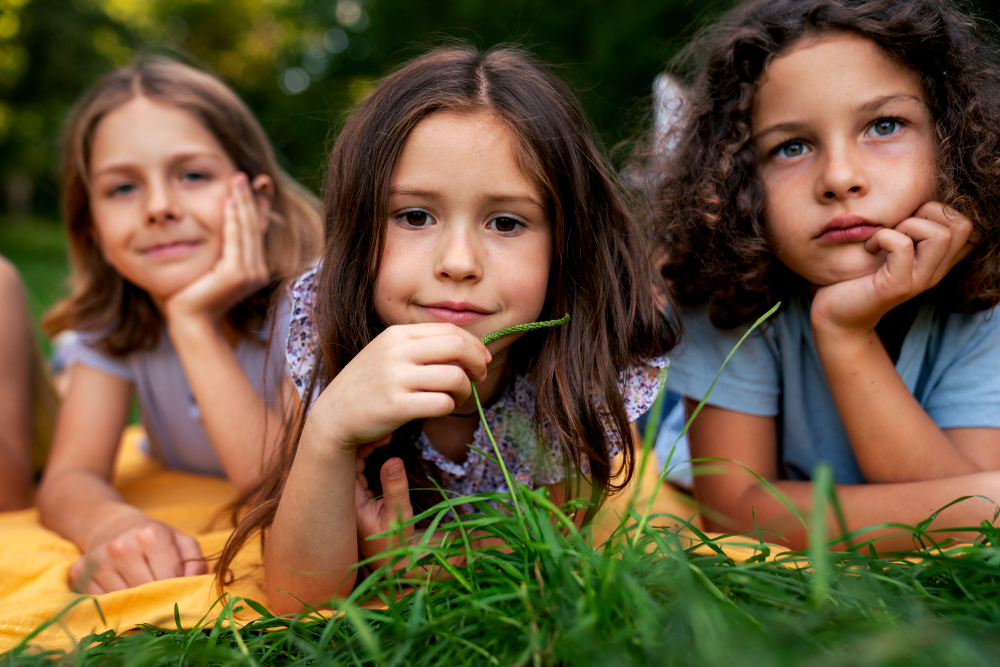
The Nature vs Nurture Child Development
Child development is a fascinating journey that begins the moment a child is born and continues throughout their life. As parents, educators, and caregivers, we often wonder what factors influence a child’s growth and development. The age-old debate of nature vs nurture remains at the forefront of discussions surrounding child development. In this blog, we’ll delve into the key concepts and differences between these two factors and how they shape a child’s growth.
What is Nature?
When we talk about nature in the context of child development, we are referring to the biological and genetic factors that influence a child’s development. These factors are present from the moment a child is conceived and include elements like genes, inherited traits, and temperament.
Genes play a pivotal role in determining a child’s physical and psychological characteristics. They control everything from a child’s hair and eye color to their predisposition to certain health conditions. Some children may be naturally gifted in areas like music, sports, or mathematics due to genetic predispositions.
Temperament is another significant aspect of a child’s nature. It refers to a child’s inherent characteristics such as being introverted or extroverted, resilient, or sensitive. A child’s temperament can affect how they interact with their environment and the people around them.
What is Nurture?
Nurture, on the other hand, encompasses all the environmental influences a child experiences throughout their life. These influences include their family, upbringing, social surroundings, and educational experiences. Nurture plays a vital role in shaping a child’s personality, behavior, and overall development.
Family and caregivers have a profound impact on a child’s upbringing. The way they are raised, the values instilled, and the love and care provided all contribute to a child’s emotional and psychological development.
Social interactions and peer relationships also play a role in nurture. A child’s experiences with friends, teachers, and mentors can shape their social skills, communication abilities, and overall personality.
Education and the learning environment are critical components of nurture. The quality of education a child receives, the opportunities they are exposed to, and the encouragement they receive all influence their cognitive and intellectual development.
The Interaction between Nature Vs Nurture
It’s essential to understand that nature and nurture do not exist in isolation. Instead, they interact and influence each other throughout a child’s development. Genes may predispose a child to certain traits, but it’s the nurturing environment that can either amplify or mitigate these predispositions.
For example, a child may have a genetic inclination towards music, but without exposure to musical instruments and a nurturing environment, that potential may remain untapped. Similarly, a child with a genetic predisposition to a specific health condition may benefit from early interventions and healthcare in a nurturing environment.
The nature vs nurture child development highlights the complex interplay between inherent genetic factors and the environmental influences that shape a child’s growth. In comparison, nature provides the foundation, nurture molds and sculpts a child’s personality, skills, and overall development.
As parents and caregivers, it’s crucial to recognize the significance of both factors and provide a supportive, nurturing environment that fosters a child’s unique potential. By understanding this delicate balance, we can better guide children on their journey of growth and self-discovery, ensuring they reach their full potential. Remember, it’s not a matter of nature vs nurture, but rather how they work together to create the amazing individuals children become.
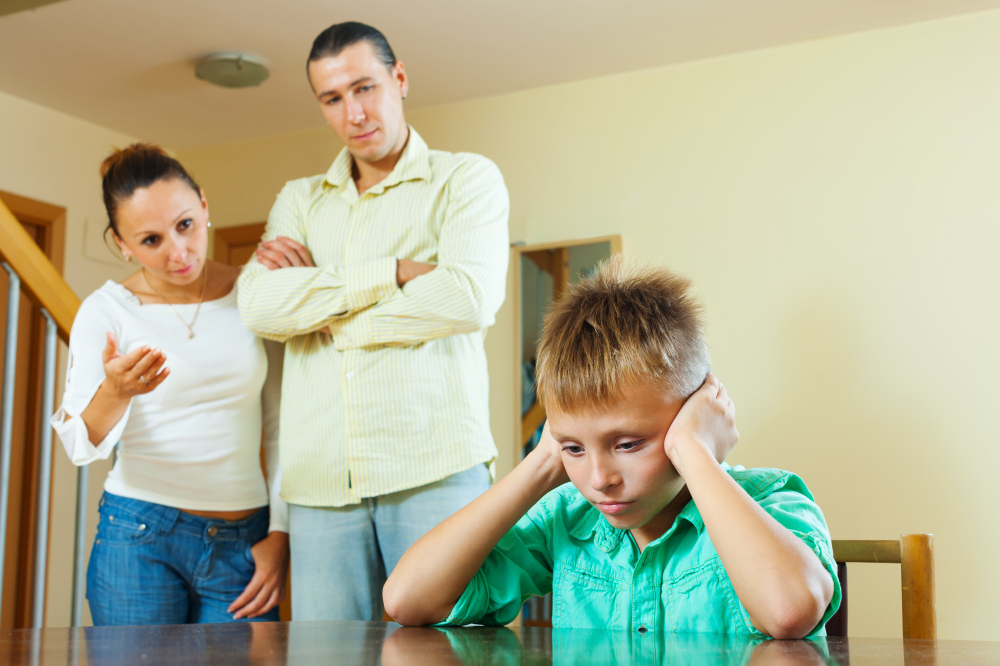
How Parents Can Unintentionally Harm Their Children
Parenthood is undoubtedly one of life’s most challenging and rewarding journeys. As parents, we all want what’s best for our children, but sometimes, despite our best intentions, we can inadvertently harm them. It’s essential to recognize that this harm often stems from love, misunderstanding, or a lack of awareness. In this blog, we’ll explore some common ways parents can unintentionally harm their children and offer suggestions for healthier alternatives.
Overprotection
One of the most well-intentioned but potentially harmful behaviors parents engage in is overprotectiveness. While it’s natural to want to shield your child from harm, being overly protective can stunt their growth and hinder their ability to develop resilience and problem-solving skills. Instead, try to strike a balance between safety and allowing your child to explore and learn from their experiences. Encourage them to take calculated risks and learn from their mistakes.
Unrealistic Expectations
Setting overly high or unrealistic expectations for your child can lead to feelings of inadequacy and low self-esteem. It’s crucial to understand that every child is unique and has their own strengths and weaknesses. Rather than pushing your child to meet your expectations, focus on encouraging their interests and passions and supporting them in their own journey of self-discovery.
Lack of Communication
Communication is the cornerstone of any healthy parent-child relationship. Failing to listen to your child’s thoughts and feelings can make them feel unheard and unvalued. Take the time to engage in open and honest conversations with your child, and show empathy and understanding. This will help them develop trust and emotional intelligence.
Comparisons
Comparing your child to their siblings or peers can be detrimental to their self-esteem and overall well-being. Each child is unique, and comparisons can lead to jealousy, resentment, and a sense of inadequacy. Instead of comparing, celebrate your child’s individual achievements and encourage them to pursue their interests and passions.
Neglecting Self-Care
Parents often prioritize their children’s needs above their own, which is admirable but can lead to burnout and stress. Neglecting self-care can harm your child indirectly as they may feel responsible for your unhappiness. Remember that taking care of your own physical and mental well-being sets a positive example for your child and allows you to be a more present and supportive parent.
Harsh Discipline
Using overly harsh or punitive discipline methods can have long-lasting negative effects on your child’s emotional and psychological well-being. Instead of resorting to punishment, focus on teaching your child about consequences, setting clear boundaries, and using positive reinforcement when they behave well. Encourage them to understand the reasons behind rules rather than just enforcing them blindly.
Ignoring Mental Health
Mental health is just as important as physical health, and ignoring signs of distress in your child can be harmful. Be attentive to changes in behavior, mood, or social interactions that might indicate your child is struggling. Seek professional help if needed and provide a supportive and understanding environment for them to talk about their feelings.
Parenting is a complex and sometimes challenging journey, and no one gets it perfect all the time. However, by being aware of these potential pitfalls and making a conscious effort to avoid them, you can create a more nurturing and supportive environment for your child to thrive. Remember that parenting is a learning experience for both you and your child, and your love and commitment are the most valuable tools you have to help them grow into happy and healthy adults.

How to Deal with a Child Who Hates School
It’s a common scenario for many parents: your child hates going to school. They may complain about it, throw tantrums, or even fake illnesses to avoid going. As a parent, it can be incredibly frustrating and concerning. However, it’s essential to approach this situation with empathy, patience, and a problem-solving mindset. In this blog, we’ll explore some practical tips on how to deal with a child who hates school and help them find joy and motivation in their education.
Understand the Root Cause
The first step in addressing your child’s hesitation toward school is to try to understand the underlying reasons. Sometimes, it’s a specific issue like bullying, difficulty with a particular subject, or a negative experience with a teacher. Start an open and non-judgmental conversation with your child to get to the bottom of their feelings. Listen carefully to their concerns and fears.
Communicate and Offer Support
Once you have a better understanding of why your child dislikes school, let them know that you’re there to support them. Assure them that you value their feelings and want to help. Sometimes, just knowing that they can talk to you about their worries can make a significant difference in how they feel.
Work with Teachers and School Staff
Don’t hesitate to reach out to your child’s teacher or school counselor. They can provide valuable insights into your child’s behavior and academic performance. Together, you can come up with strategies to address specific issues and make school a more positive experience for your child.
Create a Positive Morning Routine
Mornings can be hectic, and a rushed start to the day can set a negative tone. Establish a calm and organized morning routine to make the school day more pleasant. Prepare school bags and lunches the night before, wake up a bit earlier, and ensure your child has enough time for a balanced breakfast.
Explore Different Learning Styles
Sometimes, a child’s dislike for school is related to the way they are taught. Investigate different learning styles and methods that might better suit your child’s needs. Experiment with visual aids, hands-on activities, or alternative resources to make learning more engaging.
Encourage Extracurricular Activities
Participating in extracurricular activities can help your child develop interests outside the classroom, which can make school more appealing. Let them explore different hobbies and activities, such as sports, arts, or clubs, that align with their passions.
Celebrate Small Achievements
Acknowledge and celebrate your child’s successes, no matter how small they may seem. Praise their efforts and achievements to boost their self-esteem and motivation. Positive reinforcement can go a long way in changing their attitude toward school.
Seek Professional Help if Needed
If your child’s hatred for school persists and significantly impacts their well-being, it might be time to seek professional help. A child psychologist or counselor can work with your child to address deeper emotional or psychological issues that may be contributing to their school-related struggles.
How to deal with a child who hates school can be challenging, but with patience, understanding, and proactive steps, you can help your child navigate their academic journey more positively. Remember that every child is unique, and what works for one may not work for another. Be flexible in your approach and always keep the lines of communication open. Ultimately, your unwavering support and dedication will play a crucial role in helping your child develop a more positive attitude toward school.
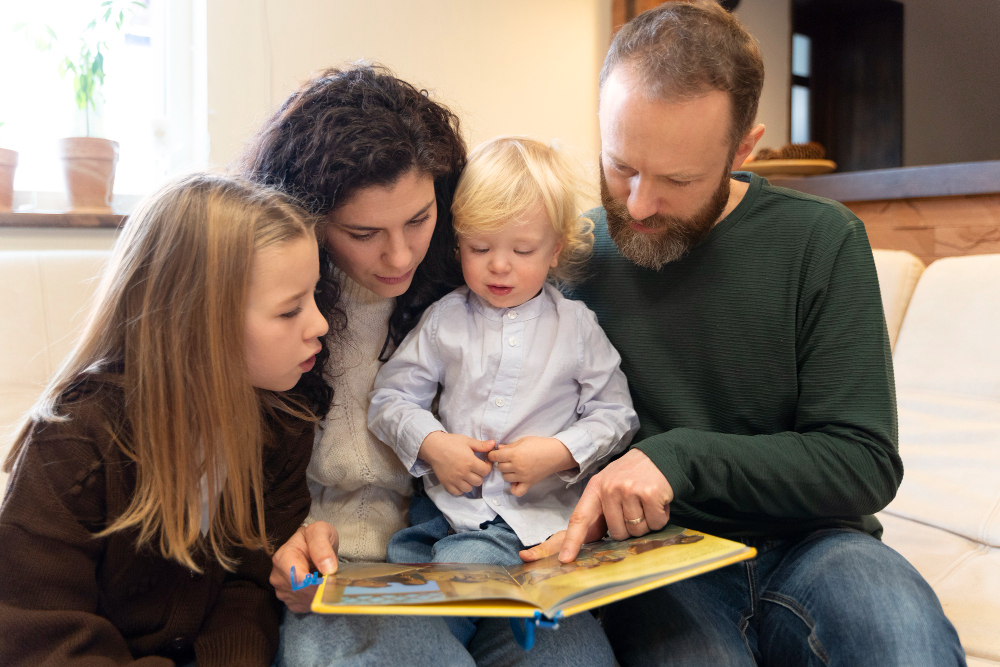
What Are The Golden Rules Of Parenting?
Parenting is an incredible journey filled with love, joy, and sometimes, a fair share of challenges. There’s no one-size-fits-all manual for raising children, but there are some universal principles, often referred to as the “Golden Rules of Parenting,” that can guide you on this amazing adventure. These rules are not set in stone, but they offer valuable insights and strategies to help you nurture your child’s growth and development while maintaining a strong and loving bond.
Love Unconditionally
The foundation of parenting begins with love. Unconditional love is the key to building a secure and confident child and one of the best golden rules of parenting. Show your love through hugs, kisses, words of affirmation, and quality time spent together. Let your children know that your love for them is unwavering, regardless of their behavior or mistakes.
Set Boundaries and Consistency
Children thrive in an environment with clear boundaries and consistent rules. Establish age-appropriate rules and consequences, and enforce them fairly. Consistency helps children understand what is expected of them and provides a sense of security.
Communicate Openly
Effective communication is essential in any relationship, including the parent-child dynamic. Encourage your children to express their thoughts and feelings without fear of judgment. Listen actively, ask open-ended questions, and provide guidance when needed. Be a role model for healthy communication by resolving conflicts peacefully.
Be Patient
Parenting is a long journey filled with ups and downs. Patience is your greatest ally and is one of the best golden rules of parenting. Understand that children make mistakes, learn at their own pace, and may need repeated guidance. Stay calm, take deep breaths, and practice empathy during challenging moments.
Lead by Example
Children often mirror their parents’ behavior. Model the values and behaviors you want your children to adopt. Show them kindness, respect, responsibility, and empathy. Your actions speak louder than words.
Encourage Independence
Foster your child’s independence by allowing them to make age-appropriate choices and decisions. Encouraging independence helps them develop problem-solving skills and a sense of autonomy. Be there to support and guide them as they explore the world.
Prioritize Quality Time
In today’s fast-paced world, spending quality time with your children is more important than ever and is one of the best golden rules of parenting. Create special moments together, such as family dinners, game nights, and outings. These shared experiences strengthen your bond and create lasting memories.
Celebrate Achievements, Big and Small
Celebrate your child’s achievements, whether it’s a small milestone or a significant accomplishment. Acknowledge their efforts and let them know you are proud of them. Positive reinforcement boosts their self-esteem and motivation.
Be Flexible
While consistency is important, it’s also essential to be flexible and adaptable. As your child grows and changes, their needs and challenges will evolve. Be open to adjusting your parenting approach as necessary.
Practice Self-Care
Remember, you can’t pour from an empty cup. Taking care of yourself is not selfish but necessary for effective parenting. Prioritize self-care to maintain your physical and emotional well-being, so you can be the best parent you can be.
Parenting is a lifelong journey filled with learning experiences and unforgettable moments. The Golden Rules of Parenting provide a roadmap to navigate this incredible adventure with love, patience, and wisdom. Keep in mind that there is no one “right” way to parent, and it’s okay to seek support and guidance when needed. Embrace these golden rules as a foundation, and tailor them to your unique family dynamic, ensuring a nurturing and loving environment for your children to flourish.
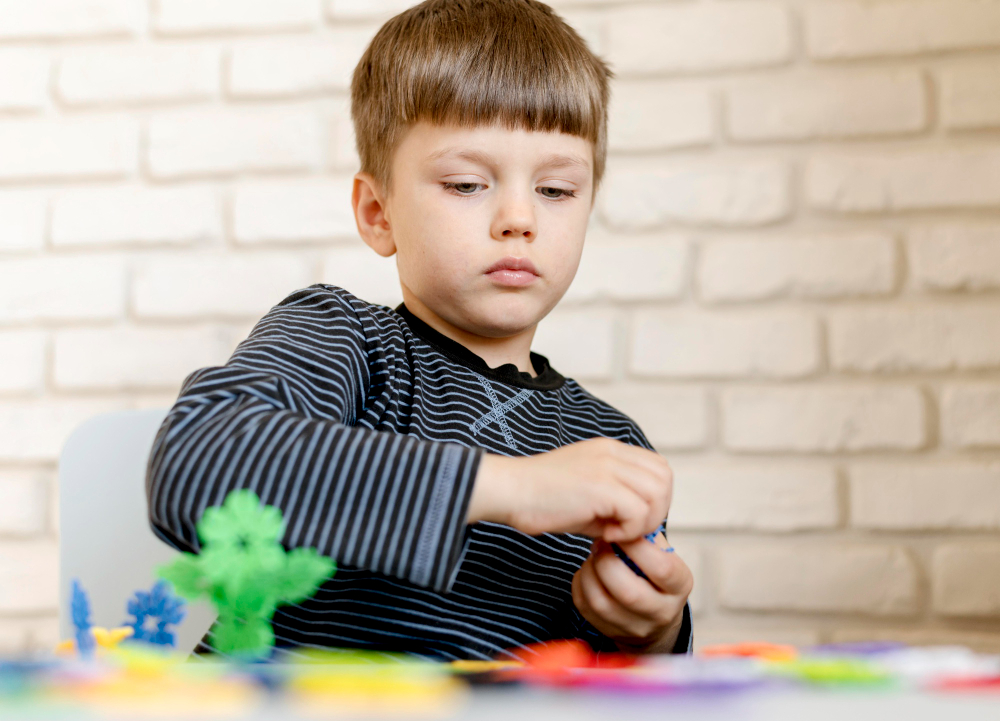
What To Do When You Have An Autistic Child
Bringing up a child is an incredible journey filled with joy, challenges, and countless learning opportunities. When you have a child with autism, that journey becomes uniquely beautiful. Autism, a complex neurological condition, brings its own set of joys and challenges. As a parent, you play a crucial role in helping your child thrive. In this blog, we’ll explore some practical tips and insights on how to bring up an autistic child.
Educate Yourself
Understanding autism is the first step to providing the best support for your child. Take the time to educate yourself about autism spectrum disorder (ASD). Read books, attend workshops, and seek out reputable online resources. Knowledge empowers you to make informed decisions and helps you appreciate your child’s unique perspective.
Embrace Individuality
Every child with autism is unique. Autism is a spectrum, which means it manifests differently in each individual. Instead of trying to fit your child into a mold, celebrate their individuality. Recognize their strengths, interests, and challenges. Embrace the fact that your child is one-of-a-kind.
Build a Support Network
Raising a child with autism can be emotionally and physically demanding. Don’t be afraid to ask for help. Build a strong support network that includes family, friends, teachers, therapists, and support groups. Connecting with others who understand your journey can provide invaluable guidance and emotional support.
Early Intervention is Key
Early intervention services can make a significant difference in your child’s development. If you suspect your child may have autism, seek an evaluation as early as possible. Early intervention programs can help address developmental delays, speech and communication difficulties, and social challenges.
Create a Structured Environment
An autistic child thrives in structured environments. Establish routines and schedules to provide predictability and stability in your child’s life. Visual schedules and timers can be helpful tools to make transitions smoother.
Effective Communication
Communication is a vital skill for both you and your child. Use clear, concise language, and be patient when waiting for a response. An autistic child may use alternative communication methods, such as sign language or augmentative and alternative communication (AAC) devices. Explore what works best for your child and encourage their communication efforts.
Sensory Sensitivities
Many autistic individuals have heightened sensory sensitivities. Pay attention to your child’s sensory preferences and sensitivities. Provide sensory-friendly environments and tools like noise-canceling headphones, weighted blankets, or fidget toys to help them regulate their sensory experiences.
Encourage Social Interaction
Social skills can be challenging for an autistic child, but they can be learned and improved with practice. Encourage social interaction by setting up playdates, joining social groups, or enrolling in social skills training programs. Be patient and understanding as your child navigates social situations.
Celebrate Achievements
Celebrate even the smallest achievements and milestones. Positive reinforcement can boost your child’s confidence and motivation. Praise their efforts, and be their biggest cheerleader.
Self-Care for Parents
Taking care of your child is essential, but don’t forget to take care of yourself too. Parenting can be overwhelming, and it’s okay to seek respite when needed. Prioritize self-care activities that help you recharge and stay mentally and physically healthy.
Bringing up an autistic child is a journey filled with unique challenges and rewards. Remember that autism is just one aspect of your child’s identity, and they have a world of potential waiting to be discovered. By educating yourself, embracing individuality, seeking support, and providing a loving and understanding environment, you can help your child thrive and reach their full potential. Every step you take in this journey is an opportunity for growth and connection with your amazing child.

The Importance of Parenting Styles When Raising Children
Parenting is a journey filled with love, joy, and sometimes, a few challenges along the way. As parents, we all want the best for our children, and one key factor that significantly influences their development is our parenting style. In this blog, we’ll delve into the importance of parenting styles when raising children and how they can shape their future.
Understanding Parenting Styles:
Parenting styles refer to the patterns of behavior, strategies, and attitudes that parents employ while raising their children. These styles are often influenced by our own upbringing, personal beliefs, and cultural backgrounds.
Authoritative Parenting:
Authoritative parents are known for being nurturing and responsive to their children’s needs while also setting clear boundaries and expectations. They provide love and support while encouraging independence. This parenting style is often associated with positive child outcomes, such as high self-esteem, better social skills, and academic success.
Authoritarian Parenting:
Authoritarian parents, on the other hand, tend to be strict and demanding. They have high expectations and rules that children must follow without question. While discipline is important, an excessively authoritarian approach can lead to negative consequences, such as rebellion or low self-esteem.
Permissive Parenting:
Permissive parents are characterized by their leniency and a lack of strict rules. They are often warm and indulgent, allowing their children to make their own choices without many consequences. While this approach can foster independence, it can also lead to behavioral problems and a lack of respect for authority.
Neglectful Parenting:
Neglectful parents are emotionally distant and uninvolved in their children’s lives. They may be neglectful due to their own personal issues or a lack of awareness of their child’s needs. This style can have severe consequences for a child’s emotional and psychological development.
The Impact on Children:
Now that we’ve discussed the four primary parenting styles let’s dive into their impact on children’s development:
- Emotional Well-being: Children raised by authoritative parents tend to have higher self-esteem and better emotional regulation. They feel secure in their parent’s love and guidance.
- Academic Success: Authoritative parenting often leads to children who are motivated and excel academically. They understand the importance of discipline and hard work.
- Social Skills: Children of authoritative parents tend to have better social skills, as they have experienced positive communication and collaboration with their parents.
- Behavioral Problems: Permissive parenting can sometimes lead to behavioral problems in children, as they may lack the structure and boundaries needed to learn self-control.
- Rebellion: Authoritarian parenting can sometimes backfire, leading to rebellion and a strained parent-child relationship.
- Low Self-esteem: Neglectful parenting can result in low self-esteem and feelings of abandonment in children.
In conclusion, parenting styles play a crucial role in shaping our children’s lives. Finding the right balance between love and discipline, setting clear expectations, and being emotionally supportive is essential. Remember that there’s no one-size-fits-all approach to parenting, and it’s okay to adapt your style as your child grows and their needs change. Ultimately, the goal is to raise confident, well-adjusted individuals who can thrive in the world. So, take the time to reflect on your parenting style and its impact on your child’s development, and don’t hesitate to seek support and guidance when needed.

How Kids Can Be Affected By Media Use
In today’s digital age, media surrounds us. From smartphones and tablets to TV screens and video games, it’s hard to escape the constant influx of information and entertainment. While media can be a valuable source of education and entertainment, excessive or inappropriate use can have a significant impact on children’s development. In this blog, we’ll explore how kids can be affected by media use and offer some tips for parents and caregivers to ensure a healthy balance.
Physical Health
Excessive media use can lead to sedentary behavior, which can contribute to health problems like obesity and sleep disturbances. When kids spend too much time in front of screens, they’re less likely to engage in physical activities that are crucial for their growth and well-being. Encouraging outdoor play and setting limits on screen time can help mitigate these effects.
How Kids Can Be Affected By Media Use – Mentally
Media exposure, especially to violent or disturbing content, can impact a child’s mental health. Constant exposure to violence or frightening images can lead to increased anxiety, nightmares, and desensitization to real-world violence. It’s essential to monitor the content your child consumes and have open conversations about what they see online or on TV.
Social Development
Excessive screen time can hinder a child’s social development. When kids spend too much time in front of screens, they have fewer opportunities to interact with peers, develop social skills, and build meaningful relationships. Encourage face-to-face interactions, playdates, and group activities to foster healthy social development.
How Kids Can Be Affected By Media Use – Cognitively
While some educational content can be beneficial, excessive media use can impede cognitive development. It can lead to shorter attention spans, decreased problem-solving skills, and difficulties with critical thinking. Encourage a balance of educational and recreational screen time and engage in activities that promote critical thinking and creativity.
Sleep Disruptions
The use of screens before bedtime can disrupt sleep patterns. The blue light emitted by screens can interfere with the production of melatonin, a hormone that regulates sleep. Establish a bedtime routine that includes turning off screens at least an hour before sleep to ensure your child gets a good night’s rest.
Influence on Behavior and Values
Media has a significant influence on a child’s behavior and values. Kids often imitate what they see on screens, which can include aggressive or inappropriate behavior. Be mindful of the content your child is exposed to and use it as an opportunity to discuss values and behavior expectations.
How Kids Can Be Affected By Media Use – Academic Performance
Excessive media use can lead to poor academic performance. When kids spend too much time on screens, they may neglect their homework, reading, and other educational activities. Create a conducive study environment and set limits on screen time during homework and study hours.
Tips for Parents and Caregivers:
Set Screen Time Limits: Establish clear guidelines for screen time and stick to them. Encourage a healthy balance between screen-based activities and other forms of play and learning.
Monitor Content: Be aware of the content your child is consuming. Use parental controls and content filters to ensure age-appropriate material.
Engage and Communicate: Watch and play with your child. Engage in discussions about the media they consume, helping them process and understand what they see.
Encourage Outdoor Activities: Promote physical activity and outdoor play to counteract the sedentary nature of media use.
Create Tech-Free Zones: Designate areas in your home, such as the dining room or bedrooms, as tech-free zones to encourage family interaction and quality time.
In conclusion, media can be a double-edged sword for kids. While it offers educational and entertainment opportunities, excessive or inappropriate use can have detrimental effects on their physical, mental, and social development. As parents and caregivers, it’s essential to be proactive in guiding your child’s media consumption and fostering a balanced and healthy relationship with technology.

The 10 Timeless Principles of Good Parenting
Parenting can be both a rewarding and challenging journey. While there’s no one-size-fits-all approach to raising children, certain timeless principles of good parenting can serve as a reliable compass to navigate this incredible adventure. Whether you’re a new parent or have years of experience, these timeless principles of good parenting can help you build strong, loving relationships with your children and raise them to become happy, responsible, and well-adjusted adults.
Unconditional Love
At the heart of good parenting lies unconditional love. Your children should always feel loved and accepted, regardless of their actions, achievements, or mistakes. Love provides them with a secure foundation upon which they can build their self-esteem and confidence.
Effective Communication
Effective communication is key to understanding your child’s thoughts, feelings, and needs and is one of the foremost principles of good parenting. Listen actively, ask open-ended questions, and show empathy. Encourage your child to express themselves, and be attentive to their non-verbal cues. Good communication fosters trust and helps resolve conflicts.
Consistency and Boundaries
Children thrive in a structured environment with clear rules and boundaries. Be consistent in your discipline and expectations, and explain the reasons behind your rules. Consistency helps children feel secure and understand the consequences of their actions.
Positive Reinforcement
Praise and positive reinforcement go a long way in motivating children to make good choices and are one of the foremost principles of good parenting. Acknowledge their efforts and achievements, no matter how small. This encourages them to develop a positive self-image and reinforces desired behaviors.
Lead by Example
Children often model their behavior after their parents. Be a role model by demonstrating the values and behaviors you want to instill in your child. Show respect, kindness, and responsibility in your actions, and your child is likely to follow suit.
Patience
Parenting can test your patience, but it’s essential to remain calm and composed when it comes to principles of good parenting. Understand that children will make mistakes and have their own pace of development. Patience allows you to guide them gently through challenges and setbacks.
Quality Time
In today’s busy world, spending quality time with your children is crucial. Set aside dedicated moments for bonding, whether it’s reading a bedtime story, playing games, or having family meals together. These moments create lasting memories and strengthen your connection.
Encourage Independence
As your child grows, encourage their independence and decision-making skills, this is one of the foremost principles of good parenting. Allow them to take on age-appropriate responsibilities and learn from their experiences. Empowering them fosters self-confidence and resilience.
Flexibility
While consistency is important, it’s also vital to adapt to your child’s changing needs and stages of development. Flexibility allows you to adjust your parenting approach to meet their evolving requirements.
Be Present
In the age of smartphones and constant distractions, being present with your child is more important than ever. Put away screens and focus on the here and now when you’re with your child. Show them that they have your full attention and support.
Good parenting is a lifelong journey filled with love, challenges, and growth. By following these timeless principles of good parenting, you can build strong, loving relationships with your children. Remember that no one is a perfect parent, but your dedication to these principles will guide you on the path to raising happy, responsible, and well-adjusted adults.

5 Best Ways to Childproof a Bedroom
As parents, one of our foremost preferences is ensuring the safety and well-being of our kids. When it comes to childproofing our homes, the bedroom is a crucial area to concentrate on. Kids spend a considerable amount of time in their bedrooms, and it’s vital to create a safe atmosphere for them to play and nap. In this blog, we’ll explore the five best ways to childproof a bedroom.
Secure Furniture and Electronics
Children are curious explorers, and they often see furniture and electronics as fascinating climbing challenges. To prevent accidents, secure heavy furniture like dressers, bookshelves, and TVs to the wall using safety straps or brackets. One of the best ways to childproof a bedroom is to ensure electrical cords are out of reach and consider using outlet covers to prevent little fingers from poking into sockets.
Choose Child-Safe Bedding
Opt for bedding materials that are free from harmful chemicals and toxins. Look for mattresses and bedding labeled as “hypoallergenic” or “organic.” Ensure that crib mattresses fit snugly in the crib and that there are no gaps that could trap a child. Avoid using pillows, blankets, or stuffed animals in a crib until the child is old enough to sleep with them safely.
Use Safety Gates
When finding ways to childproof a bedroom, safety gates are a parent’s best friend. Placing gates at the bedroom door or the top of stairs can prevent your little one from wandering into potentially dangerous areas. Make sure the gates are sturdy and securely installed to prevent them from being pushed down.
Keep Small Objects Out of Reach
Children love to put things in their mouths, and small objects can be choking hazards. Regularly check the bedroom floor for tiny items like coins, buttons, or small toys when finding ways to childproof a bedroom. Invest in storage solutions like bins, shelves, and toy chests to keep small items out of your child’s reach. This will also help keep the room tidy and organized.
Install Window Safety Measures
Windows can pose a significant safety risk for children. To prevent falls, install window guards or window stops that limit how far the window can be opened. Ensure that blinds or curtains have no accessible cords that a child could become entangled in. Cordless blinds or curtains with a wand control are safer options.
These are the best ways to childproof a bedroom. Childproofing a bedroom is a crucial step in creating a safe and nurturing environment for your little one. By securing furniture, choosing child-safe bedding, using safety gates, keeping small objects out of reach, and installing window safety measures, you can significantly reduce the risk of accidents and provide your child with a safe space to grow and play. Remember, childproofing is an ongoing process, so regularly assess your child’s environment as they grow and develop new skills. Your child’s safety and well-being are worth the effort.

How to Be a Modern Parent: Balancing Tradition and Innovation
In today’s fast-paced world, parenting has evolved to meet the demands of the digital age. Modern parents face unique challenges and opportunities, from navigating screen time to embracing diverse family structures. In this blog, we’ll explore how to be a modern parent by striking a balance between traditional values and innovative approaches.
Communication is Key
One of the fundamental aspects of modern parenting is open and effective communication. In our tech-savvy era, this means not only talking face-to-face but also understanding the digital landscape. Encourage your child to share their thoughts and feelings while being an active listener. By fostering a safe and open environment, you can navigate issues together, from cyberbullying to peer pressure.
Embrace Technology Wisely
Technology is an integral part of our lives, and as a modern parent, we must guide our children’s digital experiences. Set clear rules and boundaries for screen time, but also be open to exploring educational apps and online resources. Teach your kids about online safety, privacy, and responsible internet use.
Flexibility and Adaptability
A modern parent requires flexibility. As our society evolves, so do family dynamics. Whether you’re a single parent, part of a blended family, or in a non-traditional relationship, it’s crucial to adapt and embrace change. Your love and support are what truly matter.
Quality Time Over Quantity
In the hustle and bustle of daily life, finding quality time with your children can be challenging. A modern parent must prioritize quality over quantity. Be present during activities, engage in their interests, and create lasting memories. It’s not about the number of hours spent together but the impact of those moments.
Lead by Example
Modern parenting involves setting a positive example for your children. Whether it’s demonstrating empathy, practicing kindness, or showcasing a strong work ethic, your actions speak louder than words. Children often mimic the behavior they see in their parents, so strive to be the role models they need.
Encourage Independence
While offering guidance is essential, a modern parent also recognizes the importance of fostering independence. Encourage your children to make decisions, solve problems, and learn from their mistakes. This empowers them to become confident and capable individuals.
Nurture a Growth Mindset
In the modern world, adaptability and lifelong learning are invaluable traits. Encourage a growth mindset in your children by praising their efforts rather than just their achievements. Teach them that setbacks are growth opportunities and that failure is a stepping stone to success.
Prioritize Self-Care
A modern parent often juggles numerous responsibilities, from work to household chores. However, don’t forget to prioritize self-care. Taking care of your physical and mental well-being enables you to be the best parent you can be. Make time for hobbies, exercise, and relaxation.
Seek Support and Community
Modern parenting can be isolating, but it doesn’t have to be. Connect with other parents, join parenting groups, and seek support when needed. Sharing experiences and advice can be incredibly reassuring and beneficial.
Unconditional Love
Last but certainly not least, modern parenting is grounded in unconditional love. Regardless of the challenges and changes that come your way, your love for your child remains constant. Let them know that your support and affection are unwavering.
In conclusion, being a modern parent involves a delicate balance between tradition and innovation. By embracing technology wisely, nurturing open communication, and prioritizing quality time and self-care, you can raise confident, resilient, and empathetic children who are well-equipped to thrive in our ever-evolving world. Remember that there’s no one-size-fits-all approach to parenting, and it’s okay to seek help and adapt as needed. Parenthood is an incredible journey, and with love and intention, you can navigate it successfully in the modern era.

10 Red Flags In Teenage Behavior
Navigating the stormy waters of juvenility can be hard for teenagers and their parents. It’s a time of transition, self-discovery, and propelling boundaries. Nevertheless, it’s likewise a time when some teenagers may exhibit concerning behaviors. As a parent, it’s essential to be mindful of these red flags in teenage behavior to furnish vital support and guidance. So here are ten warning signs or red flags in teenage behavior to watch out for:
Impulsive Isolation
If your once-social teenager unexpectedly withdraws from pals and family, spending most of their time isolated in their space, it could be one of the red flags in teenage behavior of emotional distress.
Drastic Mood Swings
While mood swings are expected in teenagers due to hormonal transformations, intense and prolonged changes in mood can display deeper emotional or psychological problems.
Intense Shifts in Academic Performance
An impulsive drop in grades, lack of interest in school, or missing classes can signal educational troubles or underlying issues like stress or depression, which are the red flags in teenage behavior.
Substance Abuse
Experimentation with drugs or liquor is not strange among teenagers, but when it becomes regular and challenging, it’s time for concern and can be deemed as one of the severe red flags in teenage behavior.
Assertive Behavior
Regular outbursts of rage, physical violence, or intense defiance toward authority figures could indicate underlying anger or emotional problems.
Excessive Screen Time
While technology is an essential part of everyday life, extreme screen time, especially late at night, can negatively affect a teen’s mental health and sleep patterns.
Eating Disorders
Severe changes in eating habits, obsession with body image, or substantial weight loss or gain may be signs of an eating disorder like anorexia or bulimia.
Self-harm or Suicidal Thinking
Any symptoms of self-inflicted injuries, like mowing or burning, or expressing thoughts of self-harm or suicide, should be taken very seriously and need prompt proficient help.
Confidential Behavior
While teenagers inherently aim for privacy, outrageous secretiveness, lying, or hiding activities could be signs of inappropriate behavior.
Peer Pressure and Risky Behavior
If your teen caves to peer pressure and engages in scary behaviors like careless driving, substance abuse, or unprotected sex, it’s a sign of vulnerability.
What to Do:
Identifying these red flags in teenage behavior is just the foremost step. Here’s what you can do:
Open-minded Communication: Create a secure space for your teenager to talk openly about their emotions and experiences.
Seek Professional Help: If you witness any symptoms of self-harm, suicidal thoughts, or severe emotional distress, consult a mental health professional immediately.
Set Boundaries: Establish proper rules and boundaries while respecting their growing independence.
Stay Informed: Keep up with their social circles and be mindful of their companions and activities.
Lead by Example: Standard healthy behaviors and coping mechanisms for managing stress and emotions.
Parenting a teenager is not a straightforward task, but being alert about red flags in teenage behavior can help you provide crucial support and direction during this critical stage of their development. Remember that seeking proficient help when needed is a crucial step in ensuring your teenager’s well-being and forthcoming success.

6 Fun and Educational Science Games for Kids
Learning can be an exciting adventure, especially when it comes to science! Are you a parent or a teacher looking for creative ways to engage your kids in scientific concepts? Well, look no further! In this blog, we’ll explore some fantastic and educational science games for kids that make learning a blast. These games are not only entertaining but also educational, helping your little ones grasp scientific concepts with ease.
The Solar System Adventure
Imagine exploring the vastness of space while learning about our solar system. “The Solar System Adventure” is one of the science games for kids that allows kids to journey through the cosmos, visiting planets, moons, and even asteroids. Along the way, they’ll gather interesting facts about each celestial body, all while having fun on their intergalactic journey.
Chemistry Lab Fun
Turn your kitchen into a virtual chemistry lab with one of the most exciting science games for kids! “Chemistry Lab Fun” allows kids to experiment with basic chemical reactions using safe household items. They can create volcanic eruptions with baking soda and vinegar or make colorful slime by mixing different liquids. This hands-on experience introduces them to the world of chemistry enjoyably and educationally.
Dino Discovery
Embark on a prehistoric adventure with “Dino Discovery.” One of these science games for kids allows them to become paleontologists, digging for dinosaur fossils and learning about different species. By uncovering fossils and assembling dinosaur skeletons, they’ll discover fascinating facts about these ancient creatures and the world they lived in.
Weather Wizards
Understanding the weather has never been more fun! “Weather Wizards” teaches kids about meteorology through interactive gameplay. They can create thunderstorms, make rainbows appear, and even control the wind. As they manipulate weather conditions, they’ll gain valuable insights into how our atmosphere works.
Botany Buddies
If your child is curious about plants and gardening, “Botany Buddies” is one of the perfect science games for kids. It lets kids cultivate virtual gardens, plant seeds, and watch them grow into beautiful flowers and plants. Along the way, they’ll discover the essentials of plant biology and learn about the importance of nurturing the environment.
Animal Adventures
“Animal Adventures” is one of the perfect science games for kids that takes them on a global safari to meet different animals in their natural habitats. By observing these creatures in their element, children can learn about animal behavior, ecosystems, and conservation. It’s a wild and educational journey that fosters a love for wildlife.
These educational science games for kids are not only entertaining but also valuable tools for learning. They allow children to explore scientific concepts in a fun and interactive way, fostering a love for science from an early age. So, whether your child is interested in astronomy, chemistry, paleontology, meteorology, botany, or zoology, there’s a game that can spark their curiosity and make science an adventure they’ll cherish forever. Give these games a try, and watch your child’s interest in science soar to new heights!

A Parent’s Guide to Making Money on Instagram
Hey there, parents! Are you a fan of Instagram? Do you enjoy sharing your family’s adventures, parenting tips, and everyday moments with your followers? Well, did you know that it is easy making money on Instagram? That’s right! In this blog, we’ll walk you through some simple ways to turn your love for Instagram into a source of income.
Find Your Niche for Making Money on Instagram
The first step in making money on Instagram is to find your niche. What’s a niche, you ask? It’s like your special area of interest. It could be anything from parenting, cooking, fitness, or even DIY crafts. When you focus on a specific topic, it’s easier to connect with like-minded people and build a loyal following.
Create High-Quality Content
Now that you have your niche, it’s time to start posting content. But remember, quality is key! Take clear, well-lit photos and write engaging captions. Share your personal stories and experiences related to your niche. People love authentic content, so be yourself!
Grow Your Followers
For making money on Instagram, you’ll need followers. Start by following accounts in your niche, engaging with their content, and using relevant hashtags. Don’t forget to interact with your own followers too! Respond to comments and messages to build a strong and engaged community.
Collaborate with Brands for Making Money on Instagram
Once you have a decent following, brands may start noticing you. They might offer you collaborations to promote their products or services. Make sure the products align with your niche and that you genuinely like them. Your authenticity will shine through in your posts, which is what brands are looking for.
Affiliate Marketing
Affiliate marketing is another way to make money on Instagram. You can promote products you love and earn a commission for every sale made through your unique affiliate link. Just be transparent with your followers and let them know when you’re using affiliate links.
Sponsored Posts
As your Instagram following grows, you can approach brands for sponsored posts. This means they’ll pay you to create content featuring their products or services. Make sure the brand fits your niche and that you disclose when a post is sponsored.
Sell Your Own Products
If you have a talent for creating products or services related to your niche, why not sell them on Instagram? You can set up a shop and promote your items to your followers. It’s a great way to turn your passion into profit.
Stay Consistent For Making Money on Instagram
Consistency is key on Instagram. Try to post regularly and engage with your audience consistently. This will help you maintain and grow your following over time.
Be Patient
Making money on Instagram takes time, so don’t get discouraged if things don’t happen overnight. Keep working on your content, engaging with your followers, and exploring new opportunities.
Stay Safe
Lastly, remember to stay safe on Instagram. Protect your personal information and be cautious when sharing details about your family. Unfortunately, not everyone on the internet has good intentions.
In conclusion, making money on Instagram can be a fun and rewarding endeavor for parents. Find your niche, create quality content, grow your following, and explore various monetization options. With time and dedication, you can turn your Instagram hobby into a source of income while sharing your parenting journey with the world.

Is it Possible To Prevent Morning Sickness During Pregnancy?
Nausea, vomiting, or morning sickness during pregnancy is a frequent and often unpleasant symptom that many expectant mothers encounter in the early stages. Morning sickness can be particularly intense in pregnancies with multiples, such as twins or triplets, because of elevated hormone levels. Numerous factors, including hormones and sensitivity, are believed to contribute to the occurrence of morning sickness during pregnancy.
Raised levels of human chorionic gonadotrophin
Fluctuations in hormones, particularly the heightened levels of human chorionic gonadotropin (hCG) and estrogen have a substantial impact on the onset of morning sickness. These hormonal shifts are most prominent during the initial trimester of pregnancy, coinciding with the period when morning sickness is most prevalent.
Elevated sensitivity to odors
Pregnancy can increase an individual’s sensitivity to smells, causing certain odors that were once bearable or even enjoyable to become nauseating. This heightened sensitivity can be a contributing factor to the experience of nausea and vomiting during pregnancy.
Gastrointestinal changes
During pregnancy, alterations in the gastrointestinal tract can occur, such as delayed gastric emptying and relaxation of the lower esophageal sphincter. These changes may lead to acid reflux and the regurgitation of stomach contents, which can be factors contributing to the sensation of nausea or morning sickness during pregnancy and episodes of vomiting.
Hyperemesis gravidarum
Although morning sickness during pregnancy is typically considered a common aspect, there are instances of severe and persistent nausea and vomiting, a condition known as hyperemesis gravidarum. This condition is more severe and can result in dehydration, electrolyte imbalances, and weight loss. If a pregnant individual is experiencing excessive vomiting throughout the day, has difficulty tolerating any food or liquids, exhibits insufficient urine output or discolored urine, feels severely weak, experiences dizziness, or vomits blood, it is indicative of hyperemesis gravidarum. In such cases, pregnant individuals must seek medical attention for appropriate management and treatment.
Here are a few remedies that can alleviate morning sickness condition:
Nausea or morning sickness during pregnancy is a widespread occurrence, affecting the majority of expectant mothers. While it’s commonly referred to as “morning sickness,” it can actually strike at any time of day. Typically, it sets in around the 12-14 week mark of pregnancy, but for certain individuals, it may persist for several more weeks or even throughout the entire pregnancy. To alleviate these symptoms, here are some recommended remedies that involve adjustments to your diet and lifestyle:
- Ensure you get ample rest because fatigue and tiredness can exacerbate nausea and vomiting.
- Steer clear of spicy, greasy, and overly sweet foods.
- Opt for frequent, small meals that are carbohydrate-rich, such as rice, toast, crackers, potatoes, and bananas.
- Stay well-hydrated, but take sips of fluids rather than consuming large quantities, especially during meals.
- Identify and avoid any scents or sounds that trigger your nausea.
- Consider using ginger, which is known for its beneficial effects, particularly when consumed with food or in the form of ginger candies.
- Opt for comfortable clothing and maintain well-ventilated rooms to enhance your comfort.
- Engage in activities to distract yourself and seek support from your family when needed.
In conclusion, while it may not always be feasible to fully prevent nausea and morning sickness during pregnancy, there are undoubtedly measures expectant mothers can take to alleviate the symptoms and make this period more comfortable. Simple transformations in diet and lifestyle, such as consuming smaller, more frequent meals, avoiding trigger foods, and staying well-hydrated, can go a long way in managing these symptoms.

A Guide to Teaching Black Kids About Racism
Racism is an extremely rooted subject in our community, and we must address it sincerely and frankly with our kids. For Black parents, teaching their children about racism is not just a preference but a need. The talks around racism can be challenging, but they are necessary for providing youthful minds with the ability and strength required to guide a world that is frequently unjust. In this blog post, we will explore effective ways of teaching black kids about racism.
Start Early
The foremost phase of teaching Black kids about racism is to begin early. Kids begin to witness differences in skin color at a very young age, and it’s crucial to provide them with context and knowledge from the beginning. Use age-appropriate books, toys, and media to introduce diversity and multiculturalism into their lives. Honor differences and teach them that everyone deserves respect and kindness, regardless of their skin color.
Use Relatable Examples
When discussing racism with your child, use relatable examples that they can understand. For example, you can use day-to-day situations like sharing toys to explain the concept of fairness and equality. Ask them how they would feel if somebody treated them unfairly because of their skin color, and foster empathy and understanding.
Emphasize Strength and Resilience
When teaching black kids about racism, share some examples of the strength and resilience of Black individuals and communities throughout history. Share stories of Black leaders, activists, and artists who have made significant contributions to society. Emphasize that even in the face of adversity, Black people have achieved remarkable things, and your child can too.
Encourage Questions
Encourage your child to ask questions about racism and be prepared to answer them honestly. It’s essential to create a safe space where your child feels comfortable discussing their thoughts and feelings about racial issues. Be patient and provide age-appropriate explanations, ensuring that your child understands that racism is about discrimination and prejudice, not innate characteristics.
Address Stereotypes
Discuss racial stereotypes and how harmful they can be. When teaching black kids about racism, allow them to recognize and challenge stereotypes when they encounter them. Help them understand that stereotypes are unfair generalizations that do not represent the diversity and complexity of individuals from any racial or ethnic group.
Explore Cultural Heritage
Praise your child’s cultural heritage and help them embrace their identity. Teach them about their family’s history, traditions, and customs. Understanding their cultural background can empower your child and help them develop a strong sense of self.4
Promote Inclusivity
Encourage your child to be inclusive and to stand up against racism when they witness it. When teaching black kids about racism also tells them the importance of being allies to others who face discrimination. Emphasize that making the world a more just and equitable place is a collective effort.
Model Anti-Racist Behavior
Children learn by example, so it’s crucial to model anti-racist behavior in your own life. Show your child that you are committed to fighting racism through your actions, words, and choices. This consistency will reinforce the values you are instilling in them.
Teaching Black children about racism is an ongoing process that requires patience, empathy, and open communication. By beginning early, providing relatable examples, and fostering a sense of cultural pride, you can equip your child with the knowledge and resilience required to confront racism and discrimination in the world. Remember that you are not alone in this journey, and there are resources and communities available to support you and your child along the way. Together, we can work towards a more inclusive and equitable society for all.

Easy & Simple Yes Or No Questions To Ask Your Kids
Having meaningful conversations with your children is a fantastic method to strengthen your connection and gain deeper insight into their thoughts and passions. An excellent approach to initiating these conversations is by posing uncomplicated yes-or-no inquiries. Such questions are straightforward for kids to respond to and can pave the way for more profound conversations. In this piece, we’ll furnish you with an extensive collection of simple yes or no questions to ask your kids. Whether you’re in search of amusing questions, questions regarding the natural world, or questions tied to their beloved pastimes, we’ve got you completely covered.
Here are simple yes or no questions to ask your kids:
- Have you ever dreamed of going on a magical adventure?
- Would you like to learn how to cook your favorite meal?
- Can you imagine what it’s like to be a superhero for a day?
- Is watching a beautiful sunset your favorite way to end the day?
- Do you enjoy getting lost in the pages of a good book?
- Can you create a masterpiece with your crayons and paper?
- Would you like to explore the mysteries of outer space?
- Do you think animals can understand our feelings?
- Have you ever wished you could have a pet dragon?
- Is scoring a winning goal the best feeling in the world?
- Do you believe you can be anything you want when you grow up?
- Would you like to know how the universe works?
- Have you ever wondered what it’s like to explore the depths of the ocean?
- Can music make you feel different emotions?
- Would you go on a quest to find hidden treasure if you could?
Encouraging conversation with your children through these simple yes or no questions to ask your kids can offer a window into their likes, passions, and viewpoints. Be sure to actively listen and prompt them to expand on their responses. Relish these conversations as chances to forge a stronger bond with your kids, all while having an enjoyable time together.

These 20 Smartest Animals In The World Will Blow Your Mind
The animal kingdom is a treasure trove of fascinating creatures, each with its unique set of abilities and intelligence. While we often associate intelligence with humans, many animals exhibit remarkable cognitive skills that can leave us in awe. In this blog, we’ll embark on a journey to discover the 20 smartest animals in the world. From problem-solving parrots to tool-using octopuses, the animal kingdom is full of surprises that will truly blow your mind!
Dolphins

Dolphins come number one on the list of smartest animals in the world. Dolphins are known for their sophisticated communication skills, using a complex system of clicks and whistles to convey messages and even names among themselves.
Chimpanzees

Chimpanzees share 98% of their DNA with humans, making them our closest relatives in the animal kingdom. They exhibit remarkable problem-solving abilities and use tools to obtain food.
Elephants

Elephants possess an impressive memory and can remember the locations of water holes and complex social structures within their herds, thus making them one of the smartest animals in the world.
Border Collies – The Genius Dogs

Border Collies are often considered the smartest dog breed and one of the smartest animals in the world. They excel in agility, obedience, and problem-solving tasks, making them outstanding working dogs.
Ravens

Ravens are renowned for their problem-solving skills and have been observed using tools and even cooperating with other ravens to achieve their goals.
Octopuses

Octopuses are not only masters of camouflage but also excel at opening jars, solving mazes, and escaping from enclosures, showcasing their exceptional problem-solving abilities.
African Grey Parrots

African Grey Parrots are famous for their ability to mimic human speech, but they also possess advanced problem-solving skills and a keen sense of observation.
Pigs

Pigs are highly intelligent animals that can learn tricks, solve puzzles, and even play video games. They have excellent memories and can adapt to new environments, that’s the reason they are on the list of smartest animals in the world.
Rats

The Tiny Problem Solvers Rats have demonstrated impressive problem-solving abilities in lab experiments, which have helped us better understand their cognitive capabilities.Cephalopods

Cephalopods, including cuttlefish and squids, are renowned for their ability to adapt rapidly to changing environments and are skilled hunters that’s the reason why they are on the list of smartest animals in the world.
New Caledonian Crows

New Caledonian crows are exceptional tool users, creating intricate tools to obtain food, such as using sticks to extract insects from tree bark.
Bonobos

Bonobos are highly intelligent and share many cognitive abilities with chimpanzees. They are known for their peaceful and cooperative social behaviors.
Bees

Honeybees exhibit complex navigation skills and excellent memory, allowing them to locate food sources and communicate with their fellow hive members through intricate dances.
Squirrels

Squirrels are expert problem solvers, using their memory and problem-solving abilities to hide and retrieve their food caches that’s the reason they are on the list of smartest animals in the world.
Orcas

Orcas, also known as killer whales, are highly intelligent marine mammals that hunt in coordinated packs, using complex communication and problem-solving strategies.
Ants

Ants may be tiny individually, but collectively, they form highly organized colonies that demonstrate impressive problem-solving abilities.
Raccoons

Raccoons have adapted to urban environments, showcasing their problem-solving skills as they navigate complex human-made obstacles to find food that’s the reason they are on the list of smartest animals in the world.
Hyenas

Hyenas are skilled hunters with complex social structures and cooperative hunting tactics, demonstrating their intelligence and adaptability.
Eleonora’s Falcons

Eleonora’s falcons are migratory birds that exhibit impressive navigation skills during their long journeys across continents.
Manta Rays

Manta rays have demonstrated remarkable learning abilities, remembering individual divers and even seeking their assistance when in need.
The world is teeming with intelligent and awe-inspiring animals, each with its unique talents and cognitive abilities. From the problem-solving prowess of dolphins and chimpanzees to the tool-using skills of crows and octopuses, these 20 smartest animals in the world remind us of the incredible diversity and complexity of life on Earth. As we continue to explore and understand the animal kingdom, we uncover even more evidence that intelligence is not limited to humans and that the natural world is full of extraordinary minds waiting to be discovered.

What You Need To Know About RSV Symptoms in Kids
As a parent or guardian, it’s imperative to be well-informed about standard childhood illnesses and their symptoms. Respiratory Syncytial Virus (RSV) is one such infection that can affect children, particularly infants and toddlers. Understanding RSV symptoms in kids is essential for convenient diagnosis and cure. Throughout this blog, we will discuss what RSV is, its symptoms in children, and prevention measures.
What is RSV?
RSV – Respiratory Syncytial Virus is a common respiratory virus that can impact people of all ages, but it’s most concerning for infants and young children. RSV is highly infectious and usually spreads through respiratory droplets when an infected person coughs or sneezes. It typically circulates during the fall and winter months, making it a prevalent concern for parents during these seasons.
Common RSV Symptoms in Kids
RSV can emulate the signs of the common cold or flu in older children and adults. Nonetheless, in infants and young children, RSV can lead to more severe respiratory symptoms. Here are the specific RSV symptoms in kids:
Coughing and Sneezing: Children with RSV usually have a persistent cough and may sneeze frequently.
Runny or Stuffy Nose: RSV can cause nasal congestion, leading to a runny or stuffy nose.
Fever: A low-grade fever is expected in RSV-infected children, but some may have higher fevers.
Wheezing: Wheezing, a high-pitched whistling sound when breathing, RSV symptoms in kids cases. It can be a sign of lower respiratory tract involvement.
Rapid Breathing: Infants with RSV may breathe more rapidly than usual, and their nostrils may flare with each breath.
Difficulty Breathing: In severe cases, RSV can cause significant breathing difficulties, including retractions (sucking in the chest muscles), which require immediate medical attention.
Irritability and Reduced Activity: Infants and young children with RSV may become fussier than usual and have decreased activity levels.
Loss of Appetite: RSV can lead to a reduced appetite in children, which can result in dehydration if not managed properly.
Blue Lips or Nails: This is a rare but serious symptom of severe RSV infection and requires immediate medical attention.
Preventing RSV Infections
Preventing RSV infections is vital, especially for high-risk children. Here are some preventive measures you can take:
Handwashing: Frequent handwashing is the first line of defense against RSV or RSV symptoms in kids and other contagious illnesses.
Avoiding Close Contact: Keep sick individuals away from babies, and limit close contact with anyone showing symptoms.
Cough and Sneezing Etiquette: Teach children to cover their mouths and noses when coughing or sneezing.
Vaccination: While there is no RSV vaccine, pregnant women can receive a vaccine called Synagis, which can reduce the severity of RSV in newborns.
Good Hygiene Practices: Disinfect frequently touched surfaces, and avoid sharing items like cups and utensils.
Respiratory Syncytial Virus can cause mild to severe symptoms in children, particularly in infants and those with underlying health conditions. Being aware of RSV symptoms in kids, its risk factors, and prevention strategies is essential for protecting your child’s health. If your child exhibits severe symptoms or has risk factors for severe RSV, consult a healthcare professional promptly. With the right knowledge and precautions, you can help keep your child healthy and safe from RSV and other contagious illnesses.

5 Sleeping Tips for Teething Babies
As a new mom, you’re likely to encounter a flood of parenting advice that can be overwhelming. Your little one might experience considerable discomfort during teething, leading to disruptions in their sleep patterns. Consequently, we would like to share some valuable tips to help teething babies get a good night’s sleep.
Make Sure The Baby Has Something Cold To Chew On
Cold has the ability to desensitize nerves, thereby diminishing pain sensation. This is why in recent times, many toy manufacturers have begun producing teethers with rubber or gel-core components that can be placed in the refrigerator. These teethers are specially designed for teething babies and are intended to be gnawed upon. The act of a baby chewing on these teethers exerts gentle pressure on their emerging teeth, offering them relief from the discomfort associated with teething. The inclination to chew as a means of alleviating teething pain is an instinct shared by both humans and animals.
Massage The Gums
When your baby begins teething, they may resist sleeping alone. When you place your baby in their crib, try gently massaging their gums with your finger. This soothing touch can alleviate discomfort and assist in getting your baby to sleep. If your baby wakes up during the night, you can repeat the gum massage. As you massage your baby’s gums, you’ll be able to sense where their new teeth are emerging. Concentrate on massaging these specific areas. It’s essential to ensure that your fingers are clean before massaging your baby’s gums for hygiene and comfort.
Create A Peaceful Atmosphere
Establishing a consistent sleeping schedule is crucial for helping your baby get a good night’s sleep. When babies have a regular sleep routine, their bodies adapt accordingly. A bedtime ritual can naturally induce drowsiness as bedtime approaches. It subliminally communicates that it’s time to sleep when specific activities are carried out in a predictable sequence, much like the way habits are formed. This routine might encompass elements such as giving your baby a warm bath, changing into pajamas, reading a brief story, singing to your baby, or gently rocking them in your arms until they drift off to sleep.
Breastfeed Is A Great Option For Teething Babies
Breastfeeding has a calming effect on your baby. However, as teething babies, they may sometimes nibble on your nipples, which can be uncomfortable or painful for you. To avoid this, consider massaging your baby’s gums before each feeding session. Breastfeeding remains an effective method for soothing your baby and helping them drift off to sleep peacefully.
Use Pain-killing Prescription
Only consider this option as a last resort if you’ve exhausted all other methods without achieving any improvement. Pain relievers can be effective in easing your baby’s discomfort and helping them sleep. However, it’s imperative to consult with your doctor before considering medication. Avoid purchasing over-the-counter pharmaceutical products for this purpose. Pain relievers like Ibuprofen are available in specially formulated, diluted versions designed specifically for children and infants. Never administer adult pain relievers to your baby. Always seek guidance from your pediatrician before giving any medication to your little one.
In conclusion, navigating the challenging waters of teething with a baby requires patience, understanding, and a few clever tricks up your sleeve. The five sleeping tips for teething babies outlined in this blog post offer a lifeline for exhausted parents, helping both little ones and caregivers get the rest they need during this trying time.

How to Stop Leaky Breasts
Life is a ravishing journey filled with many incredible milestones, and one of the most magical experiences is becoming a mother. However, this journey can also bring unexpected challenges, and one of them is dealing with leaky breasts. While it may not be a topic commonly discussed in everyday conversation, it’s a very real and common occurrence for many new moms. In this blog, we’ll delve into what causes leaky breasts and provide practical tips on how to manage and cope with this natural phenomenon.
Understanding the Why
Before we jump into solutions, let’s explore why leaky breasts happen in the first place. Leaky breasts are a natural part of the postpartum journey, primarily due to hormonal fluctuations. When you’re pregnant, your body starts preparing for breastfeeding by increasing the production of prolactin, the hormone responsible for milk production. However, it’s not until after childbirth that milk production fully kicks in, and that’s when leaky breasts often make their debut.
Invest in Nursing Pads
One of the first things you’ll want to do to manage leaky boobs is to invest in nursing pads. These handy little pads are designed to fit inside your bra and absorb any leaked breast milk, keeping your clothing dry and comfortable. They come in disposable and reusable options, allowing you to choose what works best for you and the environment.
Wear a Supportive Bra
Wearing a comfortable and supportive bra is crucial for managing leaky breasts. Look for bras designed specifically for nursing mothers. They often have convenient features like easy-to-open clasps for breastfeeding and extra padding to help conceal any leakage. A well-fitting bra can also help alleviate some of the discomfort that can come with engorged breasts.
Practice Good Breast Hygiene
Maintaining good breast hygiene is essential when dealing with leaky breasts. Ensure that you clean your breasts daily with warm water and mild soap, and gently pat them dry. Avoid using harsh chemicals or fragrances near your breasts, as these can irritate your skin.
Nursing on Demand
Frequent breastfeeding or pumping can help alleviate breast fullness and reduce leakage. Nursing your baby on demand helps regulate your milk supply and can be a natural way to reduce the chances of leakage.
Engage in Breastfeeding Techniques
Learning proper breastfeeding techniques can also help you manage leaky breasts. Consider reaching out to a lactation consultant for guidance on ensuring a proper latch, which can reduce the chances of milk leakage during feeds.
Stay Hydrated and Maintain a Healthy Diet
Your body requires extra hydration and nutrients while breastfeeding, so it’s essential to stay well-hydrated and maintain a balanced diet. A well-nourished body is better equipped to handle the demands of milk production.
Express Excess Milk
If you find that you have an oversupply of milk and are experiencing significant leakage, consider expressing excess milk between feedings using a breast pump. This not only helps manage the issue but also allows you to build a milk stash for later use.
Leaky breasts are a natural and temporary part of the breastfeeding journey for many new moms. While they can be surprising and even a bit inconvenient at times, there are practical steps you can take to manage and cope with them. Remember that this phase will pass as your body adjusts to the demands of breastfeeding, and in the meantime, take comfort in the beautiful bond you’re creating with your little one through this incredible journey of motherhood.

How to Fight Pregnancy Fatigue Naturally
As you go through pregnancy, it becomes more important to learn how to fight pregnancy fatigue naturally. As your body undergoes incredible changes to nurture and grow your baby, it’s natural to feel tired at times. However, there are plenty of natural ways to fight pregnancy fatigue and boost your energy levels. In this blog, we’ll explore some effective tips to help expecting moms feel more refreshed and energized during this exciting time in their lives.
Prioritize Sleep
Getting enough rest is crucial during pregnancy. Hormonal changes, discomfort, and the need for more frequent trips to the bathroom can disrupt your sleep. To combat this, create a soothing bedtime routine. Try using pillows for support, sleep on your left side to improve blood flow to your baby, and keep your room dark and quiet.
Stay Hydrated
Dehydration can contribute to fatigue, so make sure you’re drinking enough water when trying to fight pregnancy fatigue naturally. Carry a reusable water bottle with you throughout the day, and consider infusing your water with slices of lemon or cucumber for a refreshing twist.
Balanced Nutrition
Eating a well-balanced diet can go a long way in combating pregnancy fatigue. Focus on whole foods, lean proteins, fruits, vegetables, and whole grains. These foods provide essential nutrients and steady energy throughout the day. Avoid sugary snacks, which can lead to energy crashes.
Frequent, Small Meals
Instead of three large meals, opt for smaller, more frequent meals and snacks when trying to fight pregnancy fatigue naturally. This can help stabilize your blood sugar levels and keep your energy levels consistent. Include healthy snacks like nuts, yogurt, or fruit to curb hunger and maintain energy.
Exercise Regularly
While it may seem counterintuitive, light to moderate exercise can actually boost your energy levels during pregnancy. Activities like prenatal yoga, swimming, or walking can improve circulation and help you feel more invigorated. Always consult with your healthcare provider before starting a new exercise routine.
Listen to Your Body
Pregnancy is not the time to push yourself to the limit when trying to fight pregnancy fatigue naturally. If you’re feeling exceptionally tired, allow yourself to rest. Even a short nap or a few moments of relaxation can recharge your batteries.
Stress Reduction Techniques
Stress can exacerbate fatigue, so it’s important to find ways to manage it. Meditation, deep breathing exercises, and prenatal massage can help alleviate stress and promote relaxation.
Iron-Rich Foods
Iron deficiency can contribute to pregnancy fatigue, so include iron-rich foods in your diet when trying to fight pregnancy fatigue naturally. Leafy greens, lean meats, and fortified cereals can help boost your iron levels.
Stay Connected
Share your feelings and experiences with your partner, friends, and family. Emotional support can be a powerful energy booster during pregnancy.
Prenatal Vitamins
Consult with your healthcare provider to ensure you’re taking the appropriate prenatal vitamins. These supplements can fill in nutritional gaps and help combat fatigue.
Pregnancy fatigue is a common and expected part of the journey, but it doesn’t have to dominate your experience. By prioritizing rest, nourishing your body with the right foods, staying active, and managing stress, you can fight pregnancy fatigue naturally and enjoy this remarkable time in your life to the fullest. Remember, every pregnancy is unique, so it’s essential to listen to your body and seek guidance from your healthcare provider when needed. Embrace this beautiful journey, and take care of yourself along the way.

